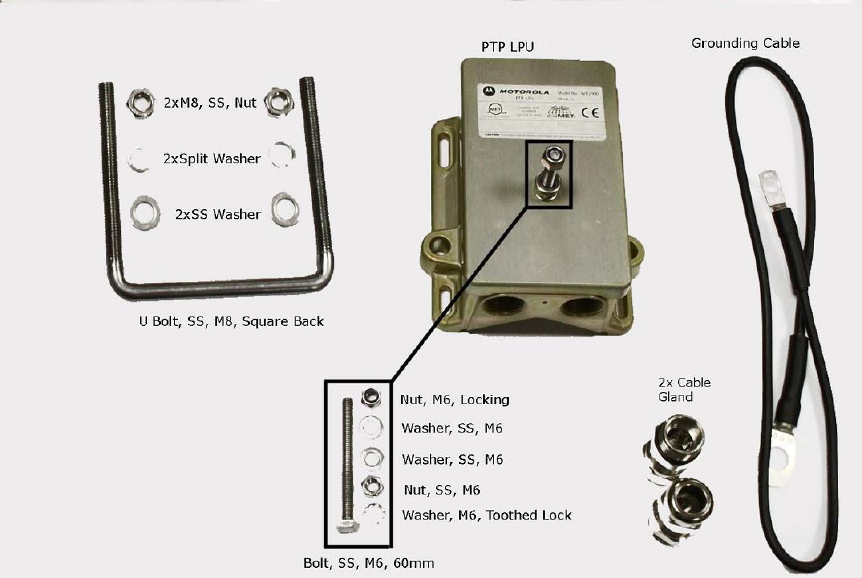Cambium Networks 58250 PTP250 Point to Point Broadband Wireless System User Manual PTP 250 User Guide
Cambium Networks Limited PTP250 Point to Point Broadband Wireless System PTP 250 User Guide
user manual

PTP 250
phn-2182_002v000
User Guide
System Release 250-01-00
© 2011 Motorola Solutions, Inc. All Rights Reserved.

phn- 2 182_002v 000
May 2011
Accuracy
While reasonable efforts have been made to assure the accuracy of this document, Motorola Solutions, Inc. assumes
no liability resulting from any inaccuracies or omissions in this document, or from use of the information obtained
herein. Motorola Solutions, Inc. reserves the right to make changes to any products described herein to improve
reliability, function, or design, and reserves the right to revise this document and to make changes from time to time
in content hereof with no obligation to notify any person of revisions or changes. Motorola Solutions, Inc. does not
assume any liability arising out of the application or use of any product, software, or circuit described herein; neither
does it convey license under its patent rights or the rights of others. It is possible that this publication may contain
references to, or information about Motorola products (machines and programs), programming, or services that are
not announced in your country. Such references or information must not be construed to mean that Motorola intends
to announce such Motorola products, programming, or services in your country.
Copyrights
This document, Motorola products, and 3rd Party Software products described in this document may include or
describe copyrighted Motorola and other 3rd Party supplied computer programs stored in semiconductor memories or
other media. Laws in the United States and other countries preserve for Motorola, its licensors, and other 3rd Party
supplied software certain exclusive rights for copyrighted material, including the exclusive right to copy, reproduce in
any form, distribute and make derivative works of the copyrighted material. Accordingly, any copyrighted material of
Motorola, its licensors, or the 3rd Party software supplied material contained in the Motorola products described in
this document may not be copied, reproduced, reverse engineered, distributed, merged or modified in any manner
without the express written permission of Motorola. Furthermore, the purchase of Motorola products shall not be
deemed to grant either directly or by implication, estoppel, or otherwise, any license under the copyrights, patents or
patent applications of Motorola or other 3rd Party supplied software, except for the normal non-exclusive, royalty free
license to use that arises by operation of law in the sale of a product.
Restrictions
Software and documentation are copyrighted materials. Making unauthorized copies is prohibited by law. No part of
the software or documentation may be reproduced, transmitted, transcribed, stored in a retrieval system, or
translated into any language or computer language, in any form or by any means, without prior written permission of
Motorola Solutions, Inc.
License Agreements
The software described in this document is the property of Motorola Solutions, Inc. and its licensors. It is furnished by
express license agreement only and may be used only in accordance with the terms of such an agreement.
High Risk Materials
Components, units, or 3rd Party products used in the product described herein are NOT fault-tolerant and are NOT
designed, manufactured, or intended for use as on-line control equipment in the following hazardous environments
requiring fail-safe controls: the operation of Nuclear Facilities, Aircraft Navigation or Aircraft Communication
Systems, Air Traffic Control, Life Support, or Weapons Systems (High Risk Activities). Motorola and its supplier(s)
specifically disclaim any expressed or implied warranty of fitness for such High Risk Activities.
Trademarks
MOTOROLA and the Stylized M Logo are registered in the US Patent & Trademark Office. All other product or service
names are the property of their respective owners.

Sa fe ty
an d
Regu lat ory
phn- 2182_002v000
May 2011 I
Sa fet y a nd regulat ory inform at ion
. . . . . . . . . . . . . . . . . . . . . . . . . . . . . . . . . . . . . . . . . . . . . . . . . . . . . . . . . . . .
.
.
.
.
This section describes important safety and regulatory guidelines that must be
observed by personnel installing or operating PTP 250 equipment.
I m port ant safet y inform at ion
WARNING
To prevent loss of life or physical injury, observe the safety guidelines
in this section.
Pow er line s
Exercise extreme care when installing antennas near power lines.
W ork ing at he ight s
Exercise extreme care when working at heights.
Grounding and pr ot e ctive e a rt h
The Outdoor Unit (ODU) must be properly grounded to protect against lightning. It is
the user’s responsibility to install the equipment in accordance with national
regulations. In the USA, follow Section 810 of the
National Electric Code, ANSI/NFPA
No.70-1984
(USA). In Canada, follow Section 54 of the
Canadian Electrical Code
.
These codes describe correct installation procedures for grounding the outdoor unit,
mast, lead-in wire and discharge unit, size of grounding conductors and connection
requirements for grounding electrodes. Other regulations may apply in different
countries and therefore it is recommended that installation of the outdoor unit be
contracted to a professional installer.
Safet y and Regulatory
phn- 2 182_002v 000
I I May 2011
Using t he cor r e ct pow er supply
Always use the Motorola Power over Ethernet injector unit (PoE power supply) or
Powered Indoor Unit (PIDU Plus) to power the ODU. Failure to use the correct power
supply could result in equipment damage and will invalidate the safety certification
and may cause a safety hazard.
Alt ernat ive DC supply
If the PTP 250 is to be powered from a DC supply (either as the primary power source
or as a backup to the AC supply), the DC supply must be input to the ODU via a PIDU
(not a PoE power supply). The DC supply must be connected to the PIDU DC IN
terminals. The DC supply must comply with the following requirements:
• The voltage and polarity is correct and is applied to the correct terminals in the
PIDU.
• The power source is rated as Safety Extra Low Voltage (SELV).
• The power source is rated to supply at least 1 A continuously.
• The power source cannot provide more than the Energy Hazard Limit as defined
by IEC/EN/UL60950-1, Clause 2.5, Limited Power (The Energy Hazard Limit is
240VA).
Pow ering dow n be fore servicing
Always power down and unplug the equipment before servicing.
Lightning pr ot e ction unit ( LPU)
Do not remove the LPU printed circuit board when the LPU is connected to the power
supply, as high voltages are present.
N on - M ot orola pow e r supply
Safety may be compromised if a different power supply is used than the one supplied
by Motorola as part of the system.
Safet y and Regulatory
phn- 2182_002v000
May 2011 III
Drop ca ble t este r
The drop cable tester must NEVER be used at the ODU end connected to power from
the PoE power supply. It must only be used at the bottom of the mast with a
multimeter. This is because the PoE power supply voltage exceeds the limit allowed in
some countries for safe handling in wet conditions and therefore may create a safety
hazard.
Prim ary disconne ct de vice
The main power supply is the primary disconnect device.
Ex t ernal ca bles
Safety may be compromised if outdoor rated cables are not used for connections that
will be exposed to the outdoor environment.
RF exposure nea r t he a nt e nna
Strong radio frequency (RF) fields will be present close to the antenna when the
transmitter is on. Always turn off the power to the ODU before undertaking
maintenance activities in front of the antenna.
Minim um sepa ra t ion dist a nces
Install the ODUs so as to provide and maintain the minimum separation distances from
all persons.
The minimum separation distances for each frequency variant are specified in
Calculated distances and power compliance margins on page 4-25.
Safet y and Regulatory
phn- 2 182_002v 000
I V May 2011
I m port ant r e gulat or y inform a t ion
Operation of the PTP 250 product involves its use as an unlicensed device in frequency
bands where it is not allowed to cause interference to licensed services (called primary
users of the bands).
Radar a voida nce
In some countries radar systems are the primary users and the regulators have
devised special requirements to protect their operation from interference caused by
unlicensed devices. The unlicensed devices are required to detect the presence of
radar systems and avoid co-channel operation with the radar systems.
The PTP 250 system provides detection and avoidance functionality for countries and
frequency bands requiring protection for radar systems.
Installers and users are reminded that they must follow local regulations with regard
to any requirements for radar detection as well as transmitted power level. This can
be achieved by using the correct country code for the product concerned. Failure to
follow this could leave the installer and/or user liable to civil and/or criminal penalties.
Contact the Motorola helpdesk if you are unsure about any specific areas where you
need guidance.

Cont ent s,
Figures a nd
Table s
phn- 2182_002v000
May 2011 i
Content s
. . . . . . . . . . . . . . . . . . . . . . . . . . . . . . . . . . . . . . . . . . . . . . . . . . . . . . . . . . . .
.
.
.
.
Safe t y and re gu lat ory inform a t ion .................................................................................... I
Important safety information .................................................................................................. I
Important regulatory information ........................................................................................ IV
About This User Guide ..................................................................................................... 1
Revision history ............................................................................................................................ 2
General information ..................................................................................................................... 3
Contacting Motorola .................................................................................................................... 4
Reporting problems ................................................................................................................ 5
Security advice ............................................................................................................................. 7
Warnings, cautions, and notes ..................................................................................................... 8
Caring for the environment .......................................................................................................... 9
Cha pt e r 1 Pr oduct descript ion ...................................................................................... 1 - 1
Overview of the PTP 250 ........................................................................................................... 1-2
Purpose ............................................................................................................................... 1-2
Key features ........................................................................................................................ 1-2
Typical deployment ............................................................................................................. 1-3
System components ............................................................................................................ 1-4
Product variants .................................................................................................................. 1-4
Outdoor unit (ODU) .................................................................................................................. 1-5
ODU description .................................................................................................................. 1-5
ODU interfaces .................................................................................................................... 1-6
Connectorized ODU antenna interfaces .............................................................................. 1-7
Mounting brackets .............................................................................................................. 1-7
Network connection ............................................................................................................ 1-7
Further reading on the ODU ............................................................................................... 1-8
Cont ent s
phn- 2 182_002v 000
ii May 2011
Power over Ethernet injector (PoE power supply) .................................................................... 1-9
PoE power supply description ............................................................................................. 1-9
PoE features ...................................................................................................................... 1-10
PoE power supply interfaces ............................................................................................. 1-10
Further reading on the PoE power supply ........................................................................ 1-12
Cabling and lightning protection ............................................................................................ 1-13
PTP and lightning protection ............................................................................................ 1-13
Outdoor connections ......................................................................................................... 1-13
Indoor connections ............................................................................................................ 1-14
Cable grounding kits ......................................................................................................... 1-14
Lightning protection units (LPUs) .................................................................................... 1-15
Further reading on cabling and lightning protection ....................................................... 1-16
Wireless operation .................................................................................................................. 1-17
Wireless Transmissions ..................................................................................................... 1-17
Spectrum management ..................................................................................................... 1-17
Adaptive modulation ......................................................................................................... 1-17
MIMO ................................................................................................................................ 1-18
Radar avoidance ................................................................................................................ 1-19
Security ............................................................................................................................. 1-20
Country of operation ......................................................................................................... 1-20
Using frequency planning ................................................................................................. 1-21
Further reading on wireless operation ............................................................................. 1-22
Ethernet bridging .................................................................................................................... 1-23
Customer network ............................................................................................................. 1-23
Management network ....................................................................................................... 1-24
Back-to-back links ............................................................................................................. 1-24
Protocol model .................................................................................................................. 1-25
Further reading on Ethernet bridging .............................................................................. 1-26
System management ............................................................................................................... 1-27
Web server ........................................................................................................................ 1-27
Firmware upgrade ............................................................................................................ 1-28
Reset to factory defaults ................................................................................................... 1-28
Further reading on system management .......................................................................... 1-28
Cha pt e r 2 Pla nning considerations ............................................................................... 2 - 1
Cont ent s
phn- 2182_002v000
May 2011 iii
Spectrum planning .................................................................................................................... 2-2
Available spectrum .............................................................................................................. 2-2
Frequency selection ............................................................................................................ 2-3
Channel width ..................................................................................................................... 2-3
Site planning ............................................................................................................................. 2-4
ODU site selection ............................................................................................................... 2-4
Power supply selection ........................................................................................................ 2-4
Maximum cable lengths ...................................................................................................... 2-5
Wind loading ....................................................................................................................... 2-5
Link planning ............................................................................................................................ 2-8
Range and obstacles ........................................................................................................... 2-8
PTP LINKPlanner ................................................................................................................ 2-8
Path loss considerations ...................................................................................................... 2-9
When to install connectorized units .................................................................................. 2-10
Grounding and lightning protection ........................................................................................ 2-11
Standards .......................................................................................................................... 2-11
Lightning protection zones ............................................................................................... 2-11
General protection requirements ...................................................................................... 2-12
Protection requirements for a mast or tower installation ................................................. 2-14
Protection requirements for a wall installation ................................................................ 2-16
Protection requirements on a high rise building .............................................................. 2-17
Data network planning ............................................................................................................ 2-21
IP interface ........................................................................................................................ 2-21
Back to back links ............................................................................................................. 2-21
‘Green Ethernet’ switches ................................................................................................. 2-21
Cha pt e r 3 Le ga l information ......................................................................................... 3 - 1
Motorola Solutions, Inc. end user license agreement ............................................................... 3-2
Definitions ........................................................................................................................... 3-2
Grant of license ................................................................................................................... 3-2
Conditions of use ................................................................................................................. 3-3
Title and restrictions ........................................................................................................... 3-4
Confidentiality ..................................................................................................................... 3-4
Right to use Motorola’s name ............................................................................................. 3-5
Transfer ............................................................................................................................... 3-5
Cont ent s
phn- 2 182_002v 000
iv May 2011
Updates ............................................................................................................................... 3-5
Maintenance ....................................................................................................................... 3-5
Disclaimer ........................................................................................................................... 3-6
Limitation of liability ........................................................................................................... 3-6
U.S. government ................................................................................................................. 3-7
Term of license .................................................................................................................... 3-7
Governing law ..................................................................................................................... 3-7
Assignment .......................................................................................................................... 3-7
Survival of provisions .......................................................................................................... 3-8
Entire agreement ................................................................................................................ 3-8
Third party software ........................................................................................................... 3-8
Hardware warranty ................................................................................................................... 3-9
Limit of liability ....................................................................................................................... 3-10
Cha pt e r 4 Refe re nce inform a t ion ................................................................................. 4 - 1
Installation inventories ............................................................................................................. 4-2
PTP 250 kits ........................................................................................................................ 4-2
Other standard components................................................................................................ 4-5
Components required with connectorized ODUs ................................................................ 4-7
Alternative components ...................................................................................................... 4-9
ODU specifications .................................................................................................................. 4-10
ODU dimensions and weight ............................................................................................. 4-10
ODU environmental .......................................................................................................... 4-11
Power supply unit specifications ............................................................................................. 4-12
Power supply unit dimensions and weight ........................................................................ 4-12
Power supply unit environmental ..................................................................................... 4-12
Power supply unit electrical.............................................................................................. 4-13
Antenna specifications ............................................................................................................ 4-14
Antenna selection criteria ................................................................................................. 4-14
5.8 GHz FCC antenna restrictions .................................................................................... 4-15
Wireless specifications ............................................................................................................ 4-19
General wireless specifications ......................................................................................... 4-19
Data network specifications .................................................................................................... 4-21
Ethernet interfaces ........................................................................................................... 4-21
Compliance with safety standards .......................................................................................... 4-22
Cont ent s
phn- 2182_002v000
May 2011 v
Electrical safety compliance ............................................................................................. 4-22
Electromagnetic compatibility (EMC) compliance ............................................................ 4-22
Human exposure to radio frequency energy ..................................................................... 4-23
Compliance with radio regulations ......................................................................................... 4-27
Regulatory constraints on radio operation ....................................................................... 4-27
Type approvals .................................................................................................................. 4-27
FCC and ETSI compliance testing .................................................................................... 4-28
Radio and television interference ..................................................................................... 4-29
Maximum permitted EIRP ................................................................................................. 4-29
Calculating EIRP for connectorized units ......................................................................... 4-30
Examples of regulatory limits ........................................................................................... 4-32
Notifications ............................................................................................................................ 4-33
5.4 GHz European Union notification ............................................................................... 4-33
5.8 GHz FCC and IC notification ....................................................................................... 4-33
5.8 GHz European Union notification ............................................................................... 4-35
Cha pt e r 5 I nsta llat ion .................................................................................................. 5 - 1
Preparing for installation .......................................................................................................... 5-2
Unit pre-configuration ......................................................................................................... 5-2
Safety precautions .............................................................................................................. 5-2
Protection requirements ..................................................................................................... 5-3
Preparing personnel ............................................................................................................ 5-3
Preparing inventory ............................................................................................................ 5-3
Preparing tools .................................................................................................................... 5-4
Installing the ODU .................................................................................................................... 5-5
Checks and safety precautions ........................................................................................... 5-5
Selecting a position for the ODU (connectorized) .............................................................. 5-7
Mounting the ODU .............................................................................................................. 5-7
Installing connectorized antennas ............................................................................................ 5-9
Preparing for connectorized installations ........................................................................... 5-9
Mounting and connecting antennas .................................................................................... 5-9
Installing the drop cable and LPU .......................................................................................... 5-14
Preparing drop cables ....................................................................................................... 5-15
Assembling an RJ45 connector and gland ......................................................................... 5-16
Installing and grounding the main drop cable .................................................................. 5-18
Cont ent s
phn- 2 182_002v 000
vi May 2011
Connecting an RJ45 and gland to a unit ........................................................................... 5-19
Disconnecting an RJ45 and gland from a unit .................................................................. 5-21
Making a drop cable ground point .................................................................................... 5-22
Installing and grounding the drop cable at building entry ............................................... 5-25
Installing the PoE power supply ............................................................................................. 5-27
Preparing for PoE power supply installation .................................................................... 5-27
Mounting the PoE power supply ....................................................................................... 5-28
Connecting the PoE power supply to the drop cable ........................................................ 5-29
Preparing the PoE power supply to network equipment cable ......................................... 5-30
Cha pt e r 6 Configu ra tion a nd alignm en t ........................................................................ 6 - 1
Preparing for configuration and alignment .............................................................................. 6-2
Safety precautions during configuration and alignment .................................................... 6-2
Regulatory compliance during configuration and alignment ............................................. 6-2
Selecting configuration options .......................................................................................... 6-2
Connecting to the unit .............................................................................................................. 6-3
Configuring the management PC ........................................................................................ 6-3
Connecting to the PC and powering up .............................................................................. 6-5
Logging into the web interface ........................................................................................... 6-6
Upgrading firmware version ................................................................................................... 6-10
Checking the installed firmware version .......................................................................... 6-10
Saving the system configuration ....................................................................................... 6-11
Uploading a new firmware version ................................................................................... 6-12
Using the installation wizard .................................................................................................. 6-14
Starting installation wizard ............................................................................................... 6-14
Step 1: LAN configuration ................................................................................................ 6-15
Step 2: Wireless configuration .......................................................................................... 6-17
Step 3: Date and time settings .......................................................................................... 6-20
Step 4: Email configuration .............................................................................................. 6-22
Step 5: Confirm installation configuration ........................................................................ 6-23
Aligning antennas ................................................................................................................... 6-24
Starting up the units ......................................................................................................... 6-24
Checking that the units are armed ................................................................................... 6-25
Aligning antennas ............................................................................................................. 6-25
Aligning separate antennas for spatial diversity .............................................................. 6-27
Cont ent s
phn- 2182_002v000
May 2011 vii
Monitoring received signal level ....................................................................................... 6-27
Disarming the units ........................................................................................................... 6-30
Connecting link to the network ............................................................................................... 6-31
Reviewing system configuration attributes....................................................................... 6-31
Comparing actual to predicted performance .................................................................... 6-34
Connecting to the network ................................................................................................ 6-35
Cha pt e r 7 Ope ra t ion ..................................................................................................... 7 - 1
Web-based management ........................................................................................................... 7-2
Accessing the web interface ............................................................................................... 7-2
Using the menu options ...................................................................................................... 7-4
Viewing the system summary ............................................................................................. 7-6
Viewing the system status ................................................................................................... 7-8
Changing password ........................................................................................................... 7-14
Logging out ....................................................................................................................... 7-14
Managing link status and alerts .............................................................................................. 7-15
Managing link status ......................................................................................................... 7-15
Managing email alerts ...................................................................................................... 7-16
Managing performance ........................................................................................................... 7-17
Checking system statistics ................................................................................................ 7-17
Checking channel status ................................................................................................... 7-19
Checking the retry histogram ........................................................................................... 7-20
Using the diagnostics plotter ............................................................................................ 7-21
Diagnostics calculated over time ...................................................................................... 7-23
Restoring, resetting and rebooting ......................................................................................... 7-24
Saving and restoring the configuration file ...................................................................... 7-24
Resetting to default configuration (without country reset) .............................................. 7-25
Resetting to default configuration (with country reset) ................................................... 7-26
Recovering a lost IP address ............................................................................................. 7-28
Rebooting the unit ............................................................................................................. 7-28
Cha pt e r 8 Tr ouble shoot ing ........................................................................................... 8 - 1
Testing link end hardware ........................................................................................................ 8-2
Testing when PoE LEDs do not illuminate correctly ........................................................... 8-2
Testing after a lightning strike ........................................................................................... 8-2
Test flowcharts .................................................................................................................... 8-3
Cont ent s
phn- 2 182_002v 000
viii May 2011
AC LED is off ....................................................................................................................... 8-5
AC LED is flashing .............................................................................................................. 8-5
PORT LED is off .................................................................................................................. 8-6
PORT LED is flashing .......................................................................................................... 8-6
Test Ethernet packet errors reported by ODU ................................................................... 8-8
Test Ethernet packet errors reported by managed switch or router .................................. 8-8
Test ping packet loss ........................................................................................................... 8-9
Test resistance at the PoE end of the drop cable ............................................................. 8-10
Testing the radio link .............................................................................................................. 8-12
No activity ......................................................................................................................... 8-12
Some activity ..................................................................................................................... 8-13
Glossa ry ...................................................................................................................... ..... I

Cont ent s,
Figures a nd
Table s
phn- 2182_002v000
May 2011 ix
List of Figures
. . . . . . . . . . . . . . . . . . . . . . . . . . . . . . . . . . . . . . . . . . . . . . . . . . . . . . . . . . . .
.
.
.
.
Figure 1-1 Typical PTP 250 bridge deployment (grounding not shown) ....................................... 1-3
Figure 1-2 Integrated ODU (front and rear views) ....................................................................... 1-5
Figure 1-3 Connectorized ODU (front and rear views) ................................................................. 1-5
Figure 1-4 ODU interfaces ............................................................................................................ 1-6
Figure 1-5 Connectorized ODU antenna interfaces ...................................................................... 1-7
Figure 1-6 PoE power supply ........................................................................................................ 1-9
Figure 1-7 PoE power supply interfaces ..................................................................................... 1-10
Figure 1-8 Cable grounding kit for 1/4” and 3/8” cable .............................................................. 1-14
Figure 1-9 LPU kit ....................................................................................................................... 1-15
Figure 1-10 Protocol layers between Ethernet and wireless interfaces ..................................... 1-25
Figure 1-11 Protocol layers between external interfaces and the management agent ............... 1-26
Figure 2-1 Rolling sphere method to determine the lightning protection zones ........................ 2-12
Figure 2-2 Grounding cable minimum bend radius and angle .................................................... 2-14
Figure 2-3 Grounding and lightning protection on mast or tower .............................................. 2-15
Figure 2-4 Grounding and lightning protection on wall .............................................................. 2-16
Figure 2-5 Grounding and lightning protection on building ....................................................... 2-17
Figure 2-6 Grounding and lightning protection inside high building .......................................... 2-18
Figure 2-7 Grounding in a high rise building – building steel not available ............................... 2-19
Figure 2-8 Grounding in a high rise building – building steel available ..................................... 2-20
Figure 4-1 European Union certification on 5.4 GHz product label ........................................... 4-33
Figure 4-2 FCC and IC certifications on 5.8 GHz product label ................................................. 4-34
Figure 4-3 European Union certification on 5.8 GHz product label ........................................... 4-35
Figure 5-1 Checking the ODU before mounting ............................................................................ 5-6
Figure 5-2 Lightning arrestor mounting ..................................................................................... 5-11
Figure 5-3 Polyphaser assembly .................................................................................................. 5-11
Figure 5-4 Forming a drip loop ................................................................................................... 5-12
List of Figures
phn- 2 182_002v 000
x May 2011
Figure 5-5 Weatherproofing the antenna connections ................................................................ 5-12
Figure 5-6 Grounding points for antenna cables ........................................................................ 5-13
Figure 5-7 Typical hoisting grip on cable .................................................................................... 5-15
Figure 5-8 Correct cable preparation for drop cable of the supported type ............................... 5-17
Figure 5-9 Drop cable with RJ45 and gland ................................................................................ 5-18
Figure 5-10 Correct and incorrect tightening of cable gland back shell .................................... 5-20
Figure 5-11 Grounding at building entry .................................................................................... 5-25
Figure 5-12 Mounting slots on underside of PoE power supply ................................................. 5-28
Figure 5-13 PoE power supply connected to LPU-PoE cable ...................................................... 5-29
Figure 6-1 IP configuration on the PC .......................................................................................... 6-4
Figure 6-2 Internet Protocol (TCP/IP) Properties page ................................................................. 6-4
Figure 6-3 PoE power supply connected to ODU and PC (or network) ........................................ 6-5
Figure 6-4 Digital signature confirmation (on first login) ............................................................. 6-7
Figure 6-5 Digitally signed Java app splash screen ...................................................................... 6-7
Figure 6-6 Login page ................................................................................................................... 6-8
Figure 6-7 Change Password page (on first login) ........................................................................ 6-8
Figure 6-8 Set Country Code page (on first login) ........................................................................ 6-9
Figure 6-9 Menu and System Summary page (on first login) ....................................................... 6-9
Figure 6-10 Firmware Version in System Status page ............................................................... 6-10
Figure 6-11 Save & Restore page ............................................................................................... 6-11
Figure 6-12 Firmware Update page ............................................................................................ 6-13
Figure 6-13 Upload Successful page ........................................................................................... 6-13
Figure 6-14 Step 5: Confirm Configuration page (when unit is armed) ..................................... 6-14
Figure 6-15 Step 1: LAN Configuration page .............................................................................. 6-15
Figure 6-16 Step 2: Wireless Configuration page ....................................................................... 6-17
Figure 6-17 Step 3: Date and Time Settings page ...................................................................... 6-20
Figure 6-18 Step 4: Email Configuration page ............................................................................ 6-22
Figure 6-19 Step 5: Confirm Configuration page ........................................................................ 6-23
Figure 6-20 System Summary page (when unit is armed) .......................................................... 6-25
Figure 6-21 Graphical Alignment page ....................................................................................... 6-29
Figure 6-22 System Configuration page ..................................................................................... 6-32
Figure 6-23 LAN Configuration page .......................................................................................... 6-32
Figure 6-24 Date and Time Settings page ................................................................................... 6-33
Figure 6-25 System Status page ................................................................................................. 6-34
List of Figures
phn- 2182_002v000
May 2011 xi
Figure 7-1 Login page ................................................................................................................... 7-2
Figure 7-2 Menu and System Summary page (wireless link up) ................................................... 7-3
Figure 7-3 Menu navigation bar .................................................................................................... 7-4
Figure 7-4 System Summary page ................................................................................................ 7-6
Figure 7-5 System Status page ..................................................................................................... 7-8
Figure 7-6 Change Password page .............................................................................................. 7-14
Figure 7-7 Status warning triangle ............................................................................................. 7-15
Figure 7-8 System Statistics page ............................................................................................... 7-17
Figure 7-9 Channel Status page .................................................................................................. 7-19
Figure 7-10 Retry Histogram page .............................................................................................. 7-20
Figure 7-11 Diagnostic Plotter page ........................................................................................... 7-21
Figure 7-12 Diagnostic attributes calculated over time ............................................................... 7-23
Figure 7-13 Using the reset plug ................................................................................................ 7-27
Figure 7-14 Reboot Wireless Unit page ...................................................................................... 7-28
Figure 8-1 Link end hardware test flowchart #1 .......................................................................... 8-3
Figure 8-2 Link end hardware test flowchart #2 .......................................................................... 8-4
Figure 8-3 PTP LPU test points and PWR LED ............................................................................. 8-7
Figure 8-4 Drop cable tester (front and back views) .................................................................. 8-10

Cont ent s,
Figure s a nd
Table s
phn- 2182_002v000
May 2011 xii
List of Tables
. . . . . . . . . . . . . . . . . . . . . . . . . . . . . . . . . . . . . . . . . . . . . . . . . . . . . . . . . . . .
.
.
.
.
Table 1-1 ODU interface functions ................................................................................................ 1-6
Table 1-2 PoE power supply interface functions ......................................................................... 1-11
Table 1-3 PoE power supply indicator LEDs ............................................................................... 1-11
Table 2-1 Maximum cable lengths ................................................................................................ 2-5
Table 2-2 Lateral force – metric .................................................................................................... 2-6
Table 2-3 Lateral force – US .......................................................................................................... 2-6
Table 4-1 PTP 250 kit part numbers ............................................................................................. 4-2
Table 4-2 Inventory for ODU and PoE power supply kits .............................................................. 4-3
Table 4-3 Additional inventory for standard installations ............................................................. 4-5
Table 4-4 Additional inventory for connectorized ODUs ............................................................... 4-7
Table 4-5 Alternative PTP 250 components .................................................................................. 4-9
Table 4-6 Integrated ODU physical specifications ...................................................................... 4-10
Table 4-7 Connectorized ODU physical specifications ................................................................ 4-10
Table 4-8 ODU environmental specifications .............................................................................. 4-11
Table 4-9 Power supply unit physical specifications ................................................................... 4-12
Table 4-10 Power supply unit environmental specifications ....................................................... 4-12
Table 4-11 Power supply unit electrical specifications ............................................................... 4-13
Table 4-12 PoE power supply Ethernet interface specifications ................................................. 4-13
Table 4-13 Allowed antennas for deployment in USA/Canada – 5.8 GHz ................................... 4-15
Table 4-14 5.4 GHz RF specifications ......................................................................................... 4-19
Table 4-15 5.8 GHz RF specifications ......................................................................................... 4-20
Table 4-16 Ethernet bridging specifications ............................................................................... 4-21
Table 4-17 Safety compliance specifications............................................................................... 4-22
Table 4-18 EMC emissions compliance ....................................................................................... 4-22
Table 4-19 Power compliance margins ....................................................................................... 4-25
Table 4-20 Radio certifications.................................................................................................... 4-28
List of Tables
phn- 2182_002v000
May 2011 xiii
Table 4-21 Maximum permitted antenna gain (allowing for cable loss) ..................................... 4-30
Table 4-22 RF cable lengths required to achieve 1.2 dB loss at 5.8 GHz ................................... 4-31
Table 4-23 Example of regulatory limits ..................................................................................... 4-32
Table 5-1 Screw dimensions for the PoE power supply .............................................................. 5-28
Table 6-1 Step 1: LAN Configuration attributes ......................................................................... 6-16
Table 6-2 Step 2: Wireless Configuration attributes ................................................................... 6-18
Table 6-3 Step 3: Date and Time Settings attributes .................................................................. 6-21
Table 6-4 Step 4: Email Configuration attributes ....................................................................... 6-22
Table 6-5 Antenna alignment tones ............................................................................................. 6-28
Table 7-1 Procedures performed from each menu option ............................................................. 7-5
Table 7-2 System Summary attributes .......................................................................................... 7-6
Table 7-3 System Status Equipment attributes ............................................................................. 7-9
Table 7-4 System Status LAN attributes ..................................................................................... 7-10
Table 7-5 System Status Wireless attributes ............................................................................... 7-11
Table 7-6 Wireless Link Status attribute values .......................................................................... 7-16
Table 7-7 Email alerts ................................................................................................................. 7-16
Table 7-8 Data Port Counter attributes in the System Statistics page ....................................... 7-18
Table 7-9 Management Port Counter attributes in the System Statistics page .......................... 7-18
Table 7-10 Wireless Port Counter attributes in the System Statistics page ............................... 7-19
Table 7-11 Diagnostics Plotter attributes .................................................................................... 7-22
Table 8-1 RJ45 cable resistance tests at the PoE power supply end ........................................... 8-11
List of Tables
phn- 2 182_002v 000
xiv May 2011

About
This
User Guide
phn- 2182_002v000
May 2011 1
About This User Guide
. . . . . . . . . . . . . . . . . . . . . . . . . . . . . . . . . . . . . . . . . . . . . . . . . . . . . . . . . . . .
.
.
.
.
This guide describes the planning, installation and operation of the Motorola PTP 250
Point-to-Point Wireless Ethernet Bridge. It is intended for use by the system designer,
system installer and system administrator.
Users of this guide should have knowledge of the following areas:
• Radio network design
• Outdoor radio equipment installation
• System installation, configuration, monitoring and fault finding
System designers should refer to the following chapters:
• Chapter 1 Product description
• Chapter 2 Planning considerations
• Chapter 3 Legal information
• Chapter 4 Reference information
Installers should refer to the following chapters:
• Chapter 5 Installation
• Chapter 6 Configuration and alignment
• Chapter 8 Troubleshooting
Operators should refer to the following chapters:
• Chapter 1 Product description
• Chapter 6 Configuration and alignment
• Chapter 7 Operation
• Chapter 8 Troubleshooting

Rev ision history
phn- 2 182_002v 000
2 May 2011
Revision hist ory
Version inform at ion
The following shows the issue status of this document:
Docum ent
issu e
Da te of issue Rem a rk s
001v000 Apr 2011 System release 250-01-00
002v000 May 2011 System release 250-01-00 (Revised)

General infor m ation
phn- 2182_002v000
May 2011 3
General inform at ion
Purpose
Motorola Point-To-Point documents are intended to instruct and assist personnel in the
operation, installation and maintenance of the Motorola Point-To-Point equipment and
ancillary devices. It is recommended that all personnel engaged in such activities be
properly trained.
Motorola disclaims all liability whatsoever, implied or express, for any risk of damage,
loss or reduction in system performance arising directly or indirectly out of the failure
of the customer, or anyone acting on the customer's behalf, to abide by the
instructions, system parameters, or recommendations made in this document.
Cross re fere nces
References to external publications are shown in italics. Other cross references,
emphasized in blue text in electronic versions, are active links to the references.
This document is divided into numbered chapters that are divided into sections.
Sections are not numbered, but are individually named at the top of each page, and
are listed in the table of contents.

Cont act ing Motorola
phn- 2 182_002v 000
4 May 2011
Cont act ing M ot orola
Feedback
We appreciate feedback from the users of our documents. This includes feedback on
the structure, content, accuracy, or completeness of our documents. Send feedback to
support.ptp@motorolasolutions.com.
Mot orola Point - t o- Point
Postal address:
Motorola Solutions, Inc.,
1303 E. Algonquin Road,
Schaumburg,
Illinois 60196
U.S.A.
URLs:
Main web site: http://www.motorola.com/ptp
Web support: http://www.motorola.com/ptp/support
Email addresses:
Sales enquiries: sales.ptp@motorolasolutions.com
Email support: support.ptp@motorolasolutions.com
Telephone numbers:
North America: +1 866-961-9288
Latin/Central America: +420 533 336 946
Europe, Middle East or Africa: +44 203 0277499
Asia/Pacific: +420 533 336 946
For full list of Motorola Wireless Broadband Support telephone numbers, see:
http://www.motorola.com/ptp/support/contact

Cont act ing Motorola
phn- 2182_002v000
May 2011 5
Report ing problem s
If any problems are encountered when installing or operating this equipment, follow
this procedure to investigate and report:
1. Search this document and the software release notes of supported releases.
2. Visit the Motorola website at http://www.motorola.com/ptp.
3. Ask for assistance from the Motorola product supplier.
4. Gather information from affected units such as:
o The IP addresses and MAC addresses
o The software releases
o The configuration of software features
o Any available diagnostic downloads
5. Escalate the problem to Motorola as follows:
o Either: send e-mail to support.ptp@motorolasolutions.com
o Or: call Wireless Broadband Technical Support.
Repa ir a nd ser vice
If unit failure is suspected, visit http://www.motorola.com/ptp/support for details of the
Return Material Authorization (RMA) process.
W a r r a nt y
Motorola’s standard hardware warranty is for one (1) year from date of shipment from
Motorola or a Motorola Point-to-Point Distributor. Motorola warrants that hardware
will conform to the relevant published specifications and will be free from material
defects in material and workmanship under normal use and service. Motorola shall
within this time, at its own option, either repair or replace the defective product within
thirty (30) days of receipt of the defective product. Repaired or replaced product will
be subject to the original warranty period but not less than thirty (30) days.
To register PTP products or activate warranties, visit
http://www.motorola.com/ptp/support.
For warranty assistance, contact the reseller or distributor.

Cont act ing Motorola
phn- 2 182_002v 000
6 May 2011
CAUTION
Using non-Motorola parts for repair could damage the equipment or void
warranty. Contact Motorola Warranty and Repair for service and repair
instructions.
CAUTION
Portions of Motorola equipment may be damaged from exposure to
electrostatic discharge. Use precautions to prevent damage.

Security advice
phn- 2182_002v000
May 2011 7
Securit y a dvice
Motorola systems and equipment provide security parameters that can be configured
by the operator based on their particular operating environment. Motorola
recommends setting and using these parameters following industry recognized
security practices. Security aspects to be considered are protecting the confidentiality,
integrity, and availability of information and assets. Assets include the ability to
communicate, information about the nature of the communications, and information
about the parties involved.
In certain instances Motorola makes specific recommendations regarding security
practices, however the implementation of these recommendations and final
responsibility for the security of the system lies with the operator of the system.

War nings, caut ions, and notes
phn- 2 182_002v 000
8 May 2011
W a r nings, caut ions, and not es
The following describes how warnings and cautions are used in this document and in
all documents of this Motorola document set.
W a r nings
Warnings precede instructions that contain potentially hazardous situations. Warnings
are used to alert the reader to possible hazards that could cause loss of life or physical
injury. A warning has the following format:
WARNING
Warning text and consequence for not following the instructions in
the warning.
Caut ions
Cautions precede instructions and are used when there is a possibility of damage to
systems, software, or individual items of equipment within a system. However, this
damage presents no danger to personnel. A caution has the following format:
CAUTION
Caution text and consequence for not following the instructions in the
caution.
N ot es
A note means that there is a possibility of an undesirable situation or provides
additional information to help the reader understand a topic or concept. A note has the
following format:
NOTE
Note text.

Caring for the environm ent
phn- 2182_002v000
May 2011 9
Caring for t he environm ent
The following information describes national or regional requirements for the disposal
of Motorola supplied equipment and for the approved disposal of surplus packaging.
I n EU count ries
The following information is provided to enable regulatory compliance with the
European Union (EU) directives identified and any amendments made to these
directives when using Motorola equipment in EU countries.
Disposa l of M ot orola e quipm ent
European Union (EU) Directive 2002/96/EC Waste Electrical and Electronic Equipment
(WEEE)
Do not dispose of Motorola equipment in landfill sites. In the EU, Motorola in
conjunction with a recycling partner ensures that equipment is collected and recycled
according to the requirements of EU environmental law.
Disposa l of surplus pa ckaging
Do not dispose of surplus packaging in landfill sites. In the EU, it is the individual
recipient’s responsibility to ensure that packaging materials are collected and recycled
according to the requirements of EU environmental law.
I n non- EU count ries
In non-EU countries, dispose of Motorola equipment and all surplus packaging in
accordance with national and regional regulations.

Cha pt e r 1
phn- 2182_002v000
May 2011 1-1
Chapt er 1 Product descript ion
. . . . . . . . . . . . . . . . . . . . . . . . . . . . . . . . . . . . . . . . . . . . . . . . . . . . . . . . . . . .
.
.
.
.
This chapter provides a high level description of the PTP 250 product. It describes in
general terms the function of the product, the main product variants and typical
deployment. It also describes the main hardware components.
The following topics are described in this chapter:
• Overview of the PTP 250 on page 1-2 introduces the key features, typical uses,
product variants and components of the PTP 250.
• Outdoor unit (ODU) on page 1-5 describes the ODU and its interfaces.
• Power over Ethernet injector (PoE power supply) on page 1-9 describes the PoE
power supply and its interfaces.
• Cabling and lightning protection on page 1-13 describes the cabling and lightning
protection components of a PTP 250 installation.
• Wireless operation on page 1-17 describes how the PTP 250 wireless link is
operated, including modulation modes, power control and security.
• Ethernet bridging on page 1-23 describes how the PTP 250 controls Ethernet
data in the customer and management networks.
• System management on page 1-27 introduces the PTP 250 management system,
including the web interface, installation, configuration, alerts and upgrades.

Overv iew of the PTP 250 Chapt er 1 Product descr ipt ion
phn- 2 182_002v 000
1-2 May 2011
Ove rvie w of t he PTP 2 5 0
This section introduces the key features, typical uses, product variants and
components of the PTP 250.
Purpose
Motorola PTP 250 products are designed for Ethernet bridging over point-to-point
microwave links in the unlicensed bands 5.4 GHz (ETSI Band B) and 5.8 GHz (ETSI
Band C and FCC ISM band). Users must ensure that the links comply with local
operating regulations.
The PTP 250 is used to create a transparent bridge between two segments of the
operator’s network. This bridge can be treated as a virtual wired connection between
two points.
Key feat ur e s
The key features of the PTP 250 include:
• Orthogonal Frequency Division Multiplexing (OFDM) modulation and Multiple-
Input Multiple-Output (MIMO) techniques.
• Wireless connections of up to 54 km (34 miles) in near line-of-sight conditions.
• High link availability, through the use of adaptive modulation techniques that
dynamically reduce the data rate in severe or adverse conditions.
• High-sensitivity antennas for improved signal recovery.
• A built-in web server for advanced management capabilities including detailed
radio signal diagnosis.
• Password control and encryption.
Be nefit of t he chosen bands
The products operate in bands that offer the dual benefits of high data throughput and
good radio propagation characteristics. The wide band of spectrum available is
subdivided into several channels such that multiple systems can operate in the vicinity
without causing interference to one another.
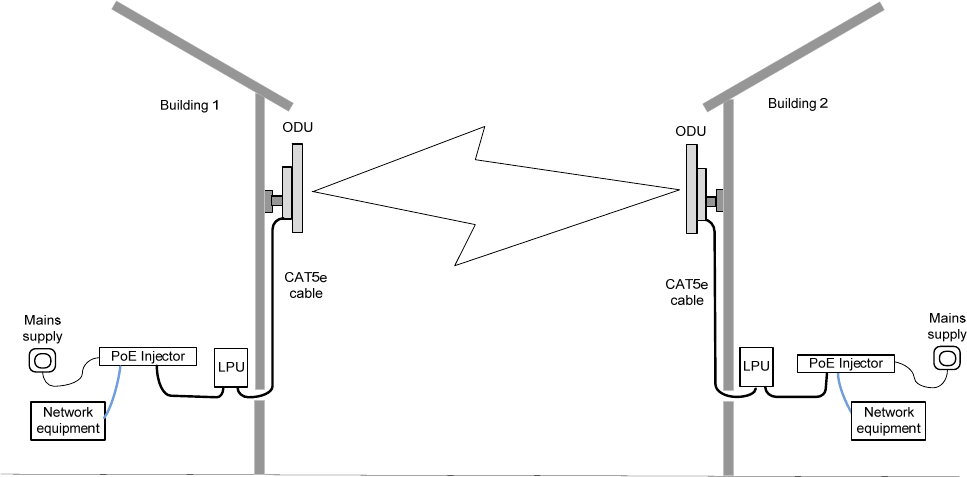
PTP 250 User Guide Overview of the PTP 250
phn- 2182_002v000
May 2011 1-3
8 0 2 .1 1 n device
PTP250 uses 802.11n encoding and radio transmission. In areas where the PTP 250
co-exists with 802.11a and 802.11n devices, the PTP 250 detects the 802.11a and
802.11n radio signals and chooses a clear channel away from any interference.
Avoiding int erference from nearby de vices
At initialization, the products monitor the available frequency channels to find a
channel that is clear of interference.
Typical deploym e nt
The PTP 250 bridge consists of a pair of identical units, one deployed at each end of
the link. The radio link operates on a single frequency channel. One unit is configured
as a master and the other as a slave. The master unit takes responsibility for
controlling the link in both directions.
The bridge is aimed at a wide range of applications. One example is an enterprise that
needs to connect together the Local Area Network (LAN) of two or more buildings as
shown in Figure 1-1.
Figure 1 - 1 Typical PTP 250 bridge deploym ent ( grounding not shown)

Overv iew of the PTP 250 Chapt er 1 Product descr ipt ion
phn- 2 182_002v 000
1-4 May 2011
System com ponent s
Each end of the link consists of:
• Outdoor Unit (ODU): An integrated (or connectorized) outdoor transceiver unit
containing all the radio and networking electronics.
• PoE power supply: An indoor connection box containing a mains power supply,
status indicators and network connection port.
• Cabling and lightning protection: CAT5e cables, grounding cables, connectors
and a lightning protection unit (LPU).
Product va ria nt s
The PTP 250 is available in the following product variants:
• FCC/IC or ETSI/RoW: The PTP 250 is available in two regional variants: one is
for use in countries where FCC or IC licensing restrictions apply (FCC/IC), and
the other is for use in ETSI countries or the rest of the world (ETSI/RoW). The
regional variants may operate in the following bands:
o ETSI/RoW: 5.4 GHz or 5.8 GHz.
o FCC/IC: 5.8 GHz only.
• Integrated or Connectorized: Both products are available in either Integrated
(with attached antenna) or Connectorized (without an antenna) variants.
• Link Complete or End Complete: The Link Complete kit consists of two ODUs
and two PoE power supply units. The End Complete kit consists of one ODU and
one PoE power supply unit.
To obtain part numbers for the above variants, refer to Installation inventories on page
4-2.
NOTE
The PTP 250 is not currently approved for 5.4 GHz operation in the USA or
Canada.
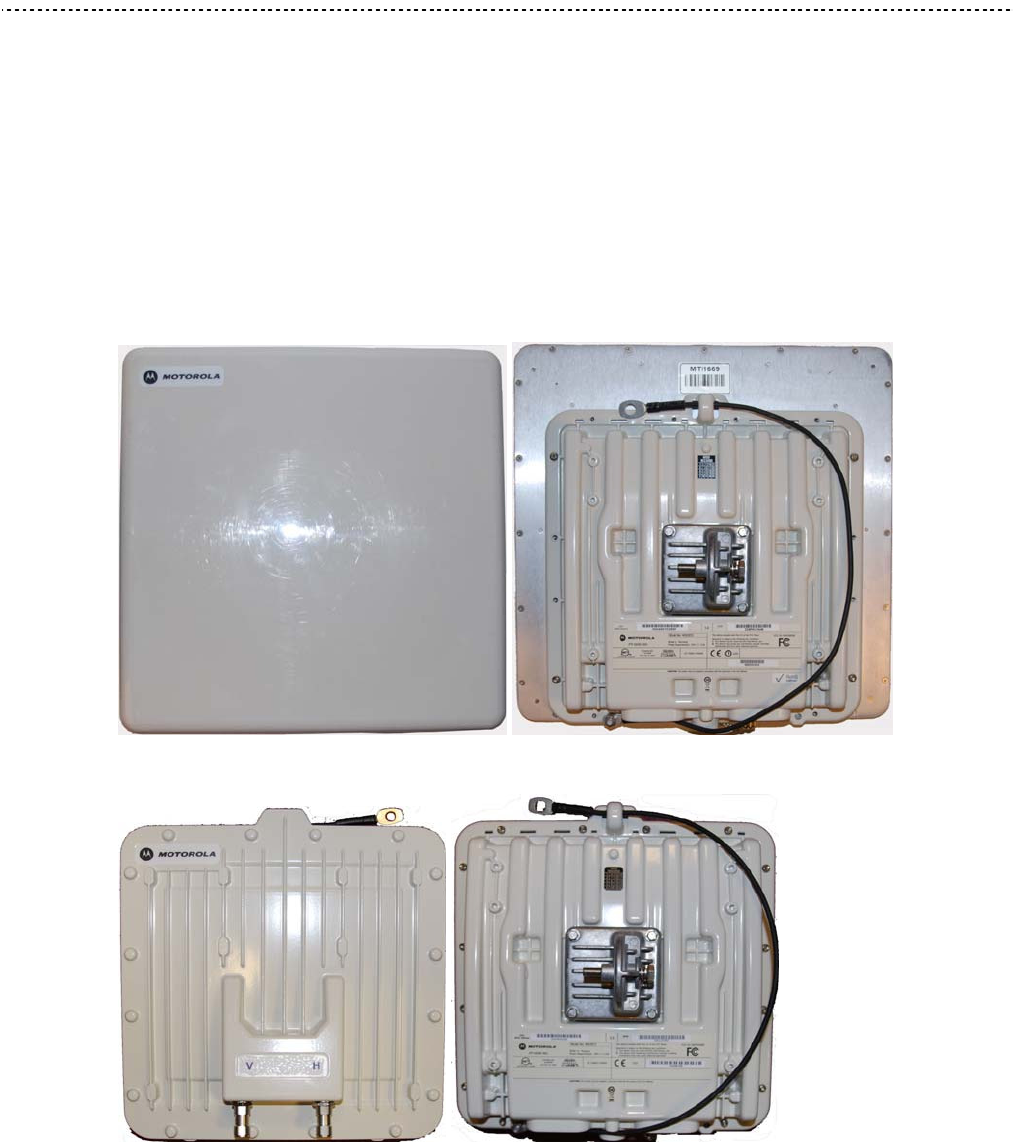
PTP 250 User Guide Outdoor unit ( ODU)
phn- 2182_002v000
May 2011 1-5
Out door unit ( ODU)
This section describes the PTP 250 ODU and its interfaces.
ODU descript ion
The ODU is a self-contained unit that houses both radio and networking electronics.
The ODU is supplied in two configurations: integrated (attached to its own flat plate
antenna, Figure 1-2) or connectorized (without an antenna, Figure 1-3).
Figure 1 - 2 I nt egrated ODU (front and rear views)
Figure 1 - 3 Connect orized ODU ( front and rear views)
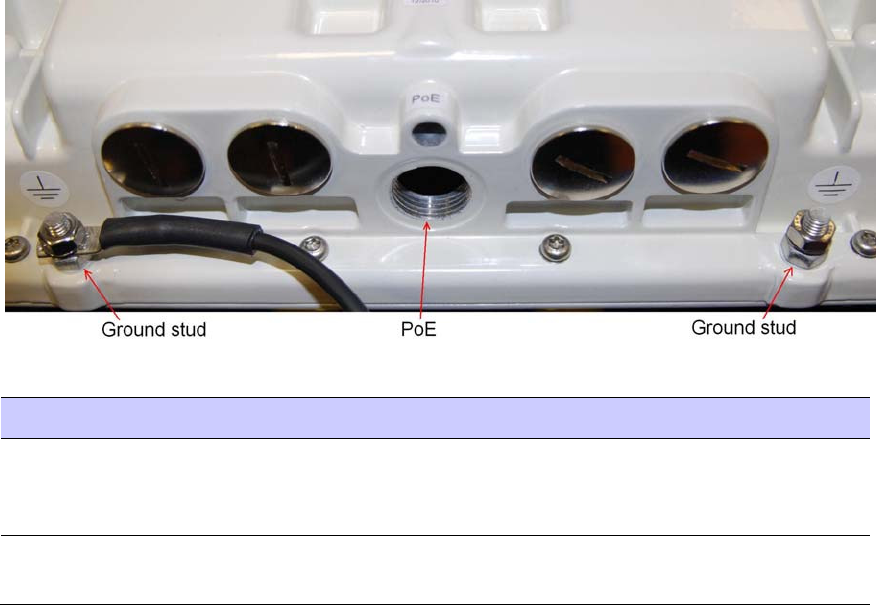
Outdoor unit ( ODU) Chapt er 1 Product descr ipt ion
phn- 2 182_002v 000
1-6 May 2011
Connect orized va ria nt
The connectorized ODU is designed to work with externally mounted antennas that
have higher gains than the integrated antenna. Connectorized units can cope with
more difficult radio conditions, as described in When to install connectorized units on
page 2-10.
ODU int erfa ces
The ODU interfaces are illustrated in Figure 1-4 and described in Table 1-1.
Figure 1 - 4 ODU interfaces
Table 1 - 1 ODU int erface funct ions
I nt er fa ce Fun ct ion
Ground studs For grounding the ODU to the supporting structure.
The ground cable (supplied with the ODU) may be
connected to either ground stud.
PoE RJ45 socket for connecting to power supply and
network via the PoE power supply.
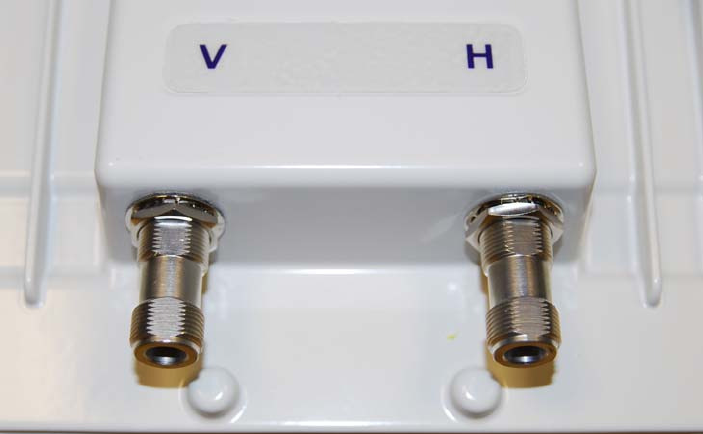
PTP 250 User Guide Outdoor unit ( ODU)
phn- 2182_002v000
May 2011 1-7
Conne ct orized ODU a nt enna int e r fa ce s
The connectorized ODU also has interfaces to connect to an external antenna (Figure
1-5) via an N type connector with RF cable of type LMR100, LMR200, LMR300,
LMR400 or LMR600. The ‘V’ interface is for vertical polarization and the ‘H interface
is for horizontal polarization.
Figure 1 - 5 Connect orized ODU antenna int erfaces
Mount ing bra cket s
The ODU is supplied with a bracket for mounting it to a pole of 50mm (2”) to 75mm
(3”) in diameter.
The bracket allows for adjustment in both azimuth and elevation. The bracket may be
split to allow the pole mount section of the bracket to be mounted to the pole first.
This allows the installer to take the weight of the unit and secure it, one handed, with
a single mounting bolt.
N e t w ork conne ct ion
The network connection to the ODU is made via a 1000BaseT (Gigabit) Ethernet
connection. Power is provided to the ODU over the 1000BaseT Ethernet connection
using a standard IEEE 802.3at power supply.
Outdoor unit ( ODU) Chapt er 1 Product descr ipt ion
phn- 2 182_002v 000
1-8 May 2011
Furt her rea ding on t he OD U
For more information on the ODU, refer to the following:
• ODU site selection on page 2-4 describes how to select a site for the ODU.
• When to install connectorized units on page 2-10 describes when to choose
connectorized ODUs and external antennas rather than integrated ODUs.
• General protection requirements on page 2-12 describes the grounding and
lightning protection requirements of a PTP 250 installation, including the ODU.
• Installation inventories on page 4-2 lists the components required for PTP 250
installations, including ODUs, with Motorola part numbers.
• ODU specifications on page 4-10 contains specifications of the ODU such as
dimensions, weight and environmental requirements.
• Antenna specifications on page 4-14 contains specifications of the antennas that
may be used with connectorized ODUs.
• Installing the ODU on page 5-5 describes how to install the ODU (integrated or
connectorized) on the supporting structure.
• Installing connectorized antennas on page 5-9 describes how to install separate
antenna(s) for a connectorized ODU.
• Aligning antennas on page 6-24 describes how to align the antennas for both
integrated and connectorized ODUs.
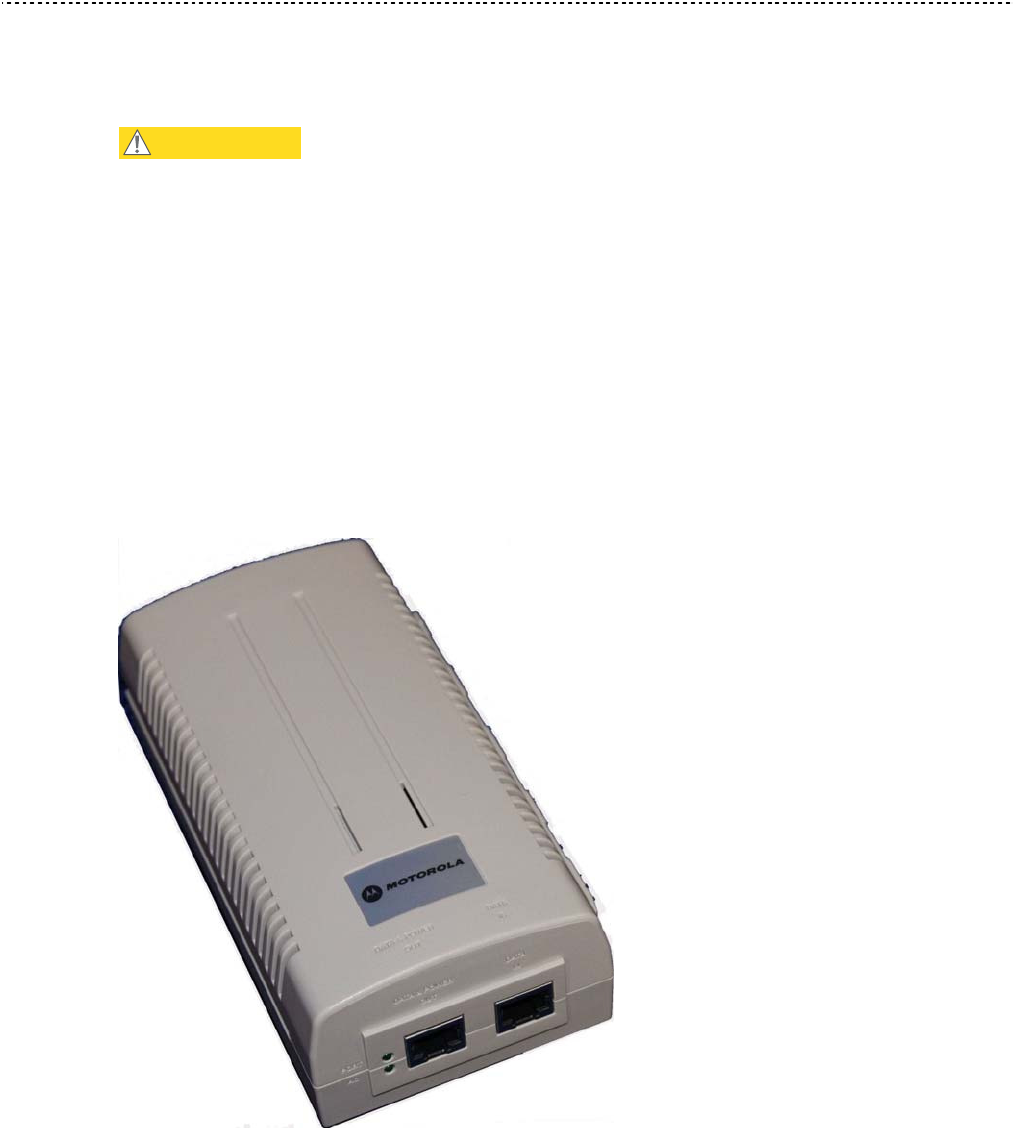
PTP 250 User Guide Power ov er Ethernet inj ect or (PoE power supply)
phn- 2182_002v000
May 2011 1-9
Pow er over Et hernet inj ector ( PoE pow er supply)
This section describes the PTP 250 Power over Ethernet injector (PoE power supply).
One or two PoE power supply units are provided with every PTP 250 kit.
CAUTION
The ODU should only be deployed with either the PoE power supply or the
PTP 300/500/600 Series PIDU. Do not use other power supply units, as they
may damage the PTP 250. For guidance on choosing the most suitable power
supply unit, refer to Power supply selection on page 2-4.
PoE pow er supply descr ipt ion
The Motorola High Power Gigabit PoE power supply (Motorola part number WB3727)
(Figure 1-6) is a single-port Power over Ethernet injector combining low-voltage DC
with Ethernet data in a single cable connecting to a PTP 250 ODU.
Figure 1 - 6 PoE power supply
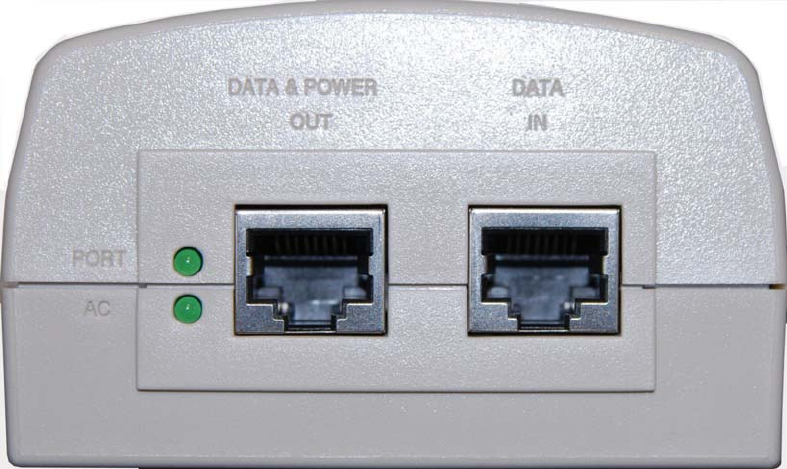
Power over Ether net inj ector ( PoE power supply) Chapt er 1 Product descr ipt ion
phn- 2 182_002v 000
1-10 May 2011
PoE fea t ures
The PoE power supply has the following features:
• Independent power controller (SPEAR™), CPU controller and input (Data) and
output (Data & Power) shielded RJ-45 connectors.
• Supports standard 10/100/1000BaseT Ethernet networks over a standard
TIA/EIA-568 Category 5 (or higher) cabling.
• Universal AC Input: 110/220 V, 60/50 Hz.
• Maximum available output power 30 W (nominal output voltage 52 to 56 V DC).
• Underload, overload, short-circuit and under/over voltage port protection.
• Port and AC power LED indicators.
• Standalone or wall mount installation support.
• Coupling rail and slot to allow two or more PoE power supply units to be
mounted together.
PoE pow er supply int erfaces
The PoE power supply interfaces are illustrated in Figure 1-7 and described in Table
1-2 and Table 1-3.
Figure 1 - 7 PoE power supply interfaces

PTP 250 User Guide Power ov er Ethernet inj ect or (PoE power supply)
phn- 2182_002v000
May 2011 1-11
Table 1 - 2 PoE power supply int erface funct ions
I nt er fa ce Fun ct ion
IEC Power socket at rear Mains power input (100 – 240 V AC).
DATA & POWER OUT RJ45 socket for connecting CAT5e cable to ODU.
DATA IN RJ45 socket for connecting CAT5e cable to network.
Table 1 - 3 PoE power supply indicator LEDs
I ndica t or Fun ct ion De scr ipt ion
AC Off The PoE power supply is not receiving power.
Green (steady) The PoE power supply is receiving power from
an AC outlet.
Green (blinking) The PoE power supply is receiving a voltage
from the AC outlet that is out of the correct
range (100 – 240 V AC).
Port Off There is no device connected to the DATA &
POWER OUT port.
Green (steady) A device is connected to the DATA & POWER
OUT port.
Green (blinking) The PoE power supply is overloaded or has a
short circuit.
Power over Ether net inj ector ( PoE power supply) Chapt er 1 Product descr ipt ion
phn- 2 182_002v 000
1-12 May 2011
Furt her rea ding on t he PoE pow er supply
For more information on the PoE power supply, refer to the following:
• Power supply selection on page 2-4 describes how to select a location for the PoE
power supply.
• Installation inventories on page 4-2 lists the components required for PTP 250
installations, including PoE power supply units, with Motorola part numbers.
• Power supply unit specifications on page 4-12 contains specifications of the PoE
power supply (and the PIDU) such as dimensions, weight, environmental and
electrical requirements.
• Connecting to the unit on page 6-3 describes how to connect the PoE power
supply to a management PC to allow configuration and alignment of the PTP 250.
• Installing the PoE power supply on page 5-27 describes how to install the PoE
power supply, connect it to the ODU, and prepare the network cables.
• Connecting to the network on page 6-35 describes how to connect the PoE power
supply to the network when configuration, installation and alignment are
complete.
• Testing link end hardware on page 8-2 describes how the PoE power supply is
used when testing the link end hardware for suspected faults.

PTP 250 User Guide Cabling and light ning prot ect ion
phn- 2182_002v000
May 2011 1-13
Cabling a nd light ning prot ection
This section describes the cabling and lightning protection components of PTP 250
installations.
PTP and light ning pr ot e ct ion
The PoE power supply meets the low level static discharge specifications identified in
Electromagnetic compatibility (EMC) compliance on page 4-22 but does not provide
lightning or surge suppression.
The amount of lightning protection is dependent on regulatory and end user
requirements. The standard ODU is fitted with surge limiting circuits and other
features to minimize the risk of damage due to nearby lightning strikes. To be fully
effective, these standard features require some additional equipment to be configured
as part of the system installation.
WARNING
The units are not designed to survive direct lightning strike. For this reason
they must not be installed in ‘Zone A’, as defined in Lightning protection
zones on page 2-11. Mounting in Zone A may put equipment, structures and
life at risk.
Out door connections
The term ‘drop cable’ refers to the cable that is used for all connections that terminate
outside the building, for example, connections between the ODU, LPU and PoE power
supply.
CAUTION
For outdoor connections, always use Cat5e cable that is gel-filled and
shielded with copper-plated steel. This is the only type of outdoor drop cable
supported in this application.
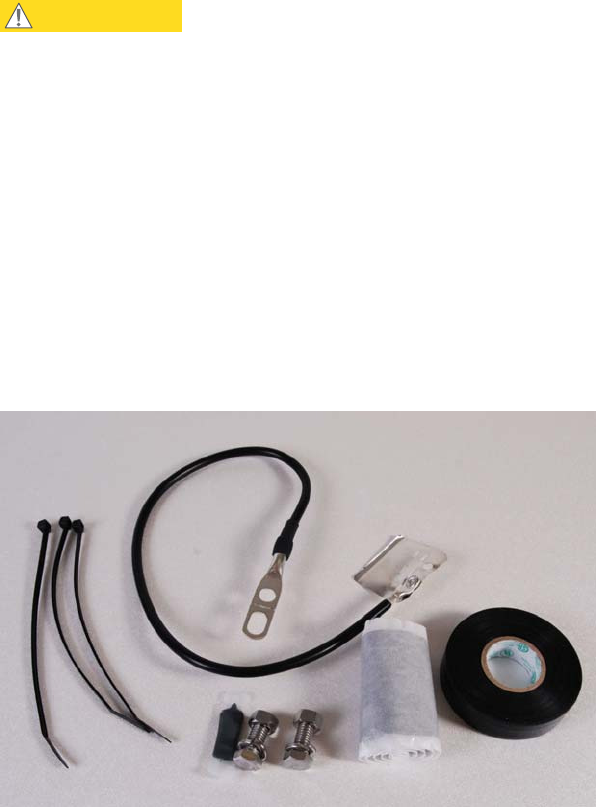
Cabling and light ning prot ect ion Chapt er 1 Product descr ipt ion
phn- 2 182_002v 000
1-14 May 2011
I ndoor connections
The CAT5e cable that connects the PoE power supply to the network equipment must
meet the following requirements:
• Screening: Must be either foil screen (FTP) or braided screen (STP) cable.
• Connectors: Must use screened RJ45 connectors with metal shells at both ends.
• Electrical connection: There must be a continuous electrical connection
between both screened connectors.
CAUTION
The connected network equipment must feature screened RJ45
connectors and must be connected to ground, otherwise the PoE power
supply will not be grounded, and this may increase the levels of unwanted
radiation from the ODU - PoE power supply cables.
Cable grounding k it s
Drop cables must be grounded at the points specified in Grounding and lightning
protection on page 2-11. One cable grounding kit (Figure 1-8) is required for each
drop cable grounding point.
Figure 1 - 8 Cable grounding kit for 1/ 4” and 3/ 8” cable
Cabling and light ning prot ect ion Chapt er 1 Product descr ipt ion
phn- 2 182_002v 000
1-16 May 2011
Furt her rea ding on ca bling and light ning pr ot e ct ion
For more information on cabling and lightning protection, refer to the following:
• Maximum cable lengths on page 2-5 gives maximum permitted lengths of
interface cables in PTP 250 installations.
• Grounding and lightning protection on page 2-11 describes the grounding and
lightning protection requirements of a PTP 250 installation.
• Installation inventories on page 4-2 lists the components required for PTP 250
installations, including cables, connectors, grounding kits and LPUs.
• Installing the drop cable and LPU on page 5-14 describes how to install the drop
cable from the ODU to the LPU and PoE power supply, and to provide grounding
for the installation.
• Installing the PoE power supply on page 5-27 describes how to prepare the
indoor cables to connect to the network.
• Testing after a lightning strike on page 8-2 describes testing to be performed
after a PTP 250 installation is struck by lightning.

PTP 250 User Guide Wir eless operation
phn- 2182_002v000
May 2011 1-17
W ireless ope rat ion
This section describes how PTP 250 wireless links are operated, including modulation
modes, power control and security.
W ireless Tra nsm ission s
The PTP 250 uses Time Division Duplexing (TDD) transmission, which means that a
single frequency channel is used for both Transmit and Receive. This is handled
automatically by the radio.
The PTP 250 transmits using Orthogonal Frequency Division Multiplexing (OFDM).
This wideband signal consists of many equally spaced sub-carriers. Although each
sub-carrier is modulated at a low rate using conventional modulation schemes, the
resultant data rate from all the sub-carriers is high.
The channel width of the OFDM signal is configurable to one of two values: 20 MHz or
40 MHz. The higher channel width provides greater link capacity at the expense of
using more spectrum. The lower channel width provides better receiver sensitivity and
can also be appropriate where the amount of free spectrum is limited.
Each channel is offset in center frequency from its neighboring channel by 20 MHz.
Spe ct r um m ana gem ent
At system start-up, the spectrum management feature of the PTP 250 monitors the
available wireless spectrum and directs both ends of the wireless link to operate on a
channel with a minimum level of co-channel and adjacent channel interference.
Alternatively, the user can specify a single channel to use (or several to be chosen
from) at the master unit.
Adapt ive m odula t ion
The PTP 250 can transport data over the wireless link using different modulation
modes. For a given channel width, each modulation mode transports data at a fixed
rate. Also, the receiver requires a given signal to noise ratio in order to successfully
demodulate a given modulation mode. Although the more complex modulations will
transport data at a much higher rate than the less complex modulation modes, the
receiver requires a much higher signal to noise ratio.

Wir eless operation Chapt er 1 Product descr ipt ion
phn- 2 182_002v 000
1-18 May 2011
The system provides an adaptive modulation scheme where the receiver constantly
monitors the quality of the received signal and notifies the far end of the link of the
optimum modulation mode with which to transmit. In this way, optimum capacity is
achieved at all times.
NOTE
PTP LINKPlanner includes an estimate of mean data rate, the data rate
provided by each modulation and the percentage of time spent in each
modulation mode.
MI MO
Multiple-Input Multiple-Output (MIMO) techniques provide protection against fading
and increase the probability that the receiver will decode a usable signal. When the
effects of MIMO are combined with those of OFDM techniques and a high link budget,
there is a high probability of a robust connection.
The PTP 250 transmits two signals on the same radio frequency, one of which is
vertically polarized and the other horizontally polarized. The system also has the
ability to adapt between two modes of operation:
• Dual Payload: When the radio channel conditions allow, the system will transmit
two different and parallel data streams, one on the vertical channel and one on
the horizontal channel. This doubles the capacity of the system.
• Single Payload: As the radio channel becomes more challenging, the system has
the ability to detect this and switch to a mode which transmits the same data
stream on both vertical and horizontal channels. This provides polar diversity and
is another key feature which allows the system to operate in challenging radio
channels.
The switching between modes is automatically controlled by the adaptive modulation
feature described in Adaptive modulation on page 1-17.

PTP 250 User Guide Wir eless operation
phn- 2182_002v000
May 2011 1-19
Ra da r a voida nce
In regions where protection of radars is part of the local regulations, the PTP 250 must
detect interference from radar-like systems and avoid co-channel operation with these
systems.
To meet this requirement, the PTP 250 implements the following features:
ETSI regulat ions
The regulations have radar detection requirements for both master and slave devices.
The requirements for a master device are:
• The device can only transmit on available channels, of which there are none at
initial power up. The radar detection algorithm will always scan a usable channel
for 60 seconds (channel availability check) for radar interference before making
the channel an available channel.
• As a result of this compulsory channel scan, there is a service outage of at least
60 seconds every time radar is detected, and the installation time is extended by
at least 60 seconds even if no radar is detected on the channel.
• When operating on a channel, the spectrum monitoring algorithm implements a
radar detection function (in-service monitoring) which looks for impulsive
interference on the operating channel. If impulsive interference is detected,
spectrum management will mark the current operating channel as having
detected radar (unavailable channel) and initiate a channel hop to an available
channel. The previous operating channel will remain in the unavailable state for
30 minutes after the impulsive interference pulse was detected.
• After the 30 minutes have expired the channel will be returned to the usable
channel
pool.
• There is a secondary requirement for bands requiring radar avoidance.
Regulators have mandated that products provide an approximately even loading
of the spectrum across all devices. In general, this prevents operation with fixed
frequency allocations. However, ETSI regulations do allow frequency planning of
networks (as that has the effect of spreading the load across the spectrum).
NOTE
The Master device will not initiate any transmissions on channels which
overlap the band 5600-5650 MHz as the radar detection requirements are
more severe.

Wir eless operation Chapt er 1 Product descr ipt ion
phn- 2 182_002v 000
1-20 May 2011
The requirements for a slave device are:
• The slave device can only transmit after receiving a transmission from its
associated master to demonstrate that the channel is an available channel.
• The slave device is required to vacate the channel when the master device has
detected a radar signal.
• The slave device is also required to perform in-service monitoring
and will stop
transmitting on a channel having detected a radar signal (having informed the
master device) and will not re-use the channel for thirty minutes.
• Once the slave device has detected a radar on a channel, it will perform a
channel availability check
before transmitting again on the channel.
• The slave device is also required to perform Channel Availability Check (CAC)
measurements before responding to a master transmission, but this requirement
only applies after the slave has detected a radar signal on the channel.
Securit y
The PTP 250 supports 48-bit proprietary encryption for data transmitted over the
wireless link.
Count r y of operat ion
Some aspects of wireless operation are controlled, enforced or restricted according to
country of operation.
The Country Code must be set in the user interface by the user at first login. The
Country Code setting affects the following aspects of wireless operation:
• Maximum transmit power
• Radar avoidance
• Transmit power reduction in edge channels
• Frequency range
• Channel plan
CAUTION
To avoid possible enforcement action by the country regulator, always
operate links in accordance with local regulations.

PTP 250 User Guide Wir eless operation
phn- 2182_002v000
May 2011 1-21
NOTE
Equipment supplied to the USA can ONLY be set to operate with a Country
Code which is fully compatible with FCC Rules.
Using fr e quency planning
Networks will benefit from the use of fixed channel allocations if (a) the network
consists of multiple PTP links, and (b) RF interference predominantly arises from
equipment in the same network.
Frequency planning is the exercise of assigning operating channels to PTP units so as
to minimize RF interference between links. Frequency planning must consider
interference from any PTP unit to any other PTP unit in the network. Low levels of
interference normally allow for stable operation and high link capacity.
The frequency planning task is made more straightforward by use of the following
techniques:
• Using several different channels
• Separating units located on the same mast
• Using high performance (directional) external antennas
For help with planning networks, refer to Chapter 2 Planning considerations, or
contact a Motorola distributor or re-seller.
Wir eless operation Chapt er 1 Product descr ipt ion
phn- 2 182_002v 000
1-22 May 2011
Furt her rea ding on w ireless ope ra t ion
For information on planning wireless operation, refer to the following:
• Spectrum planning on page 2-2 describes the regulatory restrictions that affect
radio spectrum usage, such as frequency range and radar avoidance.
• Link planning on page 2-8 describes factors to be taken into account when
planning links, such as range and path loss, and introduces PTP LINKPlanner.
• Wireless specifications on page 4-19 contains specifications of the PTP 250
wireless interface, such as RF bands, channel width, spectrum settings,
maximum power and link loss.
• Compliance with safety standards on page 4-22 lists the safety specifications
against which the PTP 250 has been tested, and describes how to keep RF
exposure within safe limits.
• Compliance with radio regulations on page 4-27 describes how the PTP 250
complies with the radio regulations that are in force in various countries.
• Notifications on page 4-33 contains notifications of compliance with the radio
regulations that are in force in various regions.
For information on configuring and operating the wireless link, refer to the following:
• Using the installation wizard on page 6-14 describes how to configure the
wireless interface using the installation wizard.
• Comparing actual to predicted performance on page 6-34 describes how to check
that a newly installed link is achieving predicted levels of performance.
• Managing performance on page 7-17 describes how to manage the performance
of a PTP 250 link.
• Testing the radio link on page 8-12 describes what to do if the radio link is not
working, or it is unreliable, or the data throughput rate is too low.

PTP 250 User Guide Ether net bridging
phn- 2182_002v000
May 2011 1-23
Et hernet bridging
This section describes how the PTP 250 controls Ethernet data in the customer and
management networks.
Cust om er ne t w ork
Tr a nspare nt Et hernet service
The PTP 250 provides an Ethernet service between the Ethernet port at a local ODU
and the Ethernet port at an associated remote ODU. The Ethernet service is based on
conventional layer two transparent bridging, and is equivalent to the Ethernet Private
Line (EPL) service defined by the Metro Ethernet Forum (MEF).
The service is transparent to untagged frames, standard VLAN frames, priority-tagged
frames, provider bridged frames, and provider backbone bridged frames. In each case,
the service preserves MAC addresses, VLAN ID, Ethernet priority and Ethernet
payload in the forwarded frame. The maximum frame size for bridged frames is
2000 octets.
Layer t w o cont rol pr ot ocols
The PTP 250 is transparent to layer two control protocols (L2CP) including:
• Spanning tree protocol (STP), rapid spanning tree protocol (RSTP)
• Multiple spanning tree protocol (MSTP)
• Link aggregation control protocol (LACP)
• Link OAM, IEEE 802.3ah
• Port authentication, IEEE 802.1X
• Ethernet local management interface (E-LMI), ITU-T Q.933.
• Link layer discovery protocol (LLDP)
• Multiple registration protocol (MRP)
• Generic attribute registration protocol (GARP)
The system does not generate or respond to any L2CP traffic.
Ether net bridging Chapt er 1 Product descr ipt ion
phn- 2 182_002v 000
1-24 May 2011
Managem ent net w ork
I P int er face
The PTP 250 ODU contains an embedded management agent with a single IP
interface. Network management communication is exclusively based on IP and
associated higher layer transport and application protocols. The factory default IP
address of the management agent is 169.254.1.1. The products do not require use of
supplementary serial interfaces.
MAC a ddress
The MAC address is not configurable by the user.
VLAN m em ber ship
VLAN tagging is not supported for the management agent.
I n- band m ana gem ent
In-band management is the only management mode offered (there is no out of band
management).
In the in-band management mode, the management agent can be reached from the
Ethernet port at the local ODU, and (assuming that the wireless link is established) the
Ethernet port at the remote ODU.
W ire less link dow n ale rt
PTP 250 offers a configurable email alert which can be set to send the user an email
message in the event of the wireless link going down.
Back- t o- ba ck link s
PTP 250 will not operate correctly if a direct cabled connection is made between two
PoE power supply units. Where two or more links are deployed in a chain, always use
an Ethernet switch or router to interconnect the links at the relay points.
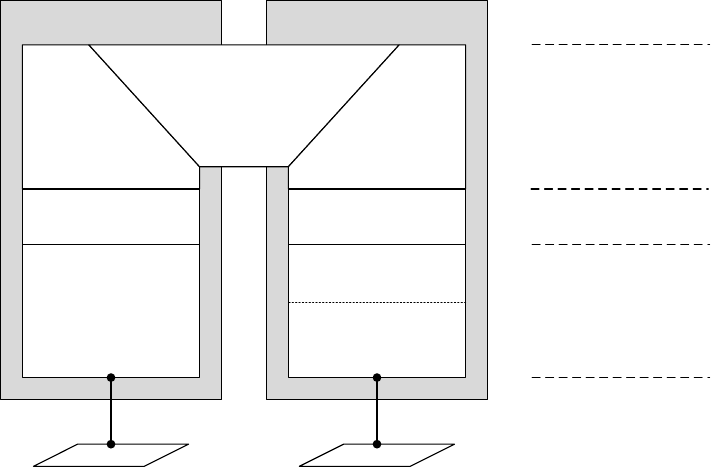
PTP 250 User Guide Ether net bridging
phn- 2182_002v000
May 2011 1-25
Prot ocol m odel
Ethernet bridging behavior at each end of the wireless link is equivalent to a two-port,
managed, transparent MAC bridge where the two ports are:
• Ethernet Port
• Wireless Port
Frames are transmitted at the Wireless port over a proprietary point-to-point circuit-
mode link layer between ends of the link. Ethernet frames received at the Ethernet
port, or generated internally within the management agent, are encapsulated within a
lightweight MAC layer for transmission over the wireless link.
Protocol layers involved in bridging between Ethernet and wireless interfaces are
shown in Figure 1-10. Protocol layers involved in bridging between external interfaces
and the management agent are shown in Figure 1-11. In these figures, the layers have
the meanings defined in IEEE 802.1Q-2005.
Figure 1 - 1 0 Protocol layers between Ethernet and wireless int erfaces
Wireless PortEthernet Port
IEEE 802.3
Media Access Method
Independent Functions
Media Access Method Dependent
Convergence Functions
Media Access Method
Specific Functions
Ethernet Wireless
PTP Medium Access
Method
PTP Physical Layer
MAC Relay Entity
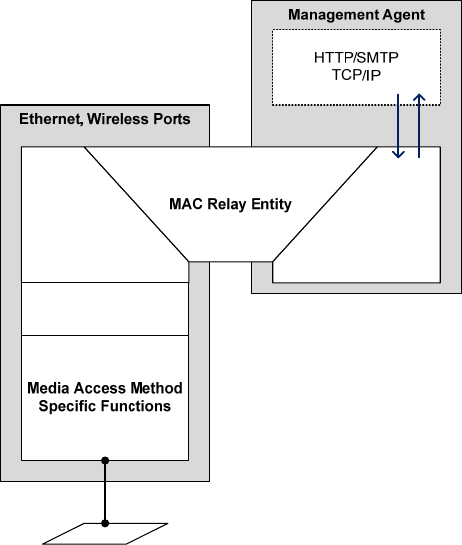
Ether net bridging Chapt er 1 Product descr ipt ion
phn- 2 182_002v 000
1-26 May 2011
Figure 1 - 1 1 Protocol layers between ext ernal int erfaces and t he m anagem ent agent
Furt her rea ding on Et hernet br idging
For more information on Ethernet bridging, refer to the following:
• Data network planning on page 2-21 describes factors to be considered when
planning PTP 250 data networks.
• Data network specifications on page 4-21 contains specifications of the PTP 250
Ethernet interface.
• Using the installation wizard on page 6-14 describes how to configure the IP and
Ethernet attributes of the PTP 250.
• Reviewing system configuration attributes on page 6-31 describes how to review
the IP and Ethernet attributes of the PTP 250.

PTP 250 User Guide Syst em m anagem ent
phn- 2182_002v000
May 2011 1-27
System m ana gem ent
This section introduces the PTP 250 management system, including the web interface,
installation, configuration, alerts and upgrades.
W eb ser ver
The PTP 250 management agent contains a web server.
Web-based management offers a convenient way to manage the equipment from a
locally connected computer or from a workstation connected through a management
network, without requiring any special management software. The web-based
interfaces are the only interfaces supported for system installation and configuration
management.
The web-based management interfaces provide comprehensive web-based fault,
configuration, performance and security management functions organized into the
following menu options:
• Home: This page reports wireless link status and basic information needed to
identify the link.
• Status: This page reports the detailed status of the system.
• Configuration: These pages are used to review the LAN, wireless, date and
email settings. These settings are updated using the Installation Wizard.
• Statistics: This page contains performance management counters that are
collected at the data, management and wireless ports.
• Firmware Update: This page is used to update the firmware in the unit.
• Diagnostics Plotter: This page provides diagnostic measurements over time, as
an aid to performance management.
• Installation Wizard: These pages are used to complete the initial system
configuration, including LAN, wireless, date and email settings.
• Change Password: The page is used to change the web-interface password.
• Reboot: This page is used to reboot the unit.
• Logout: This page is used to log out of the web-based interface.

Syst em m anagem ent Chapt er 1 Product descr ipt ion
phn- 2 182_002v 000
1-28 May 2011
Firm w are upgrade
The management agent supports application firmware upgrade using the web-based
interface.
PTP 250 firmware images are digitally signed, and the ODU will accept only images
that contain a valid Motorola PTP digital signature. The ODU always requires a reboot
to complete a firmware upgrade.
Obtain the application firmware and this user guide from the support website
(http://www.motorola.com/ptp/support) BEFORE warranty expires.
CAUTION
ODU firmware version must be the same at both ends of the link. Limited
operation may sometimes be possible with dissimilar firmware versions, but
such operation is not supported by Motorola.
The procedure for firmware upgrade is described in Upgrading firmware version on
page 6-10.
Reset t o fa ct ory default s
The ‘reset to factory defaults’ feature provides a means to recover from serious
configuration errors, such as lost or forgotten passwords.
Use the reset plug (supplied in each PTP 250 ‘Link Complete’ or ‘End Complete’ kit) to
reset the unit to factory default configuration, including reset of the country that was
selected at first login. Following the procedure in Resetting to default configuration
(with country reset) on page 7-26
Use the Save & Restore page to reset the unit to factory default configuration, without
resetting the country that was selected at first login. Follow the procedure in Resetting
to default configuration (without country reset) on page 7-25.
Furt her rea ding on syst em m ana gem e nt
For more information on system management, refer to the following:
• Chapter 6 Configuration and alignment describes all configuration and alignment
tasks that are performed when a PTP 250 link is deployed.
• Chapter 7 Operation provides instructions for operators of the PTP 250 web user
interface.

Cha pt e r 2
phn- 2182_002v000
May 2011 2-1
Chapt er 2 Planning considerat ions
. . . . . . . . . . . . . . . . . . . . . . . . . . . . . . . . . . . . . . . . . . . . . . . . . . . . . . . . . . . .
.
.
.
.
This chapter provides information to help the user to plan a PTP 250 link.
The following topics are described in this chapter:
• Spectrum planning on page 2-2 describes the regulatory restrictions that affect
radio spectrum usage, such as frequency range and radar avoidance.
• Site planning on page 2-4 describes factors to be considered when choosing sites
for the ODU and PoE power supply.
• Link planning on page 2-8 describes factors to be taken into account when
planning links, such as range and path loss. Introduces the PTP LINKPlanner.
• Grounding and lightning protection on page 2-11 describes the grounding and
lightning protection requirements of a PTP 250 installation.
• Data network planning on page 2-21 describes factors to be considered when
planning PTP 250 data networks.

Spect rum planning Chapt er 2 Planning consider at ions
phn- 2 182_002v 000
2-2 May 2011
Spectrum planning
This section describes the regulatory restrictions that affect radio spectrum usage.
Each frequency variant has specific regulatory restrictions that affect frequency range,
radar avoidance and channel width usage.
Ava ila ble spect r um
Ensure the link is configured to conform to local regulatory requirements.
The available spectrum for operation depends on the country of operation:
• The 5.4 GHz band is available in all EU countries.
• The 5.8 GHz band is currently only available in a limited number of EU countries
(UK, Eire, Norway, Denmark, Germany and Spain).
Certain regulations have allocated certain channels as unavailable for use:
• Europe has allocated part of the 5.4 GHz band to weather radar.
• The UK and some other European countries have allocated part of the 5.8 GHz
band to Road Transport and Traffic Telematics (RTTT) systems.
For examples of these restrictions, refer to Examples of regulatory limits on page 4-32.
Where regulatory restrictions apply to certain channels, these channels are barred
automatically by the use of the correct country setting. For example, at 5.8 GHz in the
UK and some other European countries, the RTTT band 5795 MHz to 5815 MHz is
barred. With the appropriate configuration for a country in this region, the PTP 250
will not operate on channels within this band.
The number and identity of channels barred by the country selection is dependent on
the channel width selected.
NOTE
For the connectorized model, when using external antennas of higher gain
than the appropriate integrated antenna, the regulations may require the
maximum transmit power to be reduced. To ensure that regulatory
requirements are met for connectorized installations, refer to Calculating
EIRP for connectorized units on page 4-30.
PTP 250 User Guide Spect rum planning
phn- 2182_002v000
May 2011 2-3
Frequency selection
The PTP 250 fully conforms to regional regulatory requirements for radar avoidance.
In regions that mandate DFS, the unit first ensures that there is no radar activity on a
given channel for a period of 60 seconds before radiating on that channel. Once a
channel has been selected for operation, the unit will continually monitor for radar
activity on the operating channel. If detected, it will immediately cease radiating and
attempt to find a new channel.
Radar avoidance requirements in the 5.4 GHz band are defined as follows:
• For the EU: in specification EN 301-893 version V1.5.1.
Radar avoidance at 5.8 GHz is applicable to EU operation (not FCC/IC) and the
requirements are defined in EN 302 502.
Cha nnel w idt h
Select the required channel width for the link (20 MHz or 40 MHz). The wider channel
has the greater the capacity. As narrower channel widths take up less spectrum,
selecting a narrow channel width may be a better choice when operating in locations
where the spectrum is very busy.

Site planning Chapt er 2 Planning considerat ions
phn- 2 182_002v 000
2-4 May 2011
Sit e pla nning
This section describes factors to be taken into account when choosing sites for the
ODU and PoE power supply.
ODU sit e selection
When selecting a site for the ODU, consider the following factors:
• Height and location to ensure that people are kept away from the antenna; see
Calculated distances and power compliance margins on page 4-25.
• Height and location to achieve the best radio path.
• Ability to meet the requirements specified in Grounding and lightning protection
on page 2-11.
• Aesthetics and planning permission issues.
• Cable lengths; see Maximum cable lengths on page 2-5.
• The effect of strong winds on the installation; see Wind loading on page 2-5.
Pow e r supply sele ct ion
Select a suitable power supply unit for the PTP 250. The only supported units are the
PoE power supply (included in PTP 250 kits) or the PTP 300/500/600 Series PIDU. The
PoE power supply is suitable for the majority of installations, but the PIDU is required
in the following situations:
• When a -48 V DC power supply is required, either as the primary supply or as a
backup to the AC mains.
• When an extended operating temperature range is required for the mains
powering system, for example when the indoor equipment is in a building without
temperature control or air conditioning.
For PIDU ordering information, see Alternative components on page 4-9.
The power supply unit must be installed in an indoor location with no possibility of
condensation, with an ambient temperature within the specified operating range of the
product; see Power supply unit specifications on page 4-12.

PTP 250 User Guide Site planning
phn- 2182_002v000
May 2011 2-5
Max im um cable le ngt hs
The maximum permitted lengths of interface cables in PTP 250 installations are
specified in Table 2-1.
Table 2 - 1 Maxim um cable lengt hs
I nt er fa ce ty pe I nt er fa ce Ma x im um
lengt h
Ethernet power
and data
ODU to network terminating
equipment.
100 m (330 ft)
W ind loading
Ensure that the supporting structure will not be prone to excessive wind loading.
Antennas and equipment mounted on towers or buildings will subject the mounting
structure to significant lateral forces when there is appreciable wind. Antennas are
normally specified by the amount of force (in pounds) for specific wind strengths. The
magnitude of the force depends on both the wind strength and size of the antenna.
The ODU, with or without the integral antenna, is essentially a flat structure. The
magnitude of the lateral force can be estimated from surface area and wind speed.
Calculat ion of la t e r al for ce ( m et ric)
The magnitude of the lateral force can be estimated from:
Force (in kilograms) = 0.1045aV2
W he re : I s:
a surface area in square meters
V wind speed in meters per second

Site planning Chapt er 2 Planning considerat ions
phn- 2 182_002v 000
2-6 May 2011
The lateral force produced by a single PTP 250 ODU (integrated or connectorized
model) at different wind speeds is shown in Table 2-2.
Table 2 - 2 Lateral force – m et ric
Type of ODU La rge st
sur fa ce area
( square m et e rs)
Lat e ra l force ( Kg) at w ind spee d
( m e te rs per se cond)
3 0 4 0 5 0 6 0 7 0
Integrated 0.130 12 22 34 49 66
Connectorized 0.093 9 16 24 35 48
Calculat ion of la t e r al for ce ( US)
The magnitude of the lateral force can be estimated from:
Force (in pounds) = 0.0042Av2
W he re : I s:
A surface area in square feet
v wind speed in miles per hour
The lateral force produced by a single PTP 250 ODU (integrated or connectorized
model) at different wind speeds is shown in Table 2-3.
Table 2 - 3 Lateral force – US
Type of ODU Largest
sur fa ce area
( squar e feet )
Lat e ra l force ( lb) at w ind spee d
( m iles per hour)
8 0 1 0 0 1 2 0 1 4 0 1 5 0
Integrated 1.36 36.6 57.1 82.3 146.2 228.5
Connectorized 1.00 26.9 42 60.5 107.5 168.0
NOTE
When the connectorized ODU is used with external antennas, the figures
from the antenna manufacturer for lateral force should be included to
calculate the total loading on the mounting structure.

PTP 250 User Guide Site planning
phn- 2182_002v000
May 2011 2-7
Capa bilit ies of t he PTP 2 5 0
The structure and mounting brackets of the ODU are capable of withstanding wind
speeds up to 242 kph (151 mph). Ensure that the structure to which the ODU is fixed
is also capable of withstanding the prevalent wind speeds and loads.
W ind spe ed stat ist ics
Contact the national meteorological office for the country concerned to identify the
likely wind speeds prevalent at the proposed location. Use this data to estimate the
total wind loading on the support structures. Sources of information:
• US National Weather Service, http://www.nws.noaa.gov/
• UK Meteorological Office, www.meto.gov.uk

Link planning Chapt er 2 Planning consider at ions
phn- 2 182_002v 000
2-8 May 2011
Link pla nning
This section describes factors to be taken into account when planning links, such as
range, obstacles and path loss. PTP LINKPlanner is recommended.
Ra nge and obst a cle s
Calculate the range of the link and identify any obstacles that may affect radio
performance.
Perform a survey to identify all the obstructions (such as trees or buildings) in the path
and to assess the risk of interference. This information is necessary in order to achieve
an accurate link feasibility assessment.
NOTE
When higher gain connectorized antennas are used, reduce the transmit
power to ensure that the receiver signal level does not exceed -20 dBm.
PTP LI N KPla nner
The Motorola PTP LINKPlanner software and user guide may be downloaded from
http://www.motorola.com/ptp/support.
PTP LINKPlanner imports path profiles and predicts data rates and reliability over the
path. It allows the system designer to try different antenna heights and RF power
settings. It outputs an installation report that defines the parameters to be used for
configuration, alignment and operation. The installation report can be used to compare
the predicted and actual performance of the link.
PTP 250 User Guide Link planning
phn- 2182_002v000
May 2011 2-9
Pat h loss considerat ions
Path loss is the amount of attenuation the radio signal undergoes between the two
ends of the link.
Calculat ing pa t h loss
The path loss is the sum of the attenuation of the path if there were no obstacles in the
way (Free Space Path Loss), the attenuation caused by obstacles (Excess Path Loss)
and a margin to allow for possible fading of the radio signal (Fade Margin). The
calculation of Equation 2-1 needs to be performed to judge whether a particular link
can be installed.
Equa t ion 2 - 1 Path loss
capabilityseasonalfadeexcessspacefree LLLLL
<
+
+
+
_
Where is
spacefree
L_ Free Space Path Loss (dB)
excess
L Excess Path Loss (dB)
fade
L Fade Margin Required (dB)
seasonal
L Seasonal Fading (dB)
capability
L Equipment Capability (dB)
Ada pt ive m odulat ion
Adaptive modulation ensures that the highest throughput that can be achieved
instantaneously will be obtained, taking account of propagation and interference.
When the link has been installed, web pages provide information about the link loss
currently measured by the equipment, both instantaneously and averaged. The
averaged value will require maximum seasonal fading to be added, and then the radio
reliability of the link can be computed.
Link planning Chapt er 2 Planning consider at ions
phn- 2 182_002v 000
2-10 May 2011
W hen t o install connector ized unit s
The majority of radio links can be successfully deployed with the integrated PTP 250.
However the integrated units may not be sufficient in some areas, for example:
• Where the path is heavily obscured by dense woodland on an NLOS link.
• Where long LOS links (>23 km or >14 miles) are required.
• Where there are known to be high levels of interference.
PTP LINKPlanner can be used to identify these areas of marginal performance.
In these areas, connectorized ODUs and external antennas should be used.
The external antennas can be either dual-polarization (as the integrated antenna) or
two single polarized antennas can be used in a spatially diverse configuration. It is
expected that the dual-polarization antennas would normally be used to simplify the
installation process; spatially diverse antennas may provide additional fade margin on
very long LOS links where there is evidence of correlation of the fading characteristics
on Vertical and Horizontal polarizations.

PTP 250 User Guide Grounding and light ning pr otect ion
phn- 2182_002v000
May 2011 2-11
Grounding and light ning prot ection
Structures, equipment and people must be protected against power surges (typically
caused by lightning) by conducting the surge current to ground via a separate
preferential solid path.
The actual degree of protection required depends on local conditions and applicable
local regulations.
Motorola recommends that PTP 250 installation is contracted to a professional
installer.
WARNING
Electro-magnetic discharge (lightning) damage is not covered under
warranty. The recommendations in this guide, when followed
correctly, give the user the best protection from the harmful effects
of EMD. However 100% protection is neither implied nor possible.
Sta ndards
Full details of lightning protection methods and requirements can be found in the
international standards IEC 61024-1 and IEC 61312-1, the U.S. National Electric Code
ANSI/NFPA No. 70-1984 or section 54 of the Canadian Electric Code.
Light ning pr ot e ct ion zone s
The ‘rolling sphere method’ (Figure 2-1) is used to determine where it is safe to mount
equipment. An imaginary sphere, typically 50 meters in radius, is rolled over the
structure. Where the sphere rests against the ground and a strike termination device
(such as a finial or ground bar), all the space under the sphere is considered to be in
the zone of protection (Zone B). Similarly, where the sphere rests on two finials, the
space under the sphere is considered to be in the zone of protection.
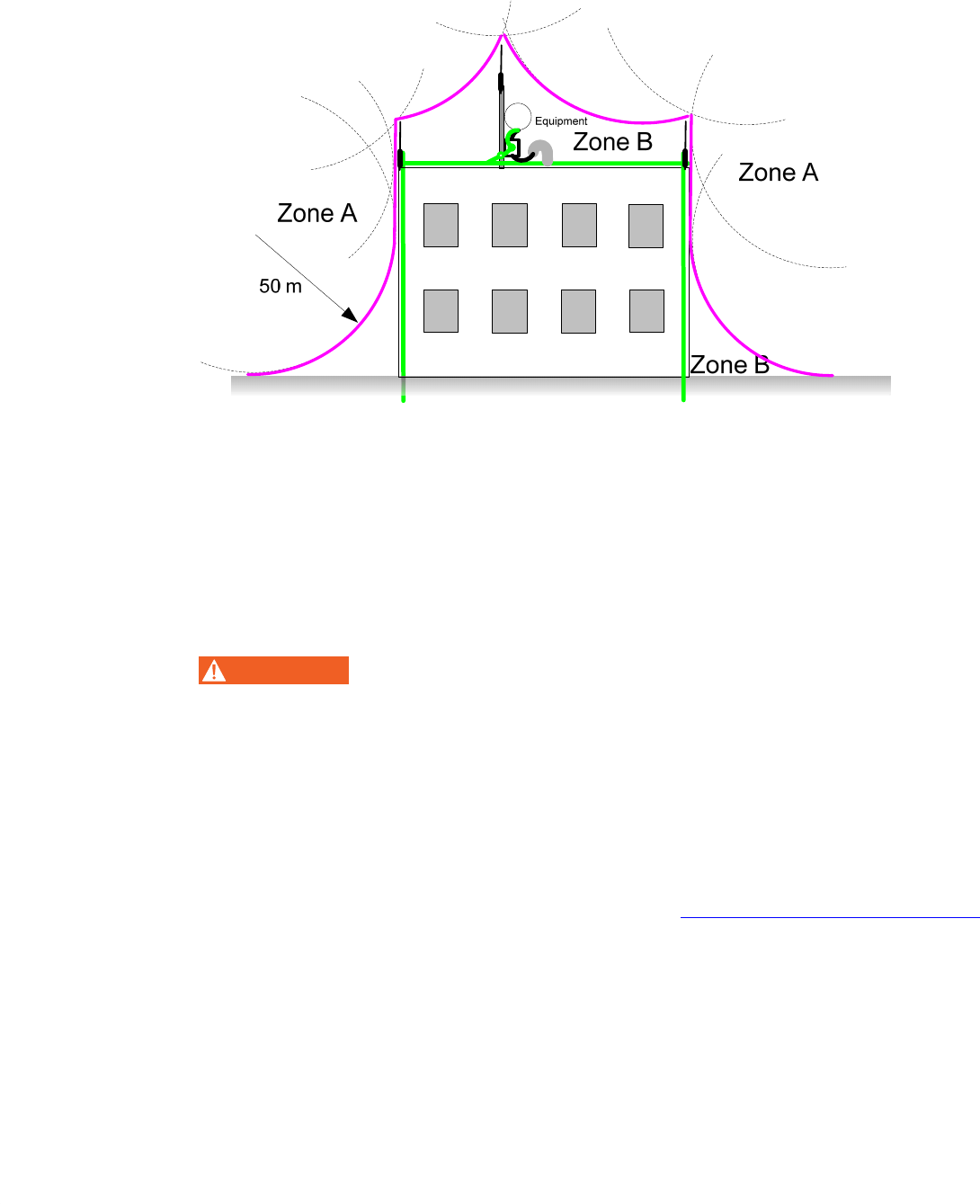
Grounding and lightning protect ion Chapt er 2 Planning consider at ions
phn- 2 182_002v 000
2-12 May 2011
Figure 2 - 1 Rolling sphere m ethod to determ ine t he light ning protect ion zones
Assess locations on masts, towers and buildings to determine if the location is in Zone
A or Zone B:
• Zone A: In this zone a direct lightning strike is possible. Do not mount equipment
in this zone.
• Zone B: In this zone, direct EMD (lightning) effects are still possible, but
mounting in this zone significantly reduces the possibility of a direct strike.
Mount equipment in this zone.
WARNING
Never mount equipment in Zone A. Mounting in Zone A may put
equipment, structures and life at risk.
Ge nera l protection requir e m e nt s
Apply the practices and procedures detailed in manual
R56 Standards And Guidelines
For Communication Sites
(available for download at www.motorola.com/ptp/software)
to all new site build activities.
PTP 250 User Guide Grounding and light ning pr otect ion
phn- 2182_002v000
May 2011 2-13
Ba sic r e quir e m ent s
The following basic protection requirements must be implemented:
• The ODU must be in ‘Zone B’ (see Lightning protection zones on page 2-11).
• A lightning protection unit (LPU) must be installed within 600 mm (24 in) of the
point at which the drop cable enters the building or equipment room.
• The drop cable must be bonded to the supporting structure in order to prevent
lightning creating a potential between the structure and cable, which could
cause arcing, resulting in fire risk and damage to equipment.
• The drop cable must be grounded at the building entry point.
• The drop cable must not be laid alongside a lightning air terminal.
• All grounding cables must be a minimum size of 10 mm2 csa (8AWG), preferably
16 mm2 csa (6AWG), or 25 mm2 csa (4AWG).
Grounding ca ble require m ent s
When routing, fastening and connecting grounding cables, the following requirements
must be implemented:
• Grounding conductors must be run as short, straight, and smoothly as possible,
with the fewest possible number of bends and curves.
• Grounding cables must not be installed with drip loops.
• All bends must have a minimum radius of 203 mm (8 in) and a minimum angle of
90° (Figure 2-2). A diagonal run is preferable to a bend, even though it does not
follow the contour or run parallel to the supporting structure.
• All bends, curves and connections must be routed towards the grounding
electrode system, ground rod, or ground bar.
• Grounding conductors must be securely fastened.
• Braided grounding conductors must not be used.
• Approved bonding techniques must be used for the connection of dissimilar
metals.
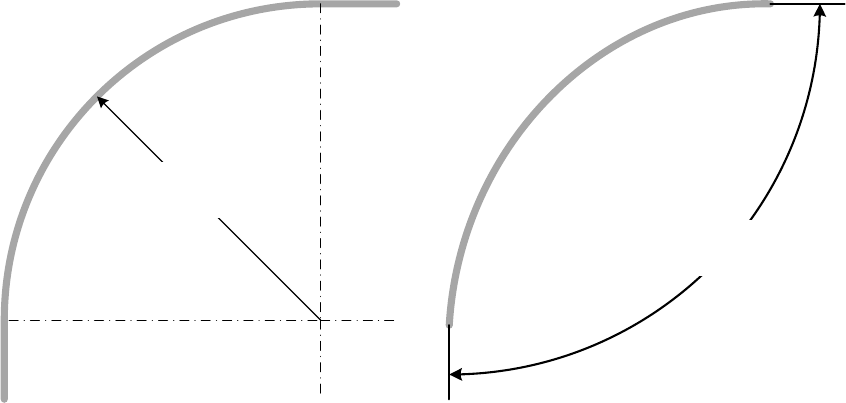
Grounding and lightning protect ion Chapt er 2 Planning consider at ions
phn- 2 182_002v 000
2-14 May 2011
Figure 2 - 2 Grounding cable m inim um bend radius and angle
Radius not less
than 203 mm (8 in)
Angle not less
than 90°
OD U r e quire m ent s
The following ODU protection requirements must be implemented:
• The ODU must be grounded to the supporting structure.
Prot ection requir e m ent s for a m a st or t ow er insta lla t ion
If the ODU is to be mounted on a metal tower or mast, then in addition to the general
protection requirements (above), the following requirements must be observed:
• The equipment must be lower than the top of the tower or its lightning air
terminal.
• The metal tower or mast must be correctly grounded.
• A grounding kit must be installed at the first point of contact between the drop
cable and the tower, near the top.
• A grounding kit must be installed at the bottom of the tower, near the vertical to
horizontal transition point. This grounding kit must be bonded to the tower or
tower ground bus bar (TGB), if installed.
• If the tower is greater than 61 m (200 ft) in height, an additional grounding kit
must be installed at the tower midpoint. Additional ground kits must be installed
as necessary to reduce the distance between ground kits to 61 m (200 ft) or less.
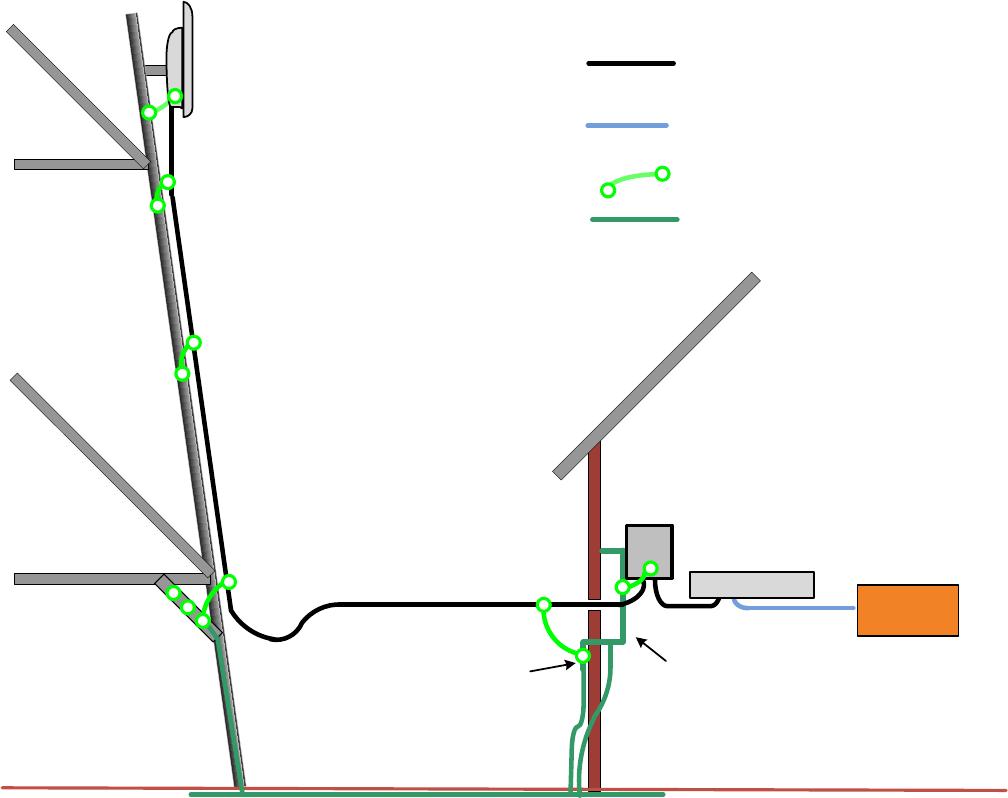
PTP 250 User Guide Grounding and light ning pr otect ion
phn- 2182_002v000
May 2011 2-15
• In high lightning prone geographical areas, additional ground kits should be
installed at spacing between 15 to 22 m (50 to 75 ft). This is especially important
on towers taller than 45 m (150 ft).
A schematic example of a mast or tower installation is shown in Figure 2-3.
Figure 2 - 3 Grounding and light ning protect ion on m ast or t ower
LPU
Tower
ground bar
External
ground bar
Master
ground bar
Ground ring
Outdoor CAT5e cable: gel-filled,
shielded with copper-plated steel
First point of contact with tower
Mid-point of tower
Bottom of tower
CAT5e cable: foil or braid screened,
with screened connectors
PoE Injector
Equipment building
Network
switch
ODU
PTP 250 ground cable
Tower/building ground system
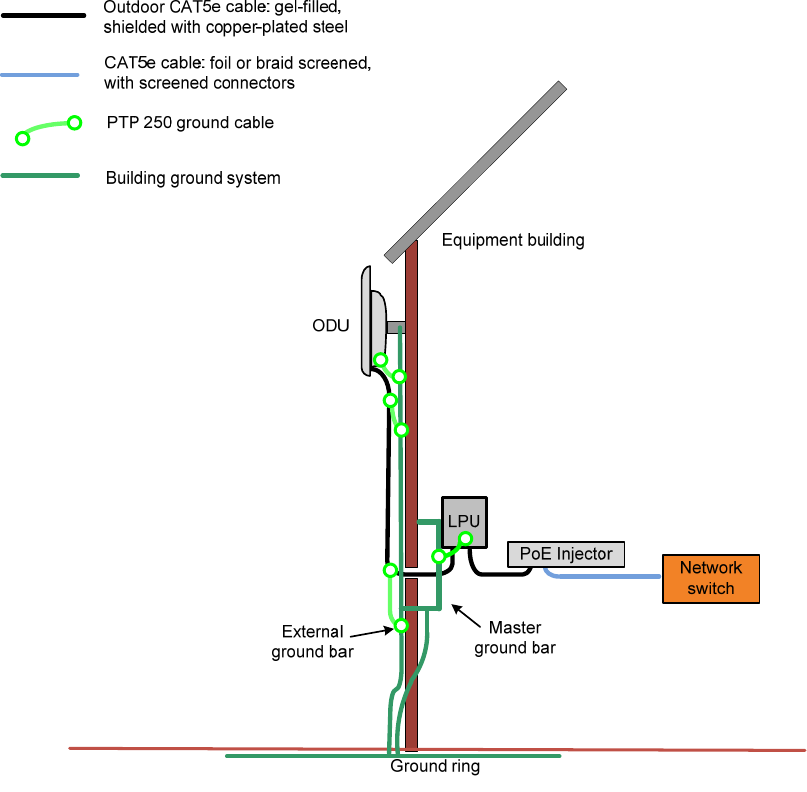
Grounding and lightning protect ion Chapt er 2 Planning consider at ions
phn- 2 182_002v 000
2-16 May 2011
Prot ection requir e m ent s for a w all inst a lla t ion
If the ODU is to be mounted on the wall of a building, then in addition to the general
protection requirements (above), the following requirements must be observed:
• The equipment must be lower than the top of the building or its lightning air
terminal.
• The building must be correctly grounded.
A schematic example of a wall installation is shown in Figure 2-4.
Figure 2 - 4 Grounding and light ning protect ion on wall
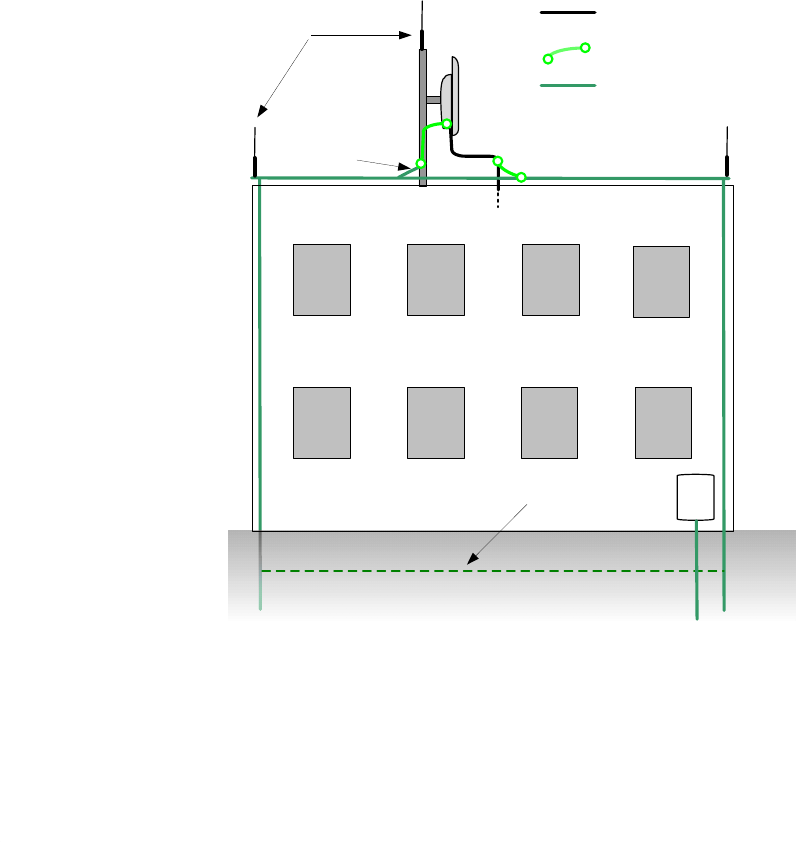
PTP 250 User Guide Grounding and light ning pr otect ion
phn- 2182_002v000
May 2011 2-17
Prot ection requir e m ent s on a high r ise building
If the ODU is to be mounted on a high rise building, it is likely that cable entry is at
roof level (Figure 2-5) and the equipment room is several floors below (Figure 2-6). In
addition to the general protection requirements (above), the following requirements
must be observed:
• The ODU must be below the lightning terminals and finials.
• A grounding conductor must be installed around the roof perimeter, to form the
main roof perimeter lightning protection ring.
• Air terminals are typically installed along the length of the main roof perimeter
lightning protection ring typically every 6.1 m (20 ft).
• The main roof perimeter lightning protection ring must contain at least two down
conductors connected to the grounding electrode system. The down conductors
should be physically separated from one another, as far as practical.
Figure 2 - 5 Grounding and lightning prot ect ion on building
Air terminal (finial)
Tower grounding
conductor
Building ground ring AC
service
ODU
To equipment area
CAT5e cable: gel-filled, shielded
with copper-plated steel
PTP 250 ground cables
Building ground system
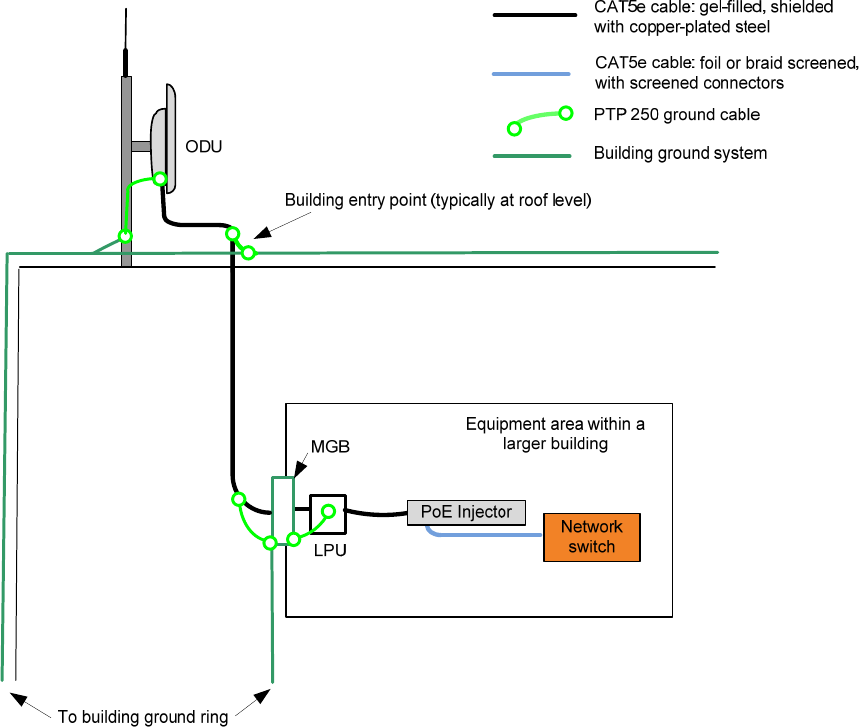
Grounding and lightning protect ion Chapt er 2 Planning consider at ions
phn- 2 182_002v 000
2-18 May 2011
Prot ection inside a h igh r ise building
The following protection requirements must be observed inside multi-story or high rise
buildings (Figure 2-6):
• The drop cable shield must be bonded to the building grounding system at the
entry point to the building.
• The drop cable shield must be bonded to the building grounding system at the
entry point to the equipment area.
• An LPU must be installed within 600 mm (24 in) of the entry point to the
equipment area.
Figure 2 - 6 Grounding and lightning prot ect ion inside high building
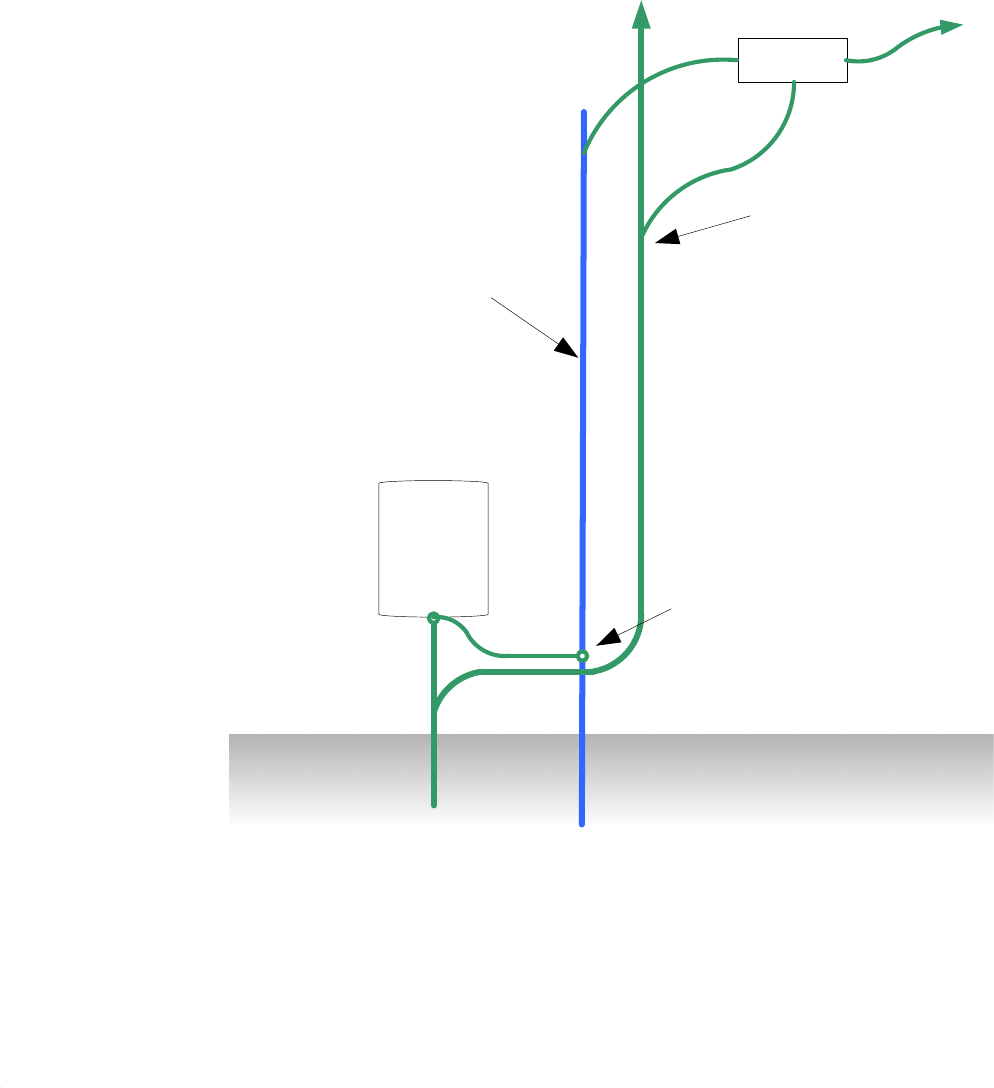
PTP 250 User Guide Grounding and light ning pr otect ion
phn- 2182_002v000
May 2011 2-19
Connect ing t o t he grounding conduct or
Figure 2-7 and Figure 2-8 illustrate the techniques employed to provide equipment
grounding in high rise buildings. A steel component of the building can be used as a
grounding conductor, provided it is part of the structural building steel and is
effectively grounded.
Figure 2 - 7 Grounding in a high rise building – building st eel not av ailable
To Tower or Mast
ODU on different floor than AC service feed, building steel not available
AC
Service
MGB
To ODU
Connection from
antenna is made below
the MGB
Water pipe
Water pipe effectively
grounded
Master Ground bar
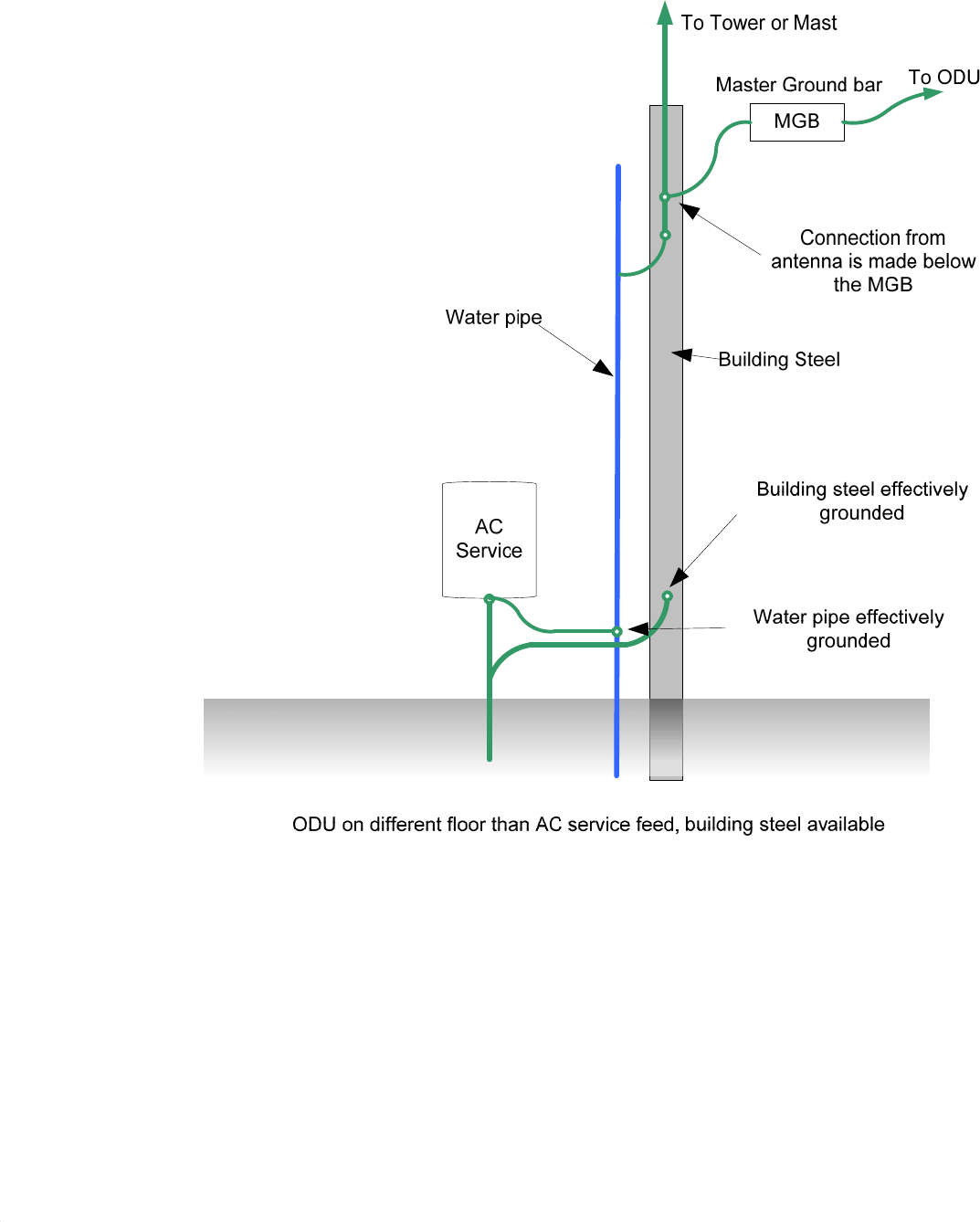
Grounding and lightning protect ion Chapt er 2 Planning consider at ions
phn- 2 182_002v 000
2-20 May 2011
Figure 2 - 8 Grounding in a high rise building – building st eel available

PTP 250 User Guide Dat a network planning
phn- 2182_002v000
May 2011 2-21
Da t a ne t w ork planning
This section describes factors to be considered when planning PTP 250 data networks.
I P int erfa ce
Choose an IP address for the IP interface of the ODU management agent. The IP
address must be unique and valid for the connected network segment.
Ensure that the design of the data network permits bi-directional routing of IP
datagrams between network management systems and the ODUs. For example, ensure
that the gateway IP address identifies a router or other gateway that provides access
to the rest of the data network.
Back t o back link s
Do not use direct cabled connections between the data ports of two PoE power
supplies. Where two or more links are deployed in a chain, always use an Ethernet
switch or router to interconnect the links at a relay point.
‘Green Et hernet ’ sw it ches
Do not connect PTP 250 units to Ethernet networking products that control the level of
the transmitted Ethernet signal based on the measured length of the Ethernet link, for
example Green Ethernet products manufactured by D-Link Corporation. The Ethernet
interfaces in these networking products do not work correctly when connected directly
to the PoE power supply.
Dat a net work planning Chapt er 2 Planning consider at ions
phn- 2 182_002v 000
2-22 May 2011

Cha pt e r 3
phn- 2182_002v000
May 2011 3-1
Chapt er 3 Lega l inform a t ion
. . . . . . . . . . . . . . . . . . . . . . . . . . . . . . . . . . . . . . . . . . . . . . . . . . . . . . . . . . . .
.
.
.
.
This chapter provides legal notices including software license agreements.
CAUTION
Intentional or unintentional changes or modifications to the equipment must
not be made unless under the express consent of the party responsible for
compliance. Any such modifications could void the user’s authority to
operate the equipment and will void the manufacturer’s warranty.
The following topics are described in this chapter:
• Motorola Solutions, Inc. end user license agreement on page 3-2
• Hardware warranty on page 3-9
• Limit of liability on page 3-10

Mot orola Solutions, I nc. end user license agr eem ent Chapt er 3 Legal inform at ion
phn- 2 182_002v 000
3-2 May 2011
Mot orola Solut ions, I nc. e nd user license agreem ent
In connection with Motorola’s delivery of certain proprietary software or products
containing embedded or pre-loaded proprietary software, or both, Motorola is willing
to license this certain proprietary software and the accompanying documentation to
you only on the condition that you accept all the terms in this End User License
Agreement (“Agreement”).
IF YOU DO NOT AGREE TO THE TERMS OF THIS AGREEMENT, DO NOT USE THE
PRODUCT OR INSTALL THE SOFTWARE. INSTEAD, YOU MAY, FOR A FULL
REFUND, RETURN THIS PRODUCT TO THE LOCATION WHERE YOU ACQUIRED IT
OR PROVIDE WRITTEN VERIFICATION OF DELETION OF ALL COPIES OF THE
SOFTWARE. ANY USE OF THE SOFTWARE, INCLUDING BUT NOT LIMITED TO USE
ON THE PRODUCT, WILL CONSTITUTE YOUR ACCEPTANCE TO THE TERMS OF
THIS AGREEMENT.
Definit ions
In this Agreement, the word “Software” refers to the set of instructions for computers,
in executable form and in any media, (which may include diskette, CD-ROM,
downloadable internet, hardware, or firmware) licensed to you. The word
“Documentation” refers to electronic or printed manuals and accompanying
instructional aids licensed to you. The word “Product” refers to Motorola’s MOTOwi4™
fixed wireless broadband devices for which the Software and Documentation is
licensed for use.
Gr a nt of license
Motorola Solutions, Inc. (“Motorola”) grants you (“Licensee” or “you”) a personal,
nonexclusive, non-transferable license to use the Software and Documentation subject
to the Conditions of Use set forth in “Conditions of use” and the terms and conditions
of this Agreement. Any terms or conditions relating to the Software and
Documentation appearing on the face or reverse side of any purchase order, purchase
order acknowledgment or other order document that are different from, or in addition
to, the terms of this Agreement will not be binding on the parties, even if payment is
accepted.
PTP 250 User Guide Mot orola Solut ions, I nc. end user license agreem ent
phn- 2182_002v000
May 2011 3-3
Condit ions of use
Any use of the Software and Documentation outside of the conditions set forth in this
Agreement is strictly prohibited and will be deemed a breach of this Agreement.
1. Only you, your employees or agents may use the Software and Documentation.
You will take all necessary steps to insure that your employees and agents abide
by the terms of this Agreement.
2. You will use the Software and Documentation (i) only for your internal
business purposes; (ii) only as described in the Software and Documentation; and
(iii) in strict accordance with this Agreement.
3. You may use the Software and Documentation, provided that the use is in
conformance with the terms set forth in this Agreement.
4. Portions of the Software and Documentation are protected by United States
copyright laws, international treaty provisions, and other applicable laws.
Therefore, you must treat the Software like any other copyrighted material (for
example, a book or musical recording) except that you may either: (i) make 1
copy of the transportable part of the Software (which typically is supplied on
diskette, CD-ROM, or downloadable internet), solely for back-up purposes; or
(ii) copy the transportable part of the Software to a PC hard disk, provided you
keep the original solely for back-up purposes. If the Documentation is in printed
form, it may not be copied. If the Documentation is in electronic form, you may
print out 1 copy, which then may not be copied. With regard to the copy made
for backup or archival purposes, you agree to reproduce any Motorola copyright
notice, and other proprietary legends appearing thereon. Such copyright
notice(s) may appear in any of several forms, including machine-readable form,
and you agree to reproduce such notice in each form in which it appears, to the
extent it is physically possible to do so. Unauthorized duplication of the Software
or Documentation constitutes copyright infringement, and in the United States is
punishable in federal court by fine and imprisonment.
5. You will not transfer, directly or indirectly, any product, technical data or
software to any country for which the United States Government requires an
export license or other governmental approval without first obtaining such
license or approval.
Mot orola Solutions, I nc. end user license agr eem ent Chapt er 3 Legal inform at ion
phn- 2 182_002v 000
3-4 May 2011
Tit le a nd restrictions
If you transfer possession of any copy of the Software and Documentation to another
party outside of the terms of this agreement, your license is automatically terminated.
Title and copyrights to the Software and Documentation and any copies made by you
remain with Motorola and its licensors. You will not, and will not permit others to:
(i) modify, translate, decompile, bootleg, reverse engineer, disassemble, or extract the
inner workings of the Software or Documentation, (ii) copy the look-and-feel or
functionality of the Software or Documentation; (iii) remove any proprietary notices,
marks, labels, or logos from the Software or Documentation; (iv) rent or transfer all or
some of the Software or Documentation to any other party without Motorola’s prior
written consent; or (v) utilize any computer software or hardware which is designed to
defeat any copy protection device, should the Software and Documentation be
equipped with such a protection device. If the Software and Documentation is
provided on multiple types of media (such as diskette, CD-ROM, downloadable
internet), then you will only use the medium which best meets your specific needs, and
will not loan, rent, lease, or transfer the other media contained in the package without
Motorola’s written consent. Unauthorized copying of the Software or Documentation,
or failure to comply with any of the provisions of this Agreement, will result in
automatic termination of this license.
Confident ialit y
You acknowledge that all Software and Documentation contain valuable proprietary
information and trade secrets and that unauthorized or improper use of the Software
and Documentation will result in irreparable harm to Motorola for which monetary
damages would be inadequate and for which Motorola will be entitled to immediate
injunctive relief. If applicable, you will limit access to the Software and
Documentation to those of your employees and agents who need to use the Software
and Documentation for your internal business purposes, and you will take appropriate
action with those employees and agents to preserve the confidentiality of the Software
and Documentation, using the same degree of care to avoid unauthorized or improper
disclosure as you use for the protection of your own proprietary software, but in no
event less than reasonable care.
You have no obligation to preserve the confidentiality of any proprietary information
that: (i) was in the public domain at the time of disclosure; (ii) entered the public
domain through no fault of yours; (iii) was given to you free of any obligation to keep it
confidential; (iv) is independently developed by you; or (v) is disclosed as required by
law provided that you notify Motorola prior to such disclosure and provide Motorola
with a reasonable opportunity to respond.
PTP 250 User Guide Mot orola Solut ions, I nc. end user license agreem ent
phn- 2182_002v000
May 2011 3-5
Right t o use M ot or ola’s na m e
Except as required in “Conditions of use”, you will not, during the term of this
Agreement or thereafter, use any trademark of Motorola, or any word or symbol likely
to be confused with any Motorola trademark, either alone or in any combination with
another word or words.
Transfe r
The Software and Documentation may not be transferred to another party without the
express written consent of Motorola, regardless of whether or not such transfer is
accomplished by physical or electronic means. Motorola’s consent may be withheld at
its discretion and may be conditioned upon transferee paying all applicable license
fees and agreeing to be bound by this Agreement.
Updat e s
During the first 12 months after purchase of a Product, or during the term of any
executed Maintenance and Support Agreement for the Product, you are entitled to
receive Updates. An “Update” means any code in any form which is a bug fix, patch,
error correction, or minor enhancement, but excludes any major feature added to the
Software. Updates are available for download at
http://www.motorola.com/ptp/software.
Major features may be available from time to time for an additional license fee. If
Motorola makes available to you major features and no other end user license
agreement is provided, then the terms of this Agreement will apply.
Maint ena nce
Except as provided above, Motorola is not responsible for maintenance or field service
of the Software under this Agreement.
Mot orola Solutions, I nc. end user license agr eem ent Chapt er 3 Legal inform at ion
phn- 2 182_002v 000
3-6 May 2011
D iscla im er
MOTOROLA DISCLAIMS ALL WARRANTIES OF ANY KIND, WHETHER EXPRESS,
IMPLIED, STATUTORY, OR IN ANY COMMUNICATION WITH YOU. MOTOROLA
SPECIFICALLY DISCLAIMS ANY WARRANTY INCLUDING THE IMPLIED WARRANTIES
OF MERCHANTABILTY, NONINFRINGEMENT, OR FITNESS FOR A PARTICULAR
PURPOSE. THE SOFTWARE AND DOCUMENTATION ARE PROVIDED “AS IS.”
MOTOROLA DOES NOT WARRANT THAT THE SOFTWARE WILL MEET YOUR
REQUIREMENTS, OR THAT THE OPERATION OF THE SOFTWARE WILL BE
UNINTERRUPTED OR ERROR FREE, OR THAT DEFECTS IN THE SOFTWARE WILL
BE CORRECTED. MOTOROLA MAKES NO WARRANTY WITH RESPECT TO THE
CORRECTNESS, ACCURACY, OR RELIABILITY OF THE SOFTWARE AND
DOCUMENTATION. Some jurisdictions do not allow the exclusion of implied
warranties, so the above exclusion may not apply to you.
Lim it a t ion of lia bilit y
THE TOTAL LIABILITY OF MOTOROLA UNDER THIS AGREEMENT FOR DAMAGES
WILL NOT EXCEED THE TOTAL AMOUNT PAID BY YOU FOR THE PRODUCT
LICENSED UNDER THIS AGREEMENT. IN NO EVENT WILL MOTOROLA BE LIABLE
IN ANY WAY FOR INCIDENTAL, CONSEQUENTIAL, INDIRECT, SPECIAL OR
PUNITIVE DAMAGES OF ANY NATURE, INCLUDING WITHOUT LIMITATION, LOST
BUSINESS PROFITS, OR LIABILITY OR INJURY TO THIRD PERSONS, WHETHER
FORESEEABLE OR NOT, REGARDLESS OF WHETHER MOTOROLA HAS BEEN
ADVISED OF THE POSSIBLITY OF SUCH DAMAGES. Some jurisdictions do not permit
limitations of liability for incidental or consequential damages, so the above exclusions
may not apply to you.
PTP 250 User Guide Mot orola Solut ions, I nc. end user license agreem ent
phn- 2182_002v000
May 2011 3-7
U.S. governm ent
If you are acquiring the Product on behalf of any unit or agency of the U.S.
Government, the following applies. Use, duplication, or disclosure of the Software and
Documentation is subject to the restrictions set forth in subparagraphs (c) (1) and (2)
of the Commercial Computer Software – Restricted Rights clause at FAR 52.227-19
(JUNE 1987), if applicable, unless being provided to the Department of Defense. If
being provided to the Department of Defense, use, duplication, or disclosure of the
Products is subject to the restricted rights set forth in subparagraph (c) (1) (ii) of the
Rights in Technical Data and Computer Software clause at DFARS 252.227-7013 (OCT
1988), if applicable. Software and Documentation may or may not include a Restricted
Rights notice, or other notice referring specifically to the terms and conditions of this
Agreement. The terms and conditions of this Agreement will each continue to apply,
but only to the extent that such terms and conditions are not inconsistent with the
rights provided to you under the aforementioned provisions of the FAR and DFARS, as
applicable to the particular procuring agency and procurement transaction.
Ter m of license
Your right to use the Software will continue in perpetuity unless terminated as follows.
Your right to use the Software will terminate immediately without notice upon a
breach of this Agreement by you. Within 30 days after termination of this Agreement,
you will certify to Motorola in writing that through your best efforts, and to the best of
your knowledge, the original and all copies, in whole or in part, in any form, of the
Software and all related material and Documentation, have been destroyed, except
that, with prior written consent from Motorola, you may retain one copy for archival or
backup purposes. You may not sublicense, assign or transfer the license or the
Product, except as expressly provided in this Agreement. Any attempt to otherwise
sublicense, assign or transfer any of the rights, duties or obligations hereunder is null
and void.
Gove r ning la w
This Agreement is governed by the laws of the United States of America to the extent
that they apply and otherwise by the laws of the State of Illinois.
Assignm ent
This agreement may not be assigned by you without Motorola’s prior written consent.

Mot orola Solutions, I nc. end user license agr eem ent Chapt er 3 Legal inform at ion
phn- 2 182_002v 000
3-8 May 2011
Surviva l of pr ovisions
The parties agree that where the context of any provision indicates an intent that it
survives the term of this Agreement, then it will survive.
Ent ire agreem ent
This agreement contains the parties’ entire agreement regarding your use of the
Software and may be amended only in writing signed by both parties, except that
Motorola may modify this Agreement as necessary to comply with applicable laws.
Thir d pa r t y soft w a r e
The software may contain one or more items of Third-Party Software supplied by other
third-party suppliers. The terms of this Agreement govern your use of any Third-Party
Software UNLESS A SEPARATE THIRD-PARTY SOFTWARE LICENSE IS INCLUDED,
IN WHICH CASE YOUR USE OF THE THIRD-PARTY SOFTWARE WILL THEN BE
GOVERNED BY THE SEPARATE THIRD-PARTY LICENSE.
Tr a de m a r k s
Java™ Technology and/or J2ME™ : Java and all other Java-based marks are trademarks
or registered trademarks of Sun Microsystems, Inc. in the U.S. and other countries.
Licen ses and at t r ibut ion s
The document
PTP 250 Third Party Licenses and Attributions
(available for download
at www.motorola.com/ptp/software) contains licenses and attributions for third party
software components that are incorporated into the PTP 250 product.
To gain access to source code licensed under the GPL, please contact Motorola via the
support web site at www.Motorola.com/ptp/support/contact.

PTP 250 User Guide Hardware warrant y
phn- 2182_002v000
May 2011 3-9
Hardw are w arrant y
Motorola’s standard hardware warranty is for one (1) year from date of shipment from
Motorola or a Motorola Point-to-Point Distributor. Motorola warrants that hardware
will conform to the relevant published specifications and will be free from material
defects in material and workmanship under normal use and service. Motorola shall
within this time, at its own option, either repair or replace the defective product within
thirty (30) days of receipt of the defective product. Repaired or replaced product will
be subject to the original warranty period but not less than thirty (30) days.

Lim it of liability Chapt er 3 Legal infor m at ion
phn- 2 182_002v 000
3-10 May 2011
Lim it of liabilit y
IN NO EVENT SHALL MOTOROLA BE LIABLE TO YOU OR ANY OTHER PARTY FOR
ANY DIRECT, INDIRECT, GENERAL, SPECIAL, INCIDENTAL, CONSEQUENTIAL,
EXEMPLARY OR OTHER DAMAGE ARISING OUT OF THE USE OR INABILITY TO
USE THE PRODUCT (INCLUDING, WITHOUT LIMITATION, DAMAGES FOR LOSS OF
BUSINESS PROFITS, BUSINESS INTERRUPTION, LOSS OF BUSINESS
INFORMATION OR ANY OTHER PECUNIARY LOSS, OR FROM ANY BREACH OF
WARRANTY, EVEN IF MOTOROLA HAS BEEN ADVISED OF THE POSSIBILITY OF
SUCH DAMAGES. (Some states do not allow the exclusion or limitation of incidental or
consequential damages, so the above exclusion or limitation may not apply to you.) IN
NO CASE SHALL MOTOROLA’S LIABILITY EXCEED THE AMOUNT YOU PAID FOR
THE PRODUCT.

Cha pt e r 4
phn- 2182_002v000
May 2011 4-1
Chapt er 4 Reference inform a t ion
. . . . . . . . . . . . . . . . . . . . . . . . . . . . . . . . . . . . . . . . . . . . . . . . . . . . . . . . . . . .
.
.
.
.
This chapter describes the reference information and regulatory notices that apply to
the PTP 250.
The following reference topics are contained in this chapter:
• Installation inventories on page 4-2 lists the components required for PTP 250
installations, including ODUs, with Motorola part numbers.
• ODU specifications on page 4-10 contains specifications of the outdoor unit
(ODU) that is supplied by Motorola for PTP 250 installations.
• Power supply unit specifications on page 4-12 contains specifications of the PoE
power supply and PIDU that are supplied by Motorola for PTP 250 installations.
• Antenna specifications on page 4-14 contains specifications of the antennas that
are approved by the FCC for use with the connectorized ODUs.
• Wireless specifications on page 4-19 contains specifications of the PTP 250
wireless interface, including RF bands, channel width and link loss.
• Data network specifications on page 4-21 contains specifications of the PTP 250
Ethernet interface.
• Compliance with safety standards on page 4-22 lists the safety specifications
against which the PTP 250 has been tested and certified. It also describes how to
keep RF exposure within safe limits.
• Compliance with radio regulations on page 4-27 describes how the PTP 250
complies with the radio regulations that are in force in various countries.
• Notifications on page 4-33 contains notifications made to regulatory bodies for
the PTP 250.

I nst allation inventor ies Chapt er 4 Reference inform at ion
phn- 2 182_002v 000
4-2 May 2011
I nst allat ion invent ories
This section lists the components required for PTP 250 installations, including ODUs,
with Motorola part numbers.
PTP 2 5 0 kit s
The PTP 250 is supplied as a 'Link' or an 'End' kit. A ‘Link’ kit contains components for
both ends of a link (including two ODUs and two PoE power supply units). An 'End' kit
contains components for one end of a link (including one ODU and one PoE power
supply). The kits may contain either integrated ODUs (antennas included) or
connectorized ODUs (separate antennas must be purchased).
PTP 250 kits are supplied in two regional variants: one is for use in countries where
FCC or IC licensing restrictions apply (the USA and Canada), and the other is for use
in ETSI countries or the rest of the world (ETSI/RoW). Table 4-1 contains part numbers
for all kit variants. Table 4-2 lists PTP 250 kit components.
Table 4 - 1 PTP 250 kit part num bers
Fr eque ncy
var iant
Regional
var iant
I nt e gra t ed or
Conne ct or ize d
Link or
End Com plet e
Part
num ber
5.4 / 5.8 GHz ETSI/RoW
Integrated Link Complete WB3716
5.4 / 5.8 GHz ETSI/RoW
Integrated End Complete WB3717
5.4 / 5.8 GHz ETSI/RoW
Connectorized Link Complete WB3718
5.4 / 5.8 GHz ETSI/RoW
Connectorized End Complete WB3719
5.8 GHz FCC/IC Integrated Link Complete WB3720
5.8 GHz FCC/IC Integrated End Complete WB3721
5.8 GHz FCC/IC Connectorized Link Complete WB3722
5.8 GHz FCC/IC Connectorized End Complete WB3723
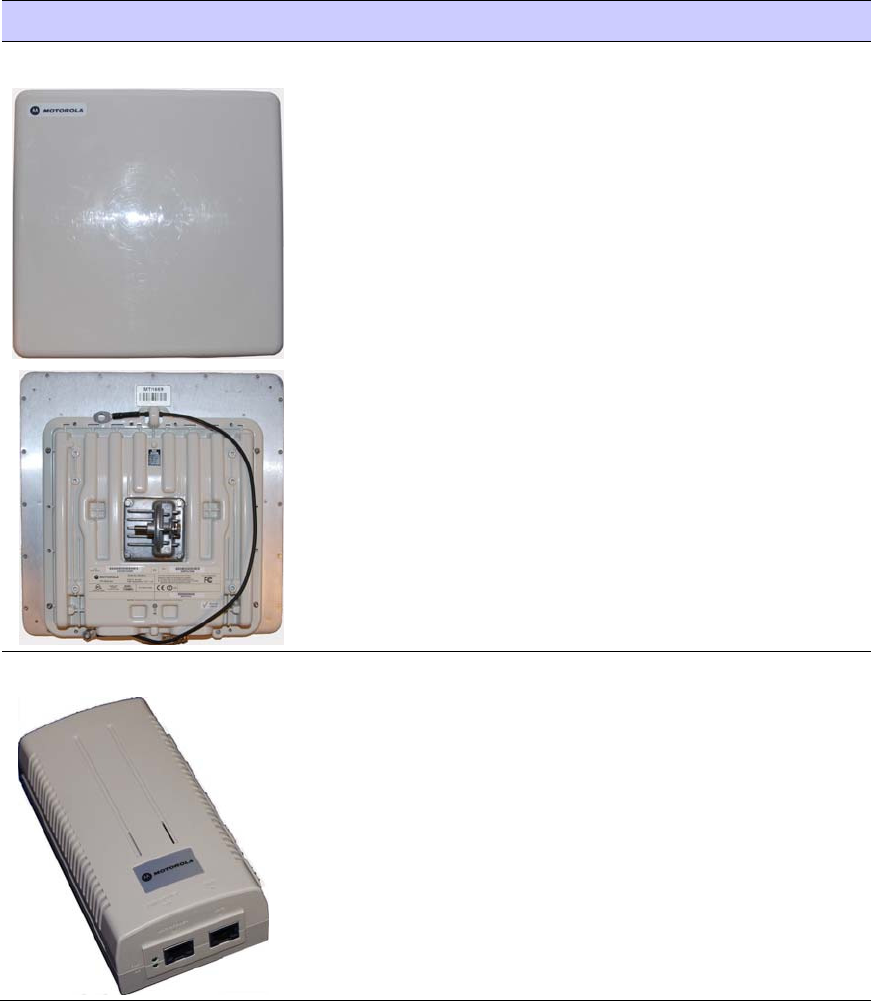
PTP 250 User Guide I nst allation invent ories
phn- 2182_002v000
May 2011 4-3
Table 4 - 2 I nvent ory for ODU and PoE power supply kits
I te m N ot es
ODUs
ODUs may be Integrated (as illustrated) or
Connectorized.
‘End Complete’ kit contains one ODU with
grounding cable.
‘Link Complete’ kit contains two ODUs
with grounding cables.
PoE power supply
‘End Complete’ kit contains one injector.
‘Link Complete’ kit contains two injectors.
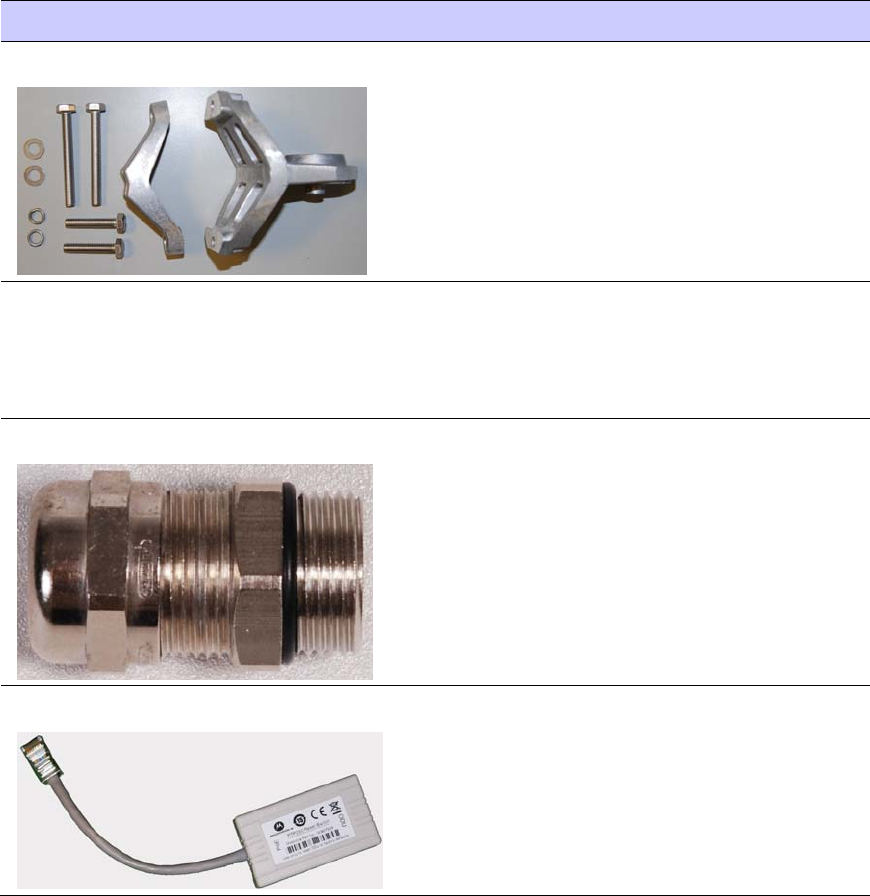
I nst allation inventor ies Chapt er 4 Reference inform at ion
phn- 2 182_002v 000
4-4 May 2011
I te m Not es
Mounting bracket assembly
‘End Complete’ kit contains one bracket.
‘Link Complete’ kit contains two brackets.
Choice of mains leads (US, UK and
EU)
‘End Complete’ kit contains one US, one
UK and one EU lead.
‘Link Complete’ kit contains two US, two
UK and two EU leads.
Cable gland
‘End Complete’ kit contains one gland.
‘Link Complete’ kit contains two glands.
Reset plug
‘End Complete’ kit contains one switch.
‘Link Complete’ kit contains two switches.
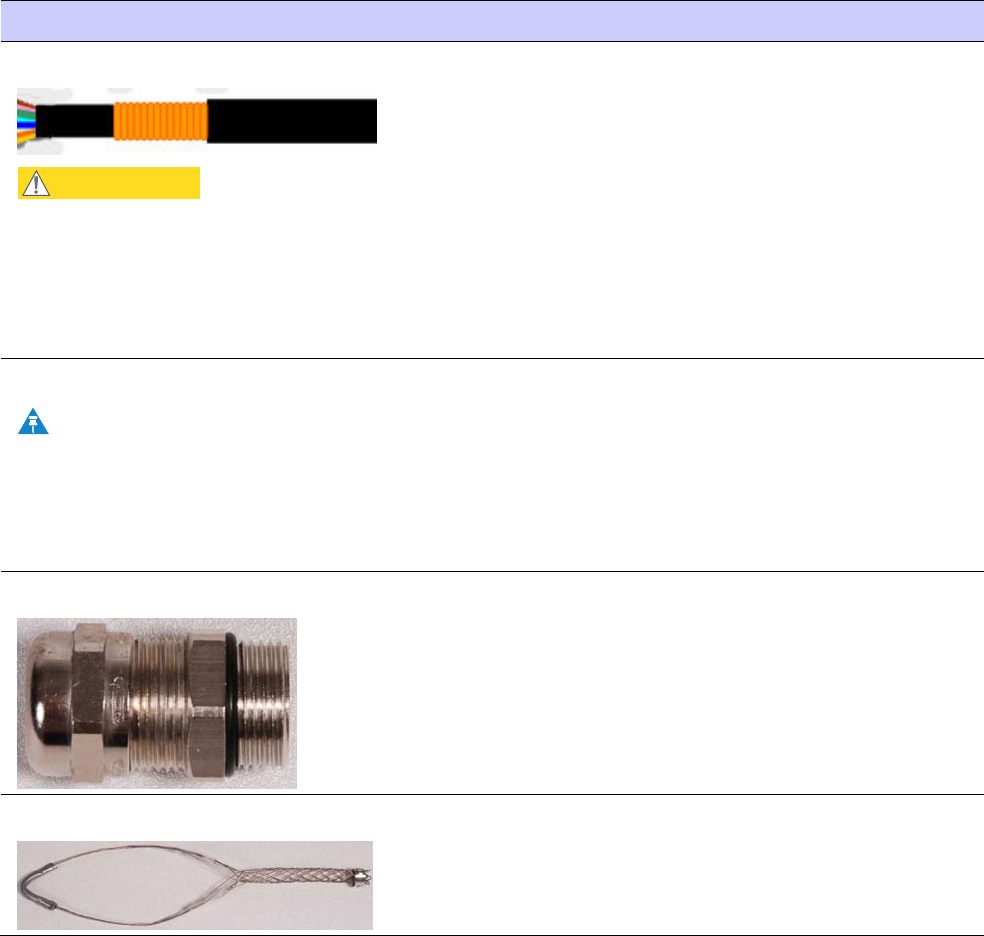
PTP 250 User Guide I nst allation invent ories
phn- 2182_002v000
May 2011 4-5
Ot he r st a nda r d com ponent s
In addition to ODU and PoE power supply kits, standard installations require the
components listed in Table 4-3.
Table 4 - 3 Additional inventory for st andard inst allat ions
I te m N ot es
Outdoor drop cable
CAUTION
Always use Cat5e cable that is gel-filled
and shielded with copper-plated steel.
Alternative types of drop cable are not
supported by Motorola.
Superior Essex BBDGe cable is available
from Motorola with the following lengths
and part numbers (other lengths are
available from Superior Essex):
‘1000 ft Reel Outdoor Copper Clad
CAT5E’. Motorola part number
WB3175.
‘328 ft (100 m) Reel Outdoor Copper
Clad CAT5E’. Motorola part number
WB3176.
RJ45 connectors
NOTE
The specified connectors, crimp tool and
die set are specific to Superior Essex
BBDGe cable (they may not work with
other types of cable).
‘Tyco/AMP, Mod Plug RJ45 Unscreened,
25 pk’. Motorola part number WB3177.
‘Tyco/AMP Crimp Tool’. Motorola part
number WB3211.
‘Tyco/AMP Die Set’. Available from Tyco,
part number 1-853400-0.
Cable glands
For protecting the drop cable entry points.
Glands are included in the ODU and LPU
kits, but additional glands may be
purchased from Motorola if required.
‘PTP SER EMC CABLE GLAND
(GROUNDING)’. Quantity 10. Motorola,
part number WB1811.
Cable hoisting grip
For hoisting the drop cable up to the ODU
without damaging the gland or RJ45 plug.
Not supplied by Motorola.
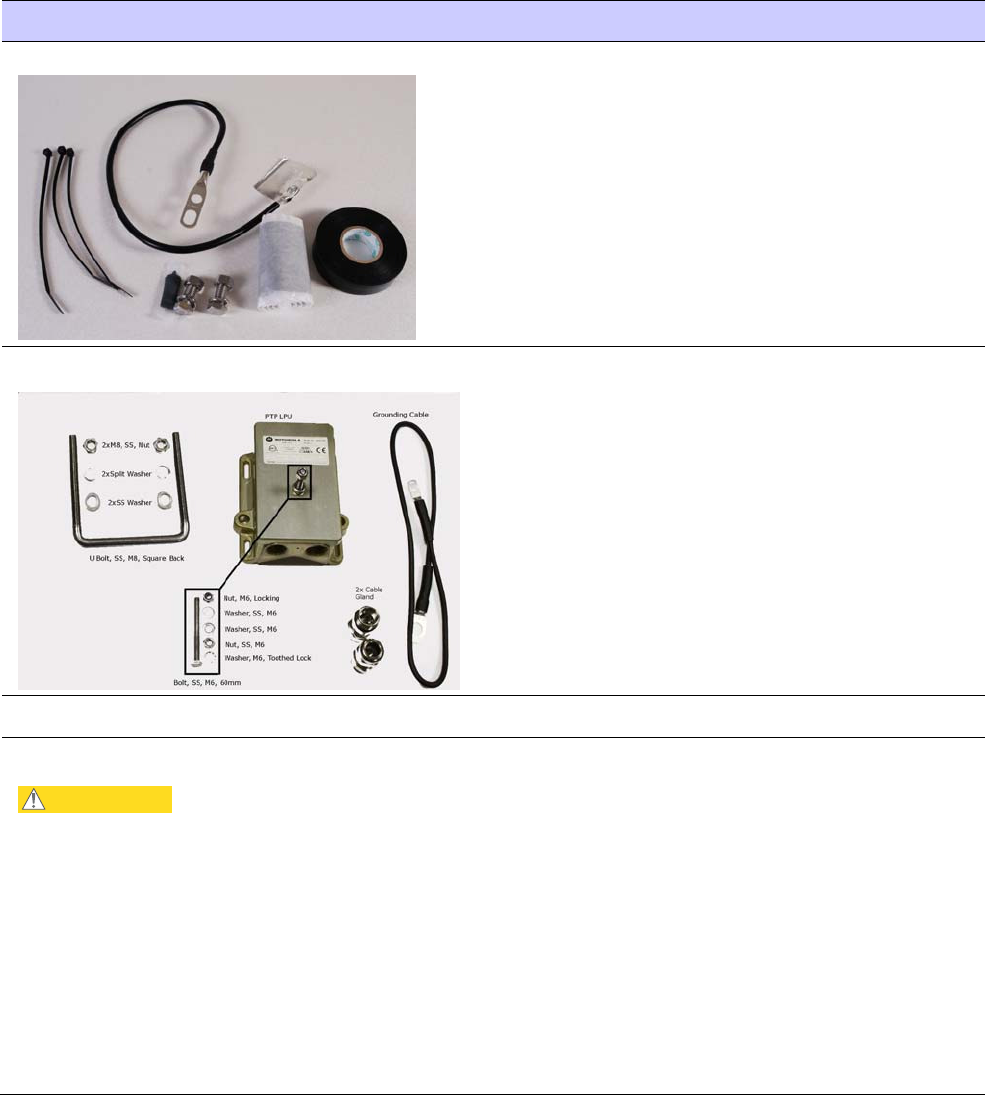
I nst allation inventor ies Chapt er 4 Reference inform at ion
phn- 2 182_002v 000
4-6 May 2011
I te m Not es
Cable grounding kits
One kit is required per drop cable
grounding point.
‘Cable Grounding Kits For 1/4" And 3/8"
Cable’. Motorola part number
01010419001.
Kit contents: grounding cable, self-
amalgamating tape, PVC tape, tie-wraps,
bolts, washers and nuts.
Lightning Protection Unit (LPU) kits
Two kits are required per standard link.
‘LPU End Kit PTP 250/300/500’. Motorola
part number WB2978D.
Kit contents: one LPU, one grounding
cable, nuts, bolts and two cable glands.
Cable ties, cable cleats For securing cables. Purchase separately.
Indoor CAT5e cable
CAUTION
The connected network equipment must
feature screened RJ45 connectors
and must be connected to ground,
otherwise the PoE power supply will not
be grounded.
To connect the PoE power supply to
network equipment, use screened cable
that meets this specification:
Screening: Must be either foil screen
(FTP) or braided screen (STP) cable.
Connectors: Must use screened RJ45
connectors with metal shells at both
ends.
Electrical connection: There must be
a continuous electrical connection
between both screened connectors.
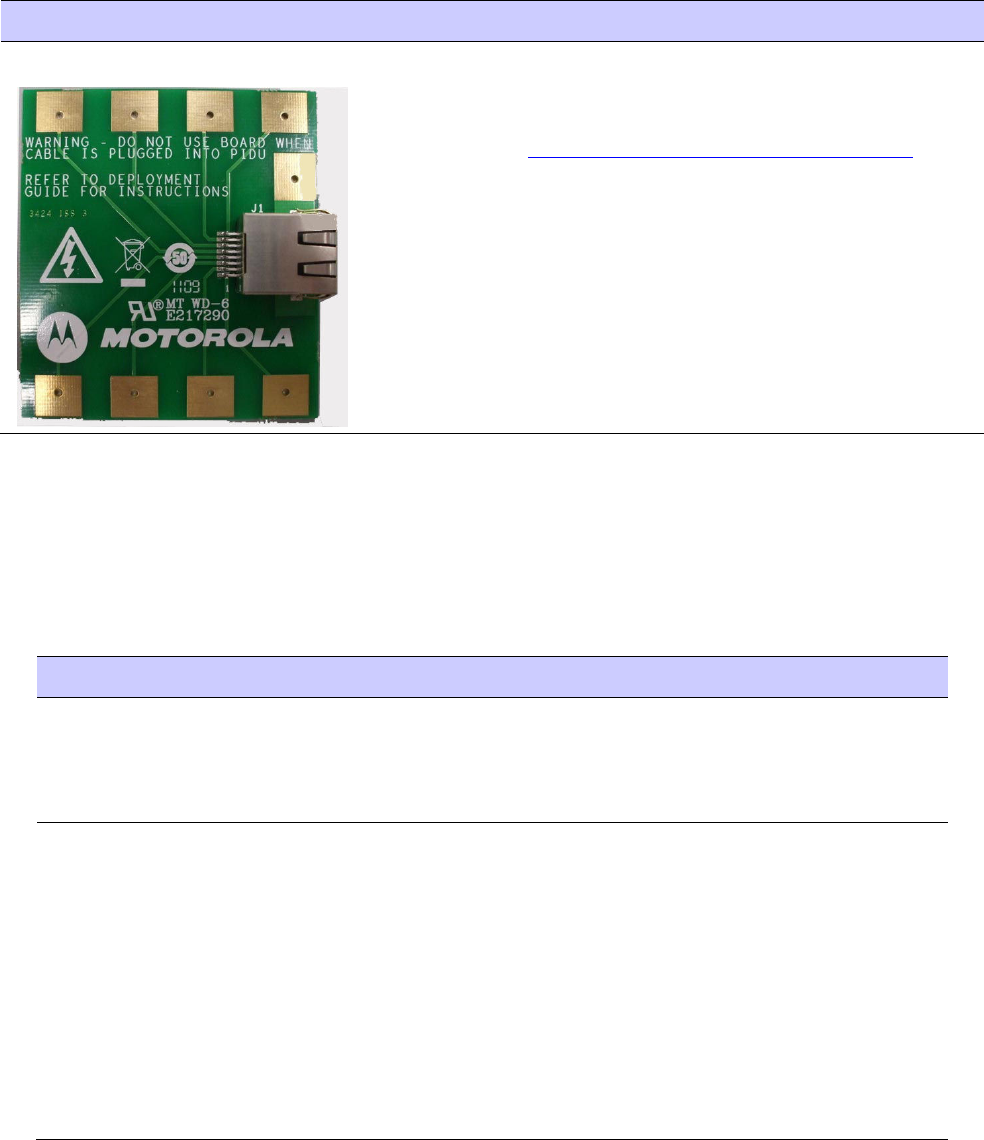
PTP 250 User Guide I nst allation invent ories
phn- 2182_002v000
May 2011 4-7
I te m N ot es
Drop cable tester
An optional item for testing the resistances
between the RJ45 pins of the drop cable.
Order from
http://www.motorola.com/ptp/support by
selecting Point-to-Point, Order Cable
Tester and completing the order form.
Com ponent s r e quired w it h connectorized ODUs
Connectorized ODUs require the additional components listed in Table 4-4.
Table 4 - 4 Additional inventory for connect orized ODUs
I te m N ot es
Antenna One required per link end (or two per link
end for spatial diversity). Not supplied by
Motorola. Approved antennas are listed in
Antenna specifications on page 4-14.
RF cable For connecting the ODU to the antenna. May
be cable of type LMR100, LMR200, LMR300,
LMR400 or LMR600. LMR400 is supplied by
Motorola:
‘50 Ohm Braided Coaxial Cable - 75
meter’. Motorola part number
30010194001.
‘50 Ohm Braided Coaxial Cable - 500
meter’. Motorola part number
30010195001.
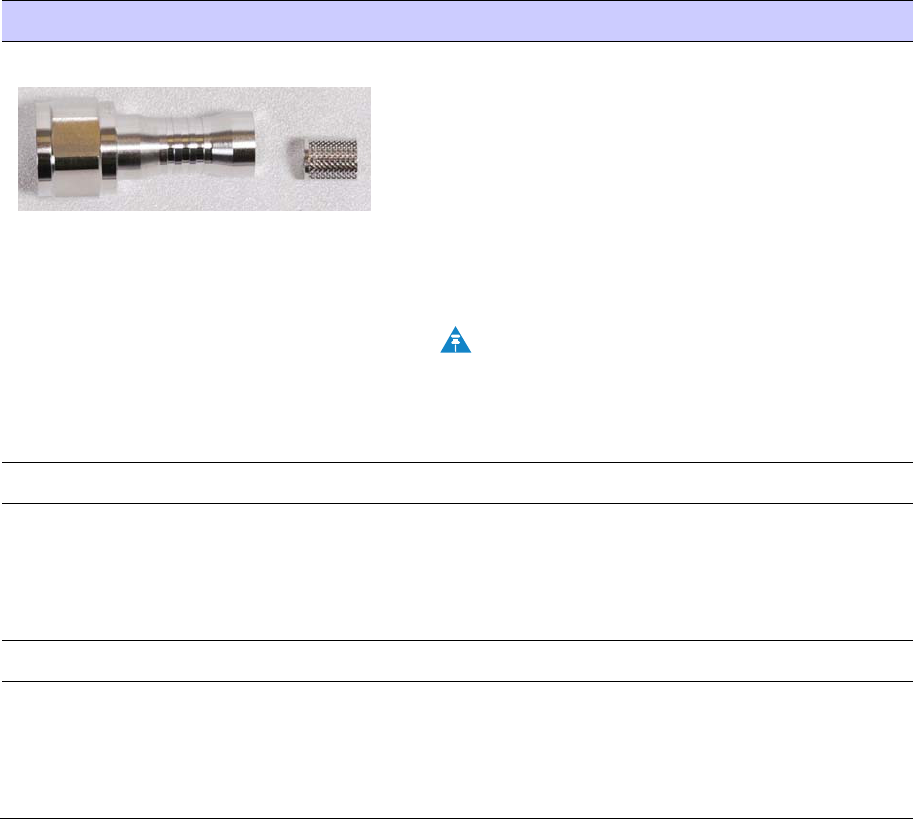
I nst allation inventor ies Chapt er 4 Reference inform at ion
phn- 2 182_002v 000
4-8 May 2011
I te m N ot es
N type male connectors
For connecting the RF cables to the ODU.
Two connectors required per ODU. Use
weatherproof connectors, preferably ones
that are supplied with adhesive lined heat
shrink sleeves that are fitted over the
cable/connector interface.
‘RF CONNECTOR,N,MALE,STRAIGHT FOR
CNT-400 CABLE’. Motorola part number
09010091001.
NOTE
For the antenna end of the RF cable,
refer to the antenna manufacturer’s
instructions.
Self-amalgamating and PVC tape To weatherproof the RF connectors.
Cable grounding kits One kit is required per antenna cable
grounding point.
Refer to Table 4-3 for specifications and part
numbers.
Cable ties, cable cleats For securing antenna cables.
Lightning arrestor For protecting the antenna cable at building
entry, when the ODU is mounted indoors.
One required per antenna cable.
For example: Polyphaser LSXL-ME or LSXL.
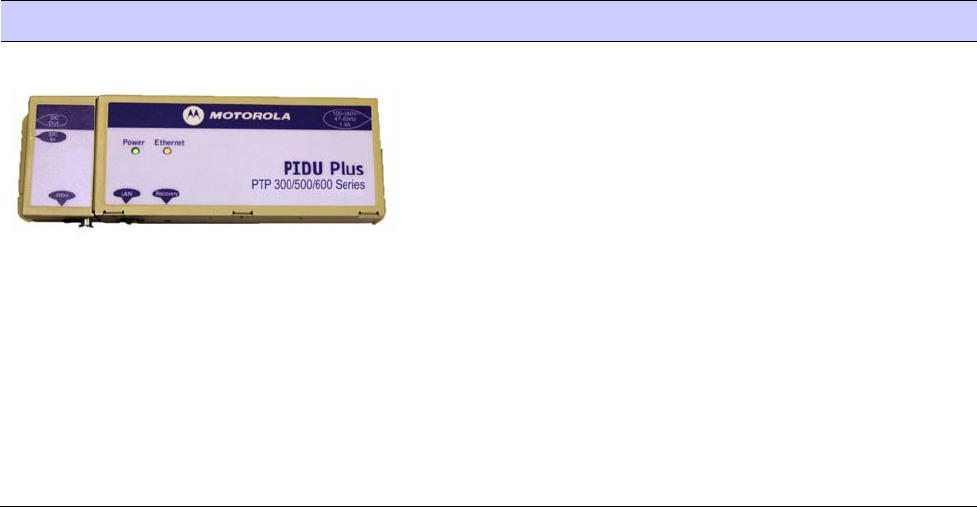
PTP 250 User Guide I nst allation invent ories
phn- 2182_002v000
May 2011 4-9
Alt erna t ive com ponent s
Some alternatives to standard PTP 250 components are listed in Table 4-5.
Table 4 - 5 Alt ernat ive PTP 250 com ponent s
I te m N ot es
Powered Indoor Unit (PIDU Plus)
This is the approved alternative to the PoE power
supply. It provides an interface to a -48 V DC power
supply.
‘PTP 300/500/600 Series PIDU with AUS Lead’,
Motorola part number WB3022.
‘PTP 300/500/600 Series PIDU with EU Lead’,
Motorola part number WB3023.
‘PTP 300/500/600 Series PIDU with UK Lead’,
Motorola part number WB3024.
‘PTP 300/500/600 Series PIDU with US Lead’,
Motorola part number WB3025.
For guidance on choosing the most suitable power
supply unit, refer to Power supply selection on page
2-4.

ODU specifications Chapt er 4 Reference infor m at ion
phn- 2 182_002v 000
4-10 May 2011
OD U specificat ions
This section contains specifications of the outdoor unit (ODU) that is supplied by
Motorola for PTP 250 installations. These specifications apply to all product variants.
ODU dim e nsions a nd w e ight
The integrated ODU conforms to the physical specifications listed in Table 4-6.
Table 4 - 6 I nt egrat ed ODU physical specifications
Cat e gor y Spe cificat ion
Dimensions Width 370 mm (14.5 in), Height 370 mm (14.5 in),
Depth 95 mm (3.75 in)
Weight 5.35 Kg (11.8 lbs) including bracket
The connectorized ODU conforms to the physical specifications listed in Table 4-7.
Table 4 - 7 Connect orized ODU physical specifications
Cat e gor y Spe cificat ion
Dimensions Width 309 mm (12.2 in), Height 309 mm (12.2 in),
Depth 105 mm (4.01 in)
Weight 4.7 Kg (10.4 lbs) including bracket

PTP 250 User Guide ODU specifications
phn- 2182_002v000
May 2011 4-11
ODU environm ent a l
The ODU conforms to the environmental specifications listed in Table 4-8.
Table 4 - 8 ODU environm ental specifications
Cat e gor y Spe cificat ion
Temperature -40°C (40°F) to +60°C (140°F)
Wind loading 150 mph (242 kph) maximum. See Wind loading on
page 2-5 for a full description.
Humidity 100% condensing
Waterproofing IP66
UV exposure 10 year operational life (UL746C test evidence)

Power supply unit specifications Chapt er 4 Reference inform at ion
phn- 2 182_002v 000
4-12 May 2011
Pow er supply unit specificat ions
This section contains specifications of the PoE power supply and PIDU that are
supplied by Motorola for PTP 250 installations. These specifications apply to all
PTP 250 product variants.
Pow e r supply unit dim ensions and w eight
The power supply units conform to the physical specifications listed in Table 4-9.
Table 4 - 9 Power supply unit physical specifications
Cat e gor y PoE pow er supply PI DU
Dimensions 88 mm x 51 mm x 166 mm
(3.5 ins x 2 ins x 6.5 ins)
250 mm x 40 mm x 80 mm
(9.75 ins x 1.5 ins x 3 ins)
Weight 0.35 Kg (0.77 lbs) 0.864 Kg (1.9 lbs)
Pow e r supply unit environm ent al
The power supply units conform to the environmental specifications listed in Table
4-10.
Table 4 - 1 0 Power supply unit environm ental specifications
Cat e gor y PoE pow e r supply PI DU
Operating temperature 0°C to 40°C
(32°F to 104°F)
-40°C to +60°C
(40°F to 140°F))
Storage temperature -20°C to 70°C
(-4°F to 158°F)
Operating humidity Maximum 90% Maximum 95%
non-condensing
Storage humidity Maximum 95%
Operating altitude -305 m to 3048 m
(-1000 ft to 10,000 ft)
Waterproofing Not waterproof Not waterproof

PTP 250 User Guide Power supply unit specificat ions
phn- 2182_002v000
May 2011 4-13
Pow e r supply unit electrical
The power supply units conform to the electrical specifications listed in Table 4-11.
Table 4 - 1 1 Power supply unit elect rical specifications
Cat e gor y PoE pow er supply PI D U
AC input voltage 100 to 240 V AC 90 to 264 V AC
AC input current 0.8A @ 110 to 220 V AC
AC frequency 50 to 60 Hz 47 to 60 Hz
Alternative DC Input None. 37 to 60 V DC
The PoE power supply conforms to the Ethernet interface specifications listed in Table
4-12.
Table 4 - 1 2 PoE power supply Ethernet int erface specificat ions
Cat e gor y PoE pow er supply
Input (Data In) Ethernet 10/100/1000 Base-T
(RJ-45 female socket)
Output (Data & Power Out) Ethernet 10/100/1000 Base-T, plus 55 V DC
(nominal)
RJ-45 female socket, with DC voltage on pairs
7-8 (-) and 4-5 (+)
User Port Power: 30 Watts Max

Ant enna specificat ions Chapt er 4 Reference inform ation
phn- 2 182_002v 000
4-14 May 2011
Ant e nna specificat ions
This section contains specifications of the antennas that are approved by the FCC for
use with the connectorized ODUs.
Ant e nna selection crit eria
The main selection criterion is the required antenna gain. The secondary criterion is
the ease of mounting and alignment. For example, the Radio Waves Parabolic dishes
are supplied with a mount that allows adjustment for alignment independent of the
actual antenna mounting. This type of antenna is much easier to align than those that
have to be rotated around the mounting pole for alignment.
N on - FCC r egions
In non-FCC regions, antenna choice is not restricted, but any region specific EIRP limit
must be obeyed by reducing the maximum transmit power, see Calculating EIRP for
connectorized units on page 4-30.
FCC re gions
In FCC regions, antenna choice is restricted as described in 5.8 GHz FCC antenna
restrictions on page 4-15.
The maximum permitted antenna gain depends upon product variant and channel
width, as specified in Calculating EIRP for connectorized units on page 4-30.
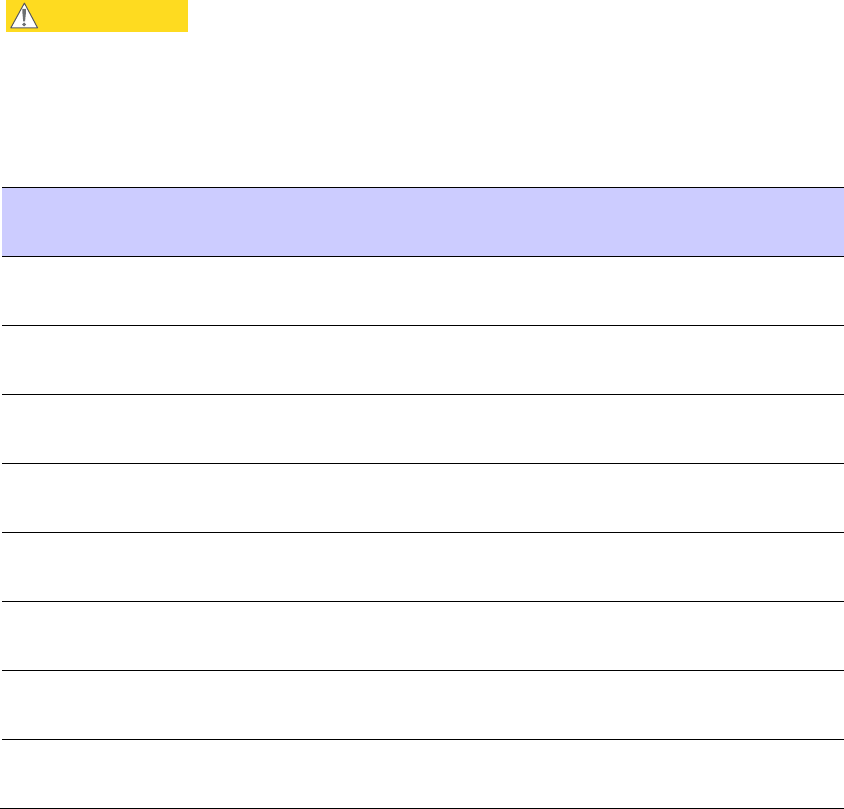
PTP 250 User Guide Ant enna specificat ions
phn- 2182_002v000
May 2011 4-15
5 .8 GHz FCC ant enna restrictions
In FCC regions in the 5.8 GHz band, external antennas from the lists in Table 4-13 can
be used with the Connectorized version of the PTP 250. These are approved by the
FCC for use with the product and are constrained by the following limit for Single/Dual
Polarization Parabolic Dish Antennas: up to 37.6 dBi per polarization or antenna.
In FCC regions when using external antennas, cable loss between the connectorized
ODU and the antenna ports must not be less than 1.2 dB.
CAUTION
Antennas not included in this table, or those having a gain greater than the
specified maximum, are strictly prohibited for use with the PTP 250 in the
5.8 GHz band. The required antenna impedance is 50 ohms.
Table 4 - 1 3 Allowed antennas for deploym ent in USA/ Canada – 5.8 GHz
Ma nufa ct ur er Ant e nna Type Ga in
( dBi)
Par abolic
Dish
Andrew Andrew 2-foot Parabolic, P2F-52 (29.4
dBi)
29.4 Y
Andrew Andrew 2-foot Dual-Pol Parabolic,
PX2F-52 (29.4 dBi)
29.4 Y
Andrew Andrew 3-foot Parabolic, P3F-52 (33.4
dBi)
33.4 Y
Andrew Andrew 3-foot Dual-Pol Parabolic,
PX3F-52 (33.4 dBi)
33.4 Y
Andrew Andrew 4-foot Parabolic, P4F-52 (34.9
dBi)
34.9 Y
Andrew Andrew 4-foot Dual-Pol Parabolic,
PX4F-52 (34.9 dBi)
34.9 Y
Andrew Andrew 6-foot Parabolic, P6F-52 (37.6
dBi)
37.6 Y
Andrew Andrew 6-foot Dual-Pol Parabolic,
PX6F-52 (37.6 dBi)
37.6 Y

Ant enna specificat ions Chapt er 4 Reference inform ation
phn- 2 182_002v 000
4-16 May 2011
Ma nufa ct ur er Ant e nna Type Ga in
( dBi)
Par abolic
Dish
Gabriel Gabriel 2-foot High Performance
QuickFire Parabolic, HQF2-52-N
28.2 Y
Gabriel Gabriel 4-foot High Performance
QuickFire Parabolic, HQF4-52-N
34.4 Y
Gabriel Gabriel 6-foot High Performance
QuickFire Parabolic, HQF6-52-N
37.4 Y
Gabriel Gabriel 2-foot High Performance Dual
QuickFire Parabolic, HQFD2-52-N
28.1 Y
Gabriel Gabriel 4-foot High Performance Dual
QuickFire Parabolic, HQFD4-52-N
34.3 Y
Gabriel Gabriel 6-foot High Performance Dual
QuickFire Parabolic, HQFD6-52-N
37.3 Y
Gabriel Gabriel 2-foot Standard QuickFire
Parabolic,
QF2-52-N
28.5 Y
Gabriel Gabriel 2-foot Standard QuickFire
Parabolic,
QF2-52-N-RK
28.5 Y
Gabriel Gabriel 2.5-foot Standard QuickFire
Parabolic, QF2.5-52-N
31.2 Y
Gabriel Gabriel 4-foot Standard QuickFire
Parabolic,
QF4-52-N
34.8 Y
Gabriel Gabriel 4-foot Standard QuickFire
Parabolic,
QF4-52-N-RK
34.8 Y
Gabriel Gabriel 2-foot Standard Dual
QuickFire Parabolic, QFD2-52-N
28.4 Y
Gabriel Gabriel 2.5-foot Standard Dual
QuickFire Parabolic, QFD2.5-52-N
31.1 Y
Gabriel Gabriel 2-foot Standard Dual
QuickFire Parabolic, QFD2-52-N-RK
28.4 Y

PTP 250 User Guide Ant enna specificat ions
phn- 2182_002v000
May 2011 4-17
Ma nufa ct ur er Ant e nna Type Ga in
( dBi)
Par abolic
Dish
Gabriel Gabriel 4-foot Standard Dual
QuickFire Parabolic, QFD4-52-N
34.7 Y
Gabriel Gabriel 4-foot Standard Dual
QuickFire Parabolic, QFD4-52-N-RK
34.7 Y
RadioWaves Radio Waves 2-foot Dual-Pol
Parabolic, SPD2-5.2 (28.1 dBi)
28.1 Y
RadioWaves Radio Waves 2-foot Parabolic, SP2-5.2
(29.0 dBi)
29 Y
RadioWaves Radio Waves 3-foot Dual-Pol
Parabolic, SPD3-5.2 (31.1 dBi)
31.1 Y
RadioWaves Radio Waves 3-foot Parabolic, SP3-5.2
(31.4 dBi)
31.4 Y
RadioWaves Radio Waves 4-foot Dual-Pol
Parabolic, SPD4-5.2 (34.4 dBi)
34.4 Y
RadioWaves Radio Waves 4-foot Parabolic, SP4-5.2
(34.8 dBi)
34.8 Y
RadioWaves Radio Waves 6-foot Dual-Pol
Parabolic, SPD6-5.2 (37.5 dBi)
37.5 Y
RadioWaves Radio Waves 2-foot Parabolic, SP2-2/5
(28.3 dBi)
28.3 Y
RadioWaves Radio Waves 3-foot Parabolic, SP3-2/5
(31.4 dBi)
31.4 Y
RadioWaves Radio Waves 4-foot Parabolic, SP4-2/5
(34.6 dBi)
34.6 Y
RFS RFS 2-foot Parabolic, SPF2-52AN or
SPFX2-52AN (27.9 dBi)
27.9 Y
RFS RFS 3-foot Parabolic, SPF3-52AN or
SPFX3-52AN(31.4 dBi)
31.4 Y
RFS RFS 4-foot Parabolic, SPF4-52AN or
SPFX4-52AN(33.9 dBi)
33.9 Y
RFS RFS 6-foot Parabolic, SPF6-52AN or
SPFX6-52AN (37.4 dBi)
37.4 Y

Ant enna specificat ions Chapt er 4 Reference inform ation
phn- 2 182_002v 000
4-18 May 2011
Ma nufa ct ur er Ant e nna Type Ga in
( dBi)
Par abolic
Dish
RFS RFS 2-foot HP Parabolic, SDF2-52AN
or SDFX2-52AN (31.4 dBi)
31.4 Y
RFS RFS 4-foot HP Parabolic, SDF4-52AN
or SDFX4-52AN (33.9 dBi)
33.9 Y
RFS RFS 6-foot HP Parabolic, SDF6-52AN
or SDFX6-52AN (37.4 dBi)
37.4 Y
StellaDoradus StellaDoradus 45 inch Parabolic
Antenna, 58PSD113
33.8 Y

PTP 250 User Guide Wireless specifications
phn- 2182_002v000
May 2011 4-19
W ireless specificat ions
This section contains specifications of the PTP 250 wireless interface. These
specifications include RF bands, channel width and link loss.
Ge nera l w ireless spe cificat ions
Table 4-14 contains radio system specifications for the 5.4 GHz band. Table 4-15
contains radio system specifications for the 5.8 GHz band.
Table 4 - 1 4 5.4 GHz RF specifications
Radio t echnology Spe cificat ion
RF band 5.470-5.725 GHz
Channel selection By dynamic frequency control and manual intervention
Automatic detection on start-up and continual adaptation.
Dynamic frequency control Initially 10-15 sec. Out of service on interference 100 ms.
Channel width 20 MHz and 40 MHz
Manual power control Maximum power can be controlled lower than the power
limits in order to control interference to other users.
Receiver noise figure Typically 6 dB
Integrated antenna type Integrated flat plate antenna; gain 23dBi
External antenna gain See Calculating EIRP for connectorized units on page 4-30.
Antenna beamwidth 8 Degrees
Max path loss 150 dB (20 MHz channel, integrated antenna)
Range (optical line-of-sight) 27 km (17 miles) at channel width 20 MHz
54 km (34 miles) at channel width 40 MHz
Over-the-air encryption Proprietary scrambling mechanism.
Weather sensitivity Sensitivity at higher modes may be reduced during high winds
through trees due to Adaptive Modulation Threshold changes
Error correction FEC

Wireless specifications Chapt er 4 Reference inform ation
phn- 2 182_002v 000
4-20 May 2011
Table 4 - 1 5 5.8 GHz RF specifications
Radio t echnology Specifica t ion
RF band 5.725-5.850 GHz
Channel selection By dynamic frequency control and manual intervention
Automatic detection on start-up and continual adaptation.
Dynamic frequency control Initial capture 10-15 sec. Out of service on interference
100 ms.
Channel width 20 MHz and 40 MHz
Manual power control Maximum power can be controlled lower than the power
limits in order to control interference to other users.
Receiver noise figure Typically 6 dB
Antenna type (integrated) Flat plate antenna; gain 23 dBi
Antenna type (external) See Antenna specifications on page 4-14.
Antenna beamwidth
(integrated)
8 degrees
Max path loss 150 dB (20 MHz channel, integrated antenna)
Range (optical line-of-sight) 27 km (17 miles) at channel width 20 MHz
54 km (34 miles) at channel width 40 MHz
Over-the-air encryption Proprietary scrambling mechanism.
Weather sensitivity Sensitivity at higher modes may be reduced during high
winds through trees due to Adaptive Modulation Threshold
changes
Error correction FEC

PTP 250 User Guide Dat a network specifications
phn- 2182_002v000
May 2011 4-21
Da t a net w ork specificat ions
This section contains specifications of the PTP 250 Ethernet interface.
Et herne t int e r face s
The PTP 250 Ethernet ports conform to the specifications listed in Table 4-16.
Table 4 - 1 6 Ethernet bridging specificat ions
Et he rnet bridging Spe cifica t ion
Protocol IEEE802.1 compatible
Interface 1000BaseT (RJ-45), supports MDI/MDIX
auto-crossover
Maximum Ethernet data rate 220 Mbps
Maximum Ethernet frame size 2000 bytes
NOTE
Practical Ethernet rates will depend on network configuration, higher layer
protocols and platforms used.
Over the air throughput will be capped to the rate of the Ethernet interface
at the receiving end of the link.

Com pliance with safety st andards Chapt er 4 Reference infor m at ion
phn- 2 182_002v 000
4-22 May 2011
Com plia nce w it h safet y st andards
This section lists the safety specifications against which the PTP 250 has been tested
and certified. It also describes how to keep RF exposure within safe limits.
Ele ct r ical safet y com plia nce
The PTP 250 hardware has been tested for compliance to the electrical safety
specifications listed in Table 4-17.
Table 4 - 1 7 Safet y com pliance specifications
Region Spe cificat ion
USA UL60950-1, Second Edition
Canada CSA C22.2 No 60950-1, Second Edition
International CB Certified to IEC60950-1:2005 (Second Edition) and
EN60950-1:2006
Ele ct r om a gnet ic com pat ibilit y ( EMC) com plia nce
The PTP 250 complies with European EMC Specification EN301 489-1 with testing
carried out to the detailed requirements of EN301 489-4.
NOTE
For EN 61000-4-2: 1995 Electro Static Discharge (ESD), Class 2, 8 kV air,
4 kV contact discharge, the PTP 250 have been tested to ensure immunity to
15 kV air and 8 kV contact.
Table 4-18 lists the EMC specification type approvals that have been granted for the
PTP 250.
Table 4 - 1 8 EMC em issions com pliance
Region Spe cifica t ion ( Type Approvals)
USA FCC Part 15 Class B
Canada RSS Gen and RSS 210
Europe EN55022 CISPR 22 and EN301 489-1/4

PTP 250 User Guide Com pliance with safety st andards
phn- 2182_002v000
May 2011 4-23
Hum a n ex posure t o r a dio fr e quency ene r gy
Standards
Relevant standards (USA and EC) applicable when working with RF equipment are:
•
ANSI IEEE C95.1-1991, IEEE Standard for Safety Levels with Respect to Human
Exposure to Radio Frequency Electromagnetic Fields, 3 kHz to 300 GHz.
• Council recommendation of 12 July 1999 on the limitation of exposure of the
general public to electromagnetic fields (0 Hz to 300 GHz) (1999/519/EC) and
respective national regulations.
•
Directive 2004/40/EC of the European Parliament and of the Council of 29 April
2004
on the minimum health and safety requirements regarding the exposure of
workers to the risks arising from physical agents (electromagnetic fields) (18th
individual Directive within the meaning of Article 16(1) of Directive 89/391/EEC).
• US FCC limits for the general population. See the FCC web site at
http://www.fcc.gov, and the policies, guidelines, and requirements in Part 1 of
Title 47 of the Code of Federal Regulations, as well as the guidelines and
suggestions for evaluating compliance in FCC OET Bulletin 65.
• Health Canada limits for the general population. See the Health Canada web site
at http://www.hc-sc.gc.ca/ewh-semt/pubs/radiation/99ehd-dhm237/limits-
limites_e.html and Safety Code 6.
• EN 50383:2002 Basic standard for the calculation and measurement of
electromagnetic field strength and SAR related to human exposure from radio
base stations and fixed terminal stations for wireless telecommunication systems
(110 MHz - 40 GHz).
• BS EN 50385:2002 Product standard to demonstrate the compliances of radio
base stations and fixed terminal stations for wireless telecommunication systems
with the basic restrictions or the reference levels related to human exposure to
radio frequency electromagnetic fields (110 MHz – 40 GHz) – general public.
• ICNIRP (International Commission on Non-Ionizing Radiation Protection)
guidelines for the general public. See the ICNIRP web site at
http://www.icnirp.de/ and Guidelines for Limiting Exposure to Time-Varying
Electric, Magnetic, and Electromagnetic Fields.

Com pliance with safety st andards Chapt er 4 Reference infor m at ion
phn- 2 182_002v 000
4-24 May 2011
Pow er de nsit y ex posur e lim it
Install the radios for the PTP 250 families of PTP wireless solutions so as to provide
and maintain the minimum separation distances from all persons.
The applicable power density exposure limit from the standards (see Human exposure
to radio frequency energy on page 4-23 ) is 10 W/m2 for RF energy in the 5.4 GHz and
5.8 GHz frequency bands.
Calculat ion of pow e r de nsit y
NOTE
The following calculation is based on the ANSI IEEE C95.1-1991 method, as
that provides a worst case analysis. Details of the assessment to
EN50383:2002 can be provided, if required.
Peak power density in the far field of a radio frequency point source is calculated as
follows:
W he re : I s:
S
power density in W/m2
P
maximum average transmit power
capability of the radio, in W
G
total Tx gain as a factor, converted
from dB
d
distance from point source, in m.
Rearranging terms to solve for distance yields:
2
4
.
d
GP
S
π
=
S
GP
d.4
.
π
=

PTP 250 User Guide Com pliance with safety st andards
phn- 2182_002v000
May 2011 4-25
Calculat ed dist a nces and pow e r com pliance m argins
Table 4-19 shows calculated minimum separation distances, recommended distances
and resulting margins for each frequency band and antenna combination. These are
conservative distances that include compliance margins. At these and greater
separation distances, the power density from the RF field is below generally accepted
limits for the general population.
Explanation of terms used in Table 4-19:
Tx burst – maximum average transmit power in burst (Watt)
P – maximum average transmit power capability of the radio (Watt)
G – total transmit gain as a factor, converted from dB
S – power density (W/m2)
d – minimum distance from point source (meters)
R – recommended distances (meters)
Table 4 - 1 9 Power com pliance m argins
Ba nd Ant e nna Tx Bur st
( W )
P ( W ) G S
( W / m 2)
d ( m ) R
( m )
5.4 GHz
Integrated 0.0050 0.0050 200 10 0.089 1
Max gain
connectorized
0.0025 0.0025 398 10 0.089 1
ETSI 5.8
GHz
Integrated 0.0200 0.0200 200 10 0.178 1
Max gain
connectorized
0.0025 0.0025 1585 10 0.178 1
FCC 5.8
GHz
Integrated 0.1585 0.1585 200 10 0.502 2
Max gain
connectorized
0.1585 0.1585 5012 10 2.514 5
Gain of antenna in dBi = 10*log(G).
The regulations require that the power used for the calculations is the maximum
power in the transmit burst subject to allowance for source-based time-averaging.
At 5.4 GHz and EU 5.8 GHz, the products are generally limited to a fixed EIRP which
can be achieved with the Integrated Antenna. The calculations above assume that the
maximum EIRP allowed by the regulations is being transmitted.
Com pliance with safety st andards Chapt er 4 Reference infor m at ion
phn- 2 182_002v 000
4-26 May 2011
If there are no EIRP limits in the country of deployment, use the distance calculations
for FCC 5.8 GHz for all frequency bands.
At FCC 5.8 GHz, for antennas between 0.6m (2ft) and 1.8m (6ft), alter the distance
proportionally to the antenna gain.

PTP 250 User Guide Com pliance with radio r egulat ions
phn- 2182_002v000
May 2011 4-27
Com pliance w it h ra dio r egulat ions
This section describes how the PTP 250 complies with the radio regulations that are in
force in various countries.
CAUTION
Changes or modifications not expressly approved by Motorola could void the
user’s authority to operate the system.
Regulat ory constraint s on ra dio operat ion
The Radio Regulations of various countries’ constrain the operation of radio products
generally. In particular the local regulator may limit the amount of conducted or
radiated transmitter power and may require registration of the radio link.
Contact your supplier/installer to ensure that your product is configured to fulfill all
the local regulatory requirements, especially if you are intending to use a link with
external antennas.
Type approvals
This system has achieved Type Approval in various countries around the world. This
means that the system has been tested against various local technical regulations and
found to comply. The frequency bands in which the system operates may be
‘unlicensed’ and, in these bands, the system can be used provided it does not cause
interference. Further, it is not guaranteed protection against interference from other
products and installations.
CAUTION
When planning a link that will use Connectorized PTP 250 (with external
antennas), ensure that regulatory requirements are met for the installation, as
described in Calculating EIRP for connectorized units on page 4-30.

Com pliance with radio r egulat ions Chapt er 4 Reference infor m at ion
phn- 2 182_002v 000
4-28 May 2011
Table 4-20 lists the radio specification type approvals that have been granted for
PTP 250.
Table 4 - 2 0 Radio cert ifications
Ba nd Region Spe cifica t ion ( Type Approvals)
5.4 GHz Europe EN301 893 V1.5.1
5.8 GHz USA FCC Part 15.247
CANADA RSS 210 Issue 7, Annex 8
UK IR 2007
Eire ComReg 06/47R
Germany Order No 47/2007
EU EN302 502 v 1.2.1
Spain CNAF-2010-BOE
Norway REG 2009-06-02 no. 580
Denmark Danish radio interface 00 007
FCC a nd ETSI com pliance t est ing
The system has been tested for compliance to both US (FCC) and European (ETSI)
specifications. It has been shown to comply with the limits for emitted spurious
radiation for a Class B digital device, pursuant to Part 15 of the FCC Rules in the USA
and appropriate European ENs. These limits have been designed to provide reasonable
protection against harmful interference. However the equipment can radiate radio
frequency energy and, if not installed and used in accordance with the instructions,
may cause harmful interference to other radio communications. There is no guarantee
that interference will not occur in a particular installation.
NOTE
A Class B Digital Device is a device that is marketed for use in a residential
environment, notwithstanding use in commercial, business and industrial
environments.

PTP 250 User Guide Com pliance with radio r egulat ions
phn- 2182_002v000
May 2011 4-29
NOTE
Notwithstanding that Motorola has designed (and qualified) the PTP 250
products to generally meet the Class B requirement to minimize the
potential for interference, the PTP 250 product ranges are not marketed for
use in a residential environment.
Ra dio a nd t elevision int erference
If this equipment does cause harmful interference to radio or television reception,
which can be determined by turning the equipment off and on, the user is encouraged
to try to correct the interference by one or more of the following measures:
• Reorient or relocate the Outdoor Unit (ODU).
• Increase the separation between the affected equipment and ODU.
• Connect the ODU and PoE power supply into a power outlet on a circuit different
from that to which the receiver is connected.
• Consult your installer or supplier for help.
Max im um pe r m it t ed EI RP
In most countries, operation of products in the band 5470 MHz to 5725 MHz is
constrained by an EIRP limit. The constraint is that the EIRP must not exceed 30 dBm
or (17 + 10 x Log Channel width) dBm.
In some countries, operation of products in the band 5725 MHz to 5875 MHz is
constrained by an EIRP limit. The constraint is that the EIRP must not exceed 36 dBm
or (23 + 10 x Log Channel width) dBm.
For examples of countries that impose an EIRP limit, refer to Table 4-23.

Com pliance with radio r egulat ions Chapt er 4 Reference infor m at ion
phn- 2 182_002v 000
4-30 May 2011
Calcula t ing EI RP for connector ized unit s
When operating with external antennas in countries that impose an EIRP limit, the
administrator has to set the maximum transmit power to ensure that EIRP does not
exceed the limit allowed by regulations.
To calculate the maximum EIRP that the unit can output, use this formula:
Maximum EIRP (dBm) =
Maximum Power Level (dBm) + Antenna Gain (dBi) – Cable Loss (dB)
To calculate the highest permissible setting of Maximum Power Level, use this
formula:
Maximum Power Level (dBm) =
Allowed EIRP (dBm) – Antenna Gain (dBi) + Cable Loss (dB)
W he re : I s:
Maximum Power
Level (dBm)
the highest permissible setting of the
Maximum Power Level attribute in the
Step 2: Wireless Configuration page
Allowed EIRP
(dBm)
the EIRP limit allowed by the regulations
Antenna Gain
(dBi)
Antenna Gain as set in the Step 2:
Wireless Configuration page
Cable Loss (dB)
Cable Loss as set in the Step 2: Wireless
Configuration page
NOTE
Choose an antenna and RF cable that will not cause the PTP 250 to exceed
Allowed EIRP. As PTP 250 does not support Maximum Power Level settings
below 4 dBm, the maximum antenna gain (allowing for cable loss) is limited
as follows (examples in Table 4-21):
Maximum Antenna Gain (dBi) – Cable Loss (dB) = Allowed EIRP (dBm) – 4
Table 4 - 2 1 Maxim um perm itt ed antenna gain ( allowing for cable loss)
Allow ed EI RP M ax im um ( Ant enna Ga in - Cable Loss)
30 dBm 26 dBi
36 dBm 32 dBi

PTP 250 User Guide Com pliance with radio r egulat ions
phn- 2182_002v000
May 2011 4-31
Calculat ing RF ca ble loss ( FCC only)
The FCC approval for the product is based on tests with a cable loss between the ODU
and antenna of not less than 1.2 dB at 5.8 GHz. If cable loss was below 1.2 dB, the
connectorized PTP 250 would exceed the maximum EIRP allowed under FCC 5.8 GHz
rules.
Cable loss depends mainly upon cable type and length. To meet or exceed the
minimum loss of 1.2 dB, use cables of the type and length specified in Table 4-22
(source: Times Microwave). This data excludes connector losses.
Table 4 - 2 2 RF cable lengt hs required to achieve 1.2 dB loss at 5.8 GHz
RF cable t ype M inim um ca ble lengt h
LMR100 0.6 m (1.9 ft)
LMR200 1.4 m (4.6 ft)
LMR300 2.2 m (7.3 ft)
LMR400 3.4 m (11.1 ft)
LMR600 5.0 m (16.5 ft)

Com pliance with radio r egulat ions Chapt er 4 Reference infor m at ion
phn- 2 182_002v 000
4-32 May 2011
Ex am ple s of regulat ory lim it s
Each country imposes specific limits on the frequencies, channel widths and maximum
transmit power that may be used by wireless equipment. When a new PTP 250 unit is
first accessed via the web interface, the user is required to select the Country Code
from a list. The PTP 250 firmware does not allow the unit to be configured to operate
outside the regulatory limits that apply to the selected country.
CAUTION
It is the responsibility of the user to ensure that the PTP product is operated
in accordance with local regulatory limits.
Table 4-23 contains examples of the regulatory limits that apply in typical countries of
operation.
Table 4 - 2 3 Exam ple of regulat ory lim it s
Count r y Band Per m it t ed
fr eque ncies
Radar
avoida nce
( DFS) r equire d?
Ma x im um
t ra nsm it
pow e r
UK 5.4 GHz 5470 - 5600 MHz
5650 - 5725 MHz
Yes 30 dBm
EIRP
USA 5.8 GHz 5725 - 5825 MHz No 30 dBm
Denmark 5.8 GHz 5725 - 5795 MHz
5815 - 5875 MHz
Yes 36 dBm
EIRP
The PTP 250 may be constrained to operate within narrower frequency limits than
those specified in the regulations for certain countries.

PTP 250 User Guide Notificat ions
phn- 2182_002v000
May 2011 4-33
N ot ificat ions
The PTP 250 5.4 GHz variant complies with the radio regulations that are in force in
Europe. The PTP 250 5.8 GHz variant complies with the radio regulations that are in
force in the USA, Canada and Europe. The relevant notifications are specified in this
section.
5 .4 GHz Europe a n Union not ificat ion
The products are two-way radio transceivers suitable for use in Broadband Wireless
Access System (WAS), Radio Local Area Network (RLAN), or Fixed Wireless Access
(FWA) systems operating in the 5.4 GHz band. They are Class 1 devices and use
operating frequencies that are harmonized throughout the EU member states. The
operator is responsible for obtaining any national licenses required to operate these
products and these must be obtained before using the products in any particular
country.
Hereby, Motorola Solutions, Inc. declares that the 5.4 GHz products comply with the essential
requirements and other relevant provisions of Directive 1999/5/EC. The declaration of
conformity may be consulted at http://www.motorola.com/ptp/support.
The European R&TTE directive 1999/5/EC Certification Number is reproduced on the
product label (Figure 4-1).
Figure 4 - 1 European Union cert ification on 5.4 GHz product label
5 .8 GHz FCC and I C not ificat ion
U.S. Federal Communication Commission (FCC) and Industry Canada (IC) Notification.
This system has achieved Type Approval in various countries around the world. This
means that the system has been tested against various local technical regulations and
found to comply. The frequency band in which the system operates is ‘license exempt’
and the system is allowed to be used provided it does not cause interference. Further,
the licensing authority does not guaranteed protection against interference from other
products and installations.

Notificat ions Chapt er 4 Reference infor m at ion
phn- 2 182_002v 000
4-34 May 2011
This device complies with part 15 of the US FCC Rules and Regulations and with
RSS-210 of Industry Canada. Operation is subject to the following two conditions: (1)
This device may not cause harmful interference, and (2) This device must accept any
interference received, including interference that may cause undesired operation. In
Canada, users should be cautioned to take note that high power radars are allocated
as primary users (meaning they have priority) of the 5650 – 5850 MHz spectrum and
these radars could cause interference and/or damage to license-exempt local area
networks (LELAN).
For the connectorized version of the product and in order to reduce potential radio
interference to other users, the antenna type and its gain should be so chosen that the
Effective Isotropically Radiated Power (EIRP) is not more than that permitted for
successful communication.
This equipment has been tested and found to comply with the limits for a Class B
digital device, pursuant to Part 15 of the US FCC Rules and with RSS-210 of Industry
Canada. These limits are designed to provide reasonable protection against harmful
interference in a residential installation. This equipment generates, uses, and can
radiate radio-frequency energy and, if not installed and used in accordance with these
instructions, may cause harmful interference to radio communications. If this
equipment does cause harmful interference to radio or television reception, which can
be determined by turning the equipment on and off, the user is encouraged to correct
the interference by one or more of the following measures:
• Increase the separation between the affected equipment and the unit;
• Connect the affected equipment to a power outlet on a different circuit from that
which the receiver is connected to;
• Consult the dealer and/or experienced radio/TV technician for help.
FCC IDs and Industry Canada Certification Numbers are reproduced on the product
label (Figure 4-2).
Figure 4 - 2 FCC and I C certificat ions on 5.8 GHz product label
This device complies with Part 15 of the FCC Rules.
Operation is subject to the following two conditions:
1 This device may not cause harmful interference, and
2 This device must accept any interference received, including
interference that may cause undesired operation.
FCC ID:QWP58250
IC:109AO-58250

PTP 250 User Guide Notificat ions
phn- 2182_002v000
May 2011 4-35
Where necessary, the end user is responsible for obtaining any National licenses
required to operate this product and these must be obtained before using the product
in any particular country. Contact the appropriate national administrations for details
on the conditions of use for the bands in question and any exceptions that might apply.
5 .8 GHz Europe a n Union not ificat ion
PTP 250 units operating in the 5.8 GHz band are Class 2 devices as they operate on
frequencies that are not harmonized across the EU. Currently, only Denmark,
Germany, Eire (IRL), Norway, Spain and the UK allow the products to operate in the
5.8 GHz band. However, the regulatory situation in Europe is changing and the radio
spectrum may become available in other countries in future. See www.ero.dk for
further information. The operator is responsible for obtaining any national licenses
required to operate these products and these must be obtained before using the
products in any particular country.
NOTE
Norway regulation is FOR2007-04-20 Nr 439 regarding border PFD limit.
CAUTION
This equipment operates as a secondary application, so it has no rights
against harmful interference, even if generated by similar equipment, and
must not cause harmful interference on systems operating as primary
applications.
Hereby, Motorola Solutions, Inc. declares that the PTP 250 products comply with the essential
requirements and other relevant provisions of Directive 1999/5/EC. The declaration of
conformity may be consulted at http://www.motorola.com/ptp/support.
The European R&TTE directive 1999/5/EC Certification Number is reproduced on the
product label (Figure 4-3).
Figure 4 - 3 European Union cert ification on 5.8 GHz product label
The PTP 250 connectorized products have been notified for operation in those EU
countries that allow 5.8 GHz operation.
Notificat ions Chapt er 4 Reference infor m at ion
phn- 2 182_002v 000
4-36 May 2011

Cha pt e r 5
phn- 2182_002v000
May 2011 5-1
Chapt er 5 I nst allat ion
. . . . . . . . . . . . . . . . . . . . . . . . . . . . . . . . . . . . . . . . . . . . . . . . . . . . . . . . . . . .
.
.
.
.
This chapter describes how to install the PTP 250 hardware,
To install the equipment at each PTP 250 link end, perform these tasks:
• Preparing for installation on page 5-2 describes the checks to be performed
before proceeding with the installation.
• Installing the ODU on page 5-5 describes how to install the ODU (integrated or
connectorized) on the supporting structure.
• Installing connectorized antennas on page 5-9 describes how to install separate
antenna(s) (only required for connectorized ODUs).
• Installing the drop cable and LPU on page 5-14 describes how to install the drop
cable from the ODU to the LPU and PoE power supply, and to provide grounding
for the installation.
• Installing the PoE power supply on page 5-27 describes how to install the PoE
power supply and connect it to the ODU and network cables.

Pr eparing for inst allation Chapt er 5 I nst allation
phn- 2 182_002v 000
5-2 May 2011
Prepa r ing for inst a llat ion
This section describes the checks to be performed before proceeding with site
hardware installation.
Use the installation report to determine which installation options are required. Refer
to PTP LINKPlanner on page 2-8.
Unit pre- configur a t ion
It is common practice to pre-configure the units during staging before site installation
by performing the following tasks from Chapter 6 Configuration and alignment:
• Connecting to the unit on page 6-3
• Upgrading firmware version on page 6-10
• Using the installation wizard on page 6-14
If the units are to be pre-configured during staging, the safety precautions below
MUST be observed.
Safe t y pr e caut ions
All national and local safety standards must be followed while developing a site,
installing equipment, or performing maintenance.
WARNING
Ensure that personnel are not exposed to unsafe levels of RF energy.
The units start to radiate as soon as they are powered up. Respect the
safety standards defined in Compliance with safety standards on
page 4-22, in particular the minimum separation distances. Observe
the following guidelines:
o Never work in front of the antenna when the ODU is powered.
o Always power down the PoE power supply when connecting and
disconnecting the drop cable from either the PoE power supply or ODU.

PTP 250 User Guide Preparing for inst allation
phn- 2182_002v000
May 2011 5-3
Prot ection requir e m ent s
CAUTION
The installation must meet the requirements defined in Grounding and
lightning protection on page 2-11.
CAUTION
Apply the practices and procedures detailed in manual
R56 Standards And
Guidelines For Communication Sites
to all new site build activities. This
manual is available for download at www.motorola.com/ptp/software
.
Preparing personnel
IN NO EVENT SHALL MOTOROLA SOLUTIONS, INC. BE LIABLE FOR ANY INJURY
TO ANY PERSONS OR ANY DAMAGE CAUSED DURING THE INSTALLATION OF THE
MOTOROLA PTP 250.
Ensure that only qualified personnel undertake the installation of a PTP 250 link.
Ensure that all safety precautions can be observed.
Preparing invent ory
Perform the following inventory checks:
• Check that an installation report is available and that it is based on the principles
described in Chapter 2 Planning considerations.
• Check that the correct components are available, as described in Installation
inventories on page 4-2.
• Check the contents of all packages against their packing lists.
Pr eparing for inst allation Chapt er 5 I nst allation
phn- 2 182_002v 000
5-4 May 2011
Preparing t ools
Check that following specific tools are available, in addition to general tools:
• 13mm wrench and 22 mm wrench for use with the glands.
• RJ45 crimp tool (it must be the correct tool for the type of RJ45 being used).
• Personal Computer (PC) with 1000BaseT Ethernet.
• Web browser (for example Internet Explorer 7, Internet Explorer 8, Firefox 3 or
Firefox 3.5).
• Ethernet patch cables.

PTP 250 User Guide I nst alling the ODU
phn- 2182_002v000
May 2011 5-5
I nst alling t he ODU
Perform this task to install the ODU (integrated or connectorized) on the supporting
structure.
This task consists of the following procedures:
• Checks and safety precautions on page 5-5
• Selecting a position for the ODU (connectorized) on page 5-7
• Mounting the ODU on page 5-7
If a connectorized ODU is being installed, see also:
• Installing connectorized antennas on page 5-9
Che cks a nd safe t y pr e caut ions
WARNING
To prevent failure of the assembly, do not remove the mounting
bracket, and do not mount the ODU on a pole that is too narrow or
too wide.
WARNING
To minimize the risk of injury, do not attempt to hoist the ODU until
the necessary precautions have been taken.
WARNING
To prevent failure of the assembly, do not over-tighten the bolts.
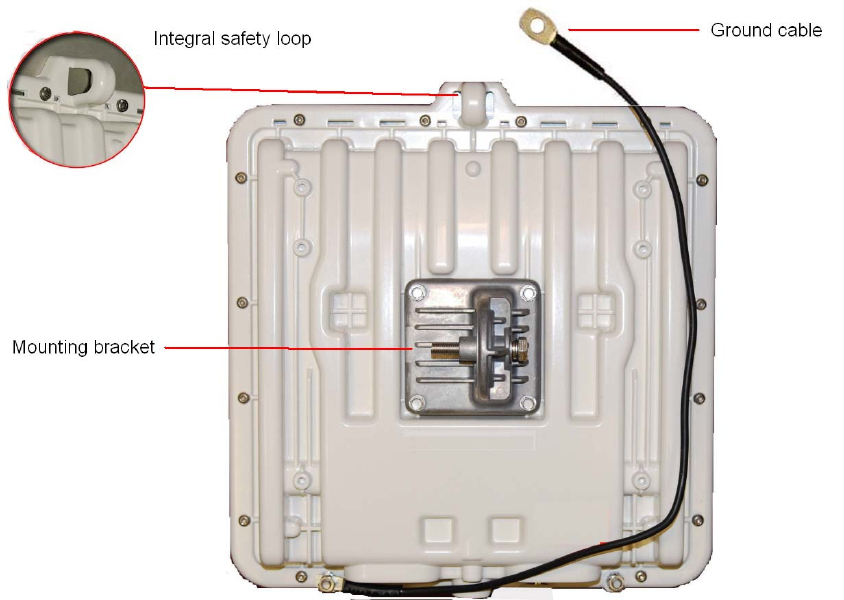
I nst alling the ODU Chapt er 5 I nst allation
phn- 2 182_002v 000
5-6 May 2011
Check that the ODU is pre-fitted with a mounting bracket (designed to ease
installation) and with a ground cable (Figure 5-1).
Figure 5 - 1 Checking the ODU before m ount ing
Do not mount the ODU on poles with diameter less than 50mm (2”) or greater than
75mm (3”). The ODU mounting bracket is designed to work only with poles with
diameter in the 50 mm (2”) to 75 mm (3”) range.
Before hoisting the ODU, take the following precautions:
• Check that the safety loop (Figure 5-1) and its fixing are not damaged in any way
and have not been exposed to a shock loading due to a fall.
• Check that the safety lanyard does not exceed 1m (approx 3 ft) in length.
• Check that the safety lanyard is made from a material that does not degrade in
an outdoor environment.
• Check that the safety lanyard is fixed to a separate point that is not part of the
direct mounting system for the ODU.

PTP 250 User Guide I nst alling the ODU
phn- 2182_002v000
May 2011 5-7
Selecting a posit ion for t he ODU ( connector ized)
If the ODU is connectorized, select a mounting position that gives it maximum
protection from the elements, but still allows easy access for connecting and
weatherproofing the cables. To minimize cable losses, select a position where the
antenna cable lengths can be minimized.
Mount ing t he ODU
To mount the ODU, proceed as follows:
1 Attach the ODU bracket strap to the pole using M8 x 70 mm bolts, M8
flat washers and M8 coil washers.
Tighten to ensure the assembly grips, but can be adjusted on the pole.
2 Use the integral safety loop (Figure 5-1) to hoist the ODU up to the
bracket, observing the precautions described in Checks and safety
precautions on page 5-5.
3 When the ODU is in position, use the safety loop as a fixing point to
secure a permanent safety lanyard from the supporting structure to the
ODU, as a precaution against mounting failure.
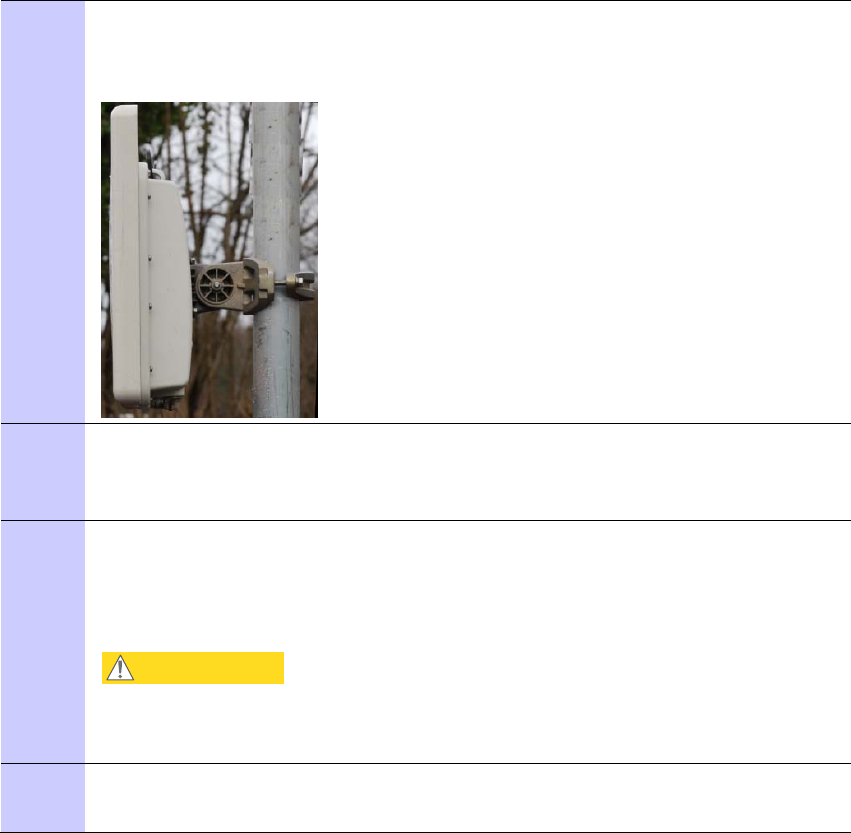
I nst alling the ODU Chapt er 5 I nst allation
phn- 2 182_002v 000
5-8 May 2011
4 Offer the ODU (with pre-fitted mounting bracket) to the bracket strap
and affix using the captive M8 bolt. Tighten to ensure the assembly
grips, but can be adjusted on the pole.
5 Adjust the elevation and azimuth of the unit to achieve an approximate
visual alignment (does not apply to connectorized ODUs). Tighten both
bolts to the required torque settings of 14 Nm (11 lb ft).
6 Connect the ODU ground cable to the to the supporting structure
grounding point, within 0.3 meters (1 ft) of the ODU bracket and on the
same metal (if necessary, remove paint and apply anti-oxidant
compound first).
CAUTION
Do not attach grounding cables to the ODU mounting bracket bolts,
as this arrangement will not provide full protection.
7 To prevent corrosion and possible loss of ground continuity,
weatherproof the grounding point.

PTP 250 User Guide I nst alling connect orized ant ennas
phn- 2182_002v000
May 2011 5-9
I nst alling connectorized ant ennas
If the ODU is connectorized, perform this task to install separate antenna(s).
Preparing for connectorized insta lla t ions
Before proceeding with the installation, perform the following checks:
• Check that the correct components are available, as described in Installation
inventories on page 4-2.
• Check that the selected antenna conforms to the applicable regulatory
restrictions, as described in Antenna specifications on page 4-14 and Compliance
with radio regulations on page 4-27.
• Check that the correct tools are available. The tools required for mounting the
antennas are specific to the antenna chosen. Refer to the antenna manufacturer’s
instructions.
Mount ing a nd connect ing ant enna s
To mount and connect the antenna(s), proceed as follows:
1 Mount the antenna(s) according to manufacturer’s instructions. When using
separate antennas to achieve spatial diversity, mount one with Horizontal
polarization and the other with Vertical polarization.
2 Connect the ODU to the antenna with cables of type LMR100, LMR200,
LMR300, LMR400 or LMR600. Connect the ODU ‘V’ interface to the vertical
polarization antenna and connect the ODU ‘H interface to the horizontal
polarization antenna (Figure 1-5).
NOTE
When using separate antennas to achieve spatial diversity, the antenna
cables will be disconnected from the ODU during the alignment
procedure. Therefore, do not weatherproof the ODU joints until antenna
alignment is complete.
3 Where the ODU is mounted indoors, install lightning arrestors at the
building entry point (Figure 5-2). Assemble the Polyphaser LSXL-ME or
LSXL as shown in Figure 5-3. Connect the lighting arrestors to the master
ground bar of the building.

I nst alling connect orized ant ennas Chapt er 5 I nst allat ion
phn- 2 182_002v 000
5-10 May 2011
4 When dressing the antenna cables, form drip loops near the lower ends
(Figure 5-4). These ensure that water is not constantly channeled towards
the connectors.
5 If the ODU is mounted outdoors, weatherproof the ODU joints using self-
amalgamating tape under a layer of PVC tape (Figure 5-5). Weatherproof
the antenna joints in the same way (unless the antenna manufacturer
specifies a different method).
6 Ground the antenna cables to the supporting structure at the correct points
(Figure 5-6). They should be grounded within 0.3 meters (1 foot) of the ODU
and antennas using the using the cable grounding kit (part number
01010419001).
NOTE
A mast or tower may require additional grounding points, as specified
in Protection requirements for a mast or tower installation on page 2-
14.
7 Dress the antenna cables and fix them using cable ties, cleats or PVC tape.
CAUTION
Ensure that no undue strain is placed on the ODU or antenna
connectors. Ensure that the cables do not flap in the wind, as flapping
cables are prone to damage and induce unwanted vibrations in the
supporting structure.
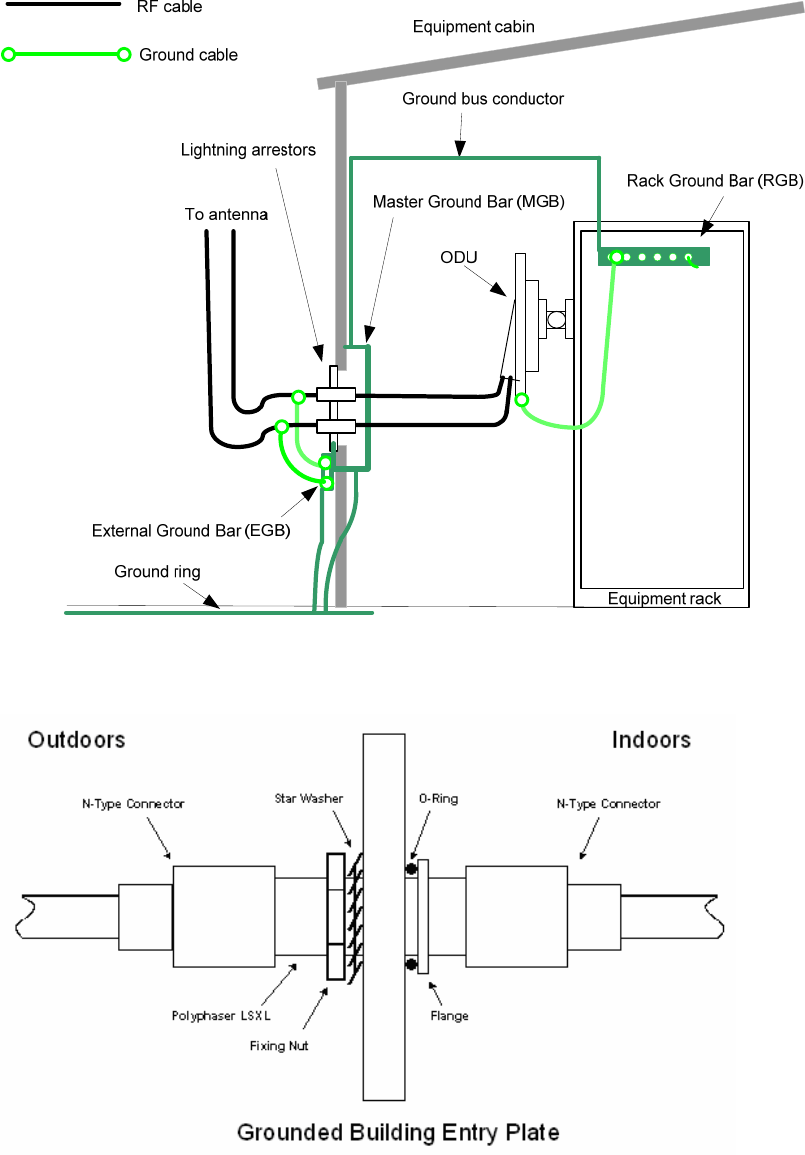
PTP 250 User Guide I nst alling connect orized ant ennas
phn- 2182_002v000
May 2011 5-11
Figure 5 - 2 Light ning arrest or m ount ing
Figure 5 - 3 Polyphaser assem bly
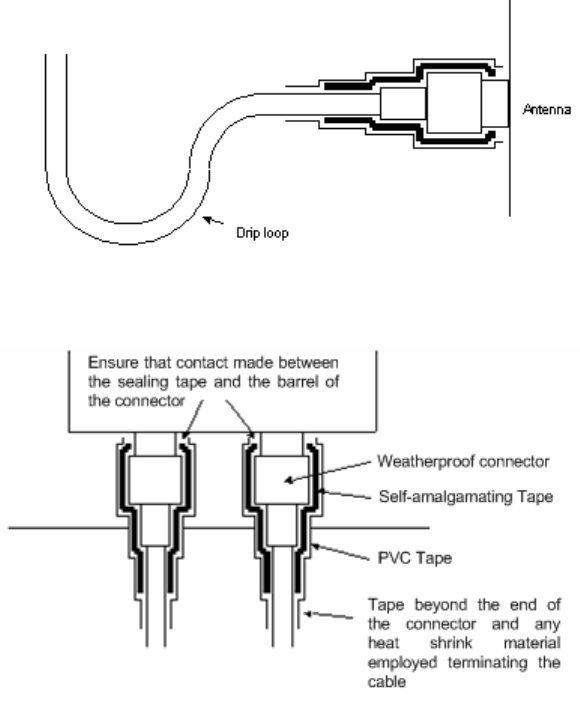
I nst alling connect orized ant ennas Chapt er 5 I nst allat ion
phn- 2 182_002v 000
5-12 May 2011
Figure 5 - 4 Form ing a drip loop
Figure 5 - 5 Weatherproofing t he ant enna connect ions
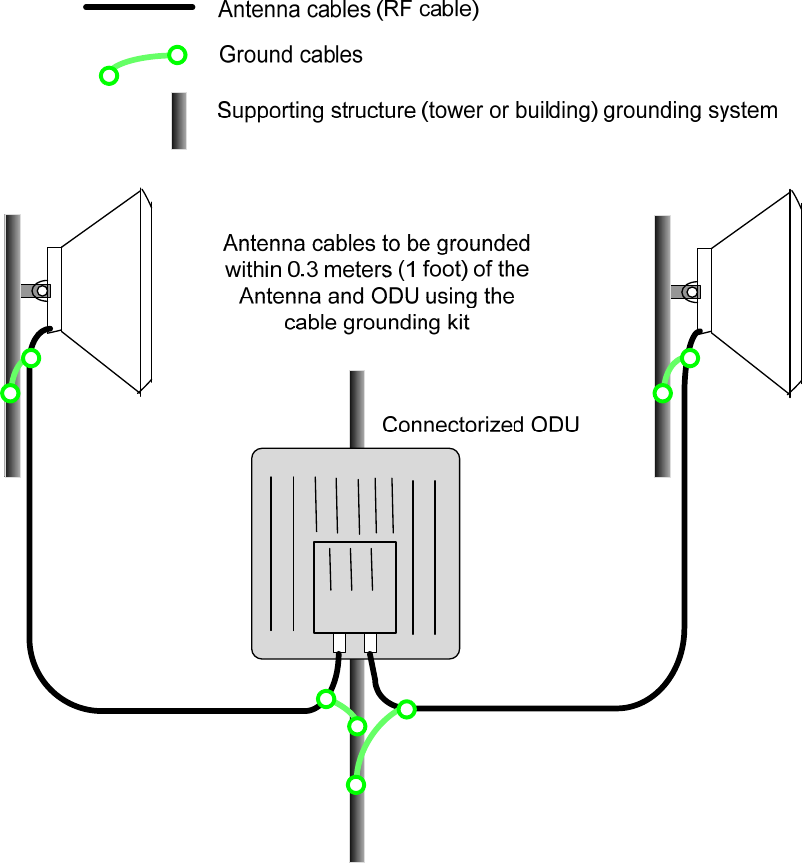
PTP 250 User Guide I nst alling connect orized ant ennas
phn- 2182_002v000
May 2011 5-13
Figure 5 - 6 Grounding point s for ant enna cables

I nst alling t he drop cable and LPU Chapt er 5 I nst allation
phn- 2 182_002v 000
5-14 May 2011
I nst alling t he drop cable and LPU
Perform this task to install the drop cable from the ODU to the PoE power supply, and
to provide grounding and lightning protection for the installation.
This task consists of the following procedures:
• Preparing drop cables on page 5-15.
• Assembling an RJ45 connector and gland on page 5-16.
• Installing and grounding the main drop cable on page 5-18.
• Connecting an RJ45 and gland to a unit on page 5-19.
• Disconnecting an RJ45 and gland from a unit on page 5-21.
• Making a drop cable ground point on page 5-22.
• Installing and grounding the drop cable at building entry on page 5-25.
CAUTION
The drop cable and ground cable installation must meet the requirements
defined in Grounding and lightning protection on page 2-11.
CAUTION
To provide effective protection against lightning induced surges, grounding
cables must be installed without drip loops and pointing down towards the
ground.
CAUTION
To avoid damage to the installation, do not connect or disconnect the drop
cable when power is applied to the PoE power supply.
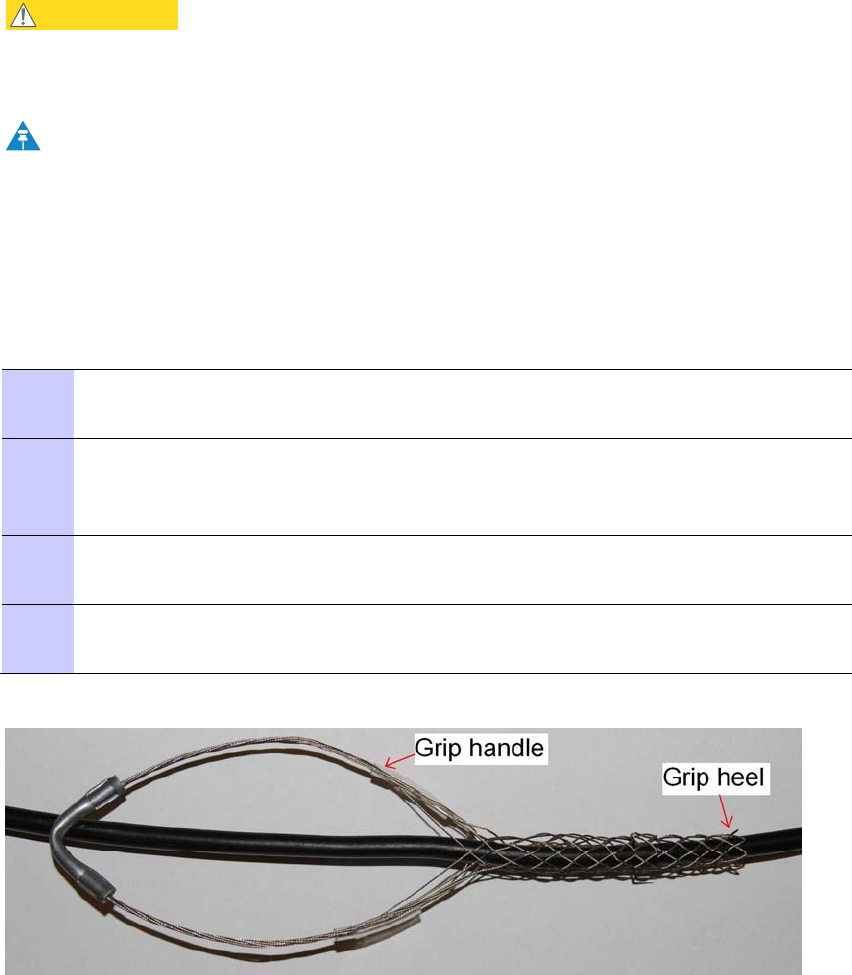
PTP 250 User Guide I nst alling the drop cable and LPU
phn- 2182_002v000
May 2011 5-15
Preparing drop cable s
Perform this task to prepare the CAT5e cables that connect the ODU to the PoE power
supply.
CAUTION
Always use Cat5e cable that is gel-filled and shielded with copper-plated
steel. Alternative types of cable are not supported by Motorola.
NOTE
The maximum permitted lengths of CAT5e cables are specified in Maximum
cable lengths on page 2-5.
For details of supported cables and recommended connectors, refer to
Installation inventories on page 4-2.
‘Main’ drop cable: To prepare a long section of cable to connect the ODU to the LPU,
proceed as follows:
1 Cut off the approximate length required (allowing a bit of surplus), or
leave it on the drum so that it can be unwound as the cable is hoisted.
2 Slide one or more hoisting grips onto to the top end of the main drop
cable (Figure 5-7). To determine the number of hoisting grips required,
consult the grip manufacturer.
3 Secure the hoisting grip to the cable using a special tool, as
recommended by the manufacturer.
4 Fit an RJ45 connector and gland to the top end only, as described in
Assembling an RJ45 connector and gland on page 5-16.
Figure 5 - 7 Typical hoist ing grip on cable

I nst alling t he drop cable and LPU Chapt er 5 I nst allation
phn- 2 182_002v 000
5-16 May 2011
‘LPU-PoE’ cable: To prepare a short section of cable to connect the LPU to the PoE
power supply, proceed as follows:
1 Cut off the approximate length required (allowing a bit of surplus).
2 Fit an RJ45 connector and gland to the top end only, as described in
Assembling an RJ45 connector and gland on page 5-16.
Asse m bling a n RJ4 5 connector a nd gland
Perform this task to prepare the outdoor CAT5e cable with connectors and glands.
Safet y pr eca ut ions
WARNING
The metal screen of the drop cable is very sharp and may cause
personal injury.
When preparing the drop cable, take the following safety precautions:
• ALWAYS wear cut resistant gloves (check the label to ensure they are cut
resistant).
• ALWAYS wear protective eyewear.
• ALWAYS use a rotary blade tool to strip the cable (DO NOT use a bladed knife).
To use the rotary blade tool, fit it around the outer cable sheath and rotate the
cutter around the cable once or twice. The stripped outer section can then be
removed.
Assem bly
Assemble the drop cable as shown in Figure 5-8. The gland is only required for outdoor
connections at the ODU or LPU. The connection to the PoE power supply requires the
RJ45 plug but no gland.
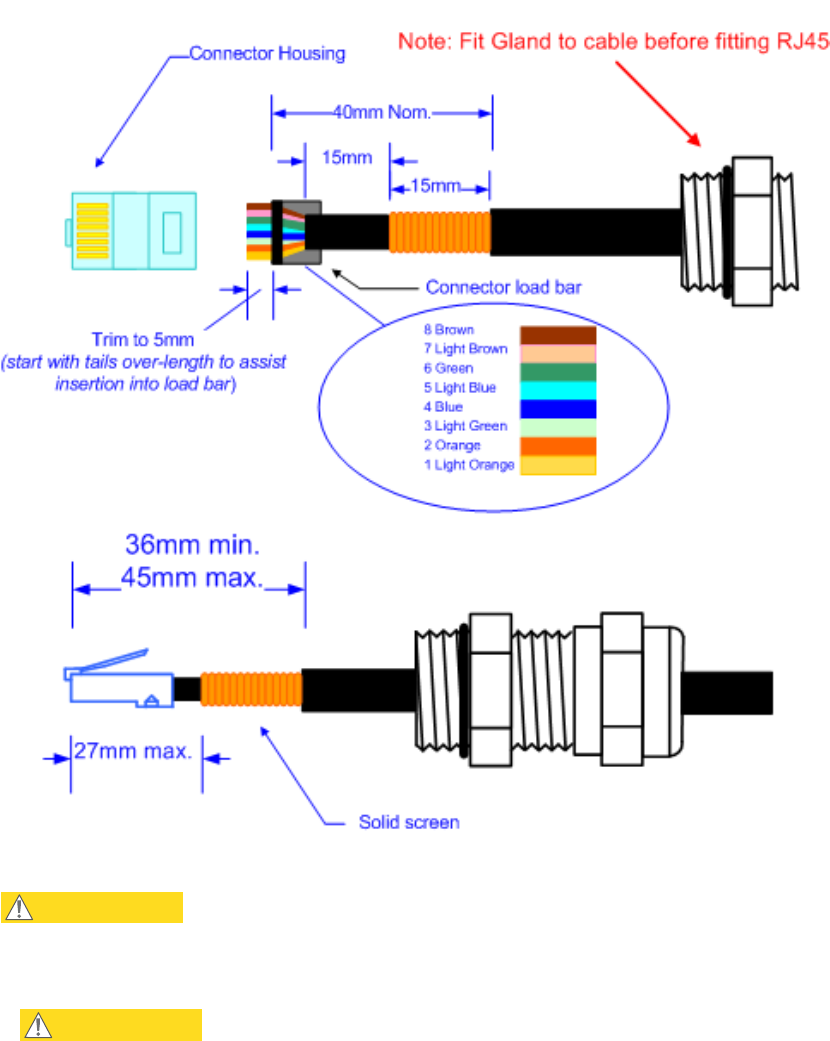
PTP 250 User Guide I nst alling the drop cable and LPU
phn- 2182_002v000
May 2011 5-17
Figure 5 - 8 Correct cable preparat ion for drop cable of the support ed t ype
CAUTION
Check that the crimp tool matches the RJ45 connector being used; otherwise
the cable or connector may be damaged.
CAUTION
The cable inner sheath must be located correctly under the connector
housing tang. If this is not done correctly, there is no strain relief on the
cable terminations.
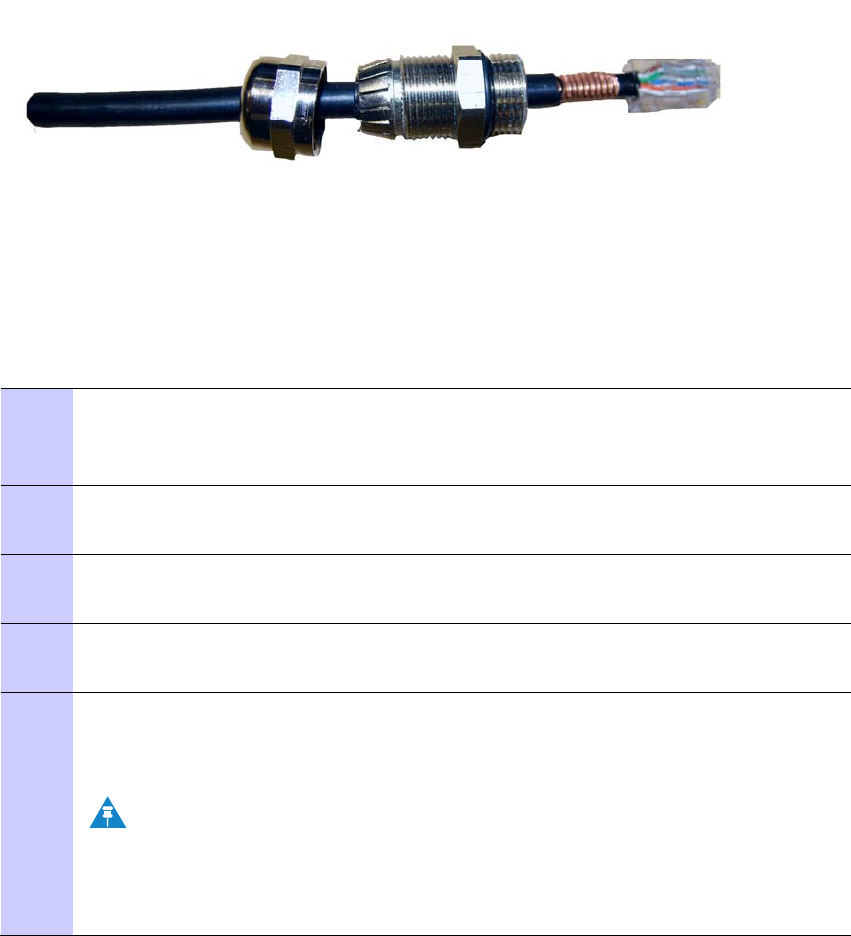
I nst alling t he drop cable and LPU Chapt er 5 I nst allation
phn- 2 182_002v 000
5-18 May 2011
Figure 5-9 shows the end of a drop cable fitted with an RJ45 plug and a gland.
Figure 5 - 9 Drop cable with RJ45 and gland
I nstalling a nd grounding t he m ain dr op cable
Perform this procedure to install the main drop cable, connect it to the ODU, and
ground it to the supporting structure.
To install and ground the main drop cable, proceed as follows:
1 Hoist the main drop cable up to the ODU using the hoisting grip and a
hoist line. When the cable is in position and the grip handle is fastened to
the supporting structure, remove the hoist line.
2 Connect the top end of the long drop cable to the ODU (PoE port), as
described in Connecting an RJ45 and gland to a unit on page 5-19.
3 Lay the main drop cable as far as the building entry point, ensuring there
is enough length to extend through the wall of the building to the LPU.
4 Attach the main drop cable to the supporting structure using cable ties
or cleats.
5 Ground the drop cable to the supporting structure at the points shown in
Figure 2-3 (mast or tower installation) or Figure 2-4 (wall installation), as
described in Making a drop cable ground point on page 5-22.
NOTE
A mast or tower may require additional grounding points, as
specified in Protection requirements for a mast or tower installation
on page 2-14.
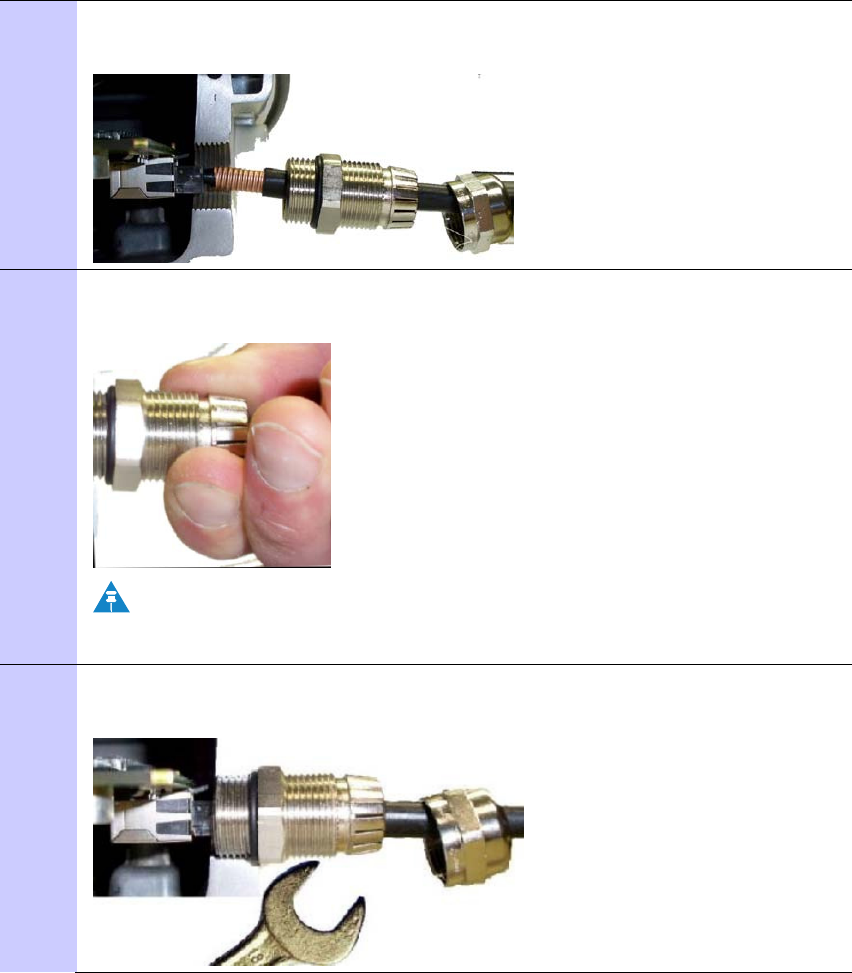
PTP 250 User Guide I nst alling the drop cable and LPU
phn- 2182_002v000
May 2011 5-19
Conne ct ing an RJ4 5 a nd gland t o a unit
Perform this task to connect the drop cable to an ODU or LPU. This procedure
contains illustrations of an ODU, but it applies in principle to both the ODU and the
LPU.
To connect the drop cable with a gland to a unit (LPU or ODU), proceed as follows:
1 Insert the RJ45 plug into the socket in the unit, making sure that the
locking tab snaps home.
2 Support the drop cable and gently hand screw the gland body into the
unit until the O ring seal is flush to the unit body.
NOTE
Do not fit the back shell prior to securing the gland body.
3 Once the gland is fully hand screwed into the unit, tighten it with a
spanner to torque 10 Nm (7.4 ftlbs).
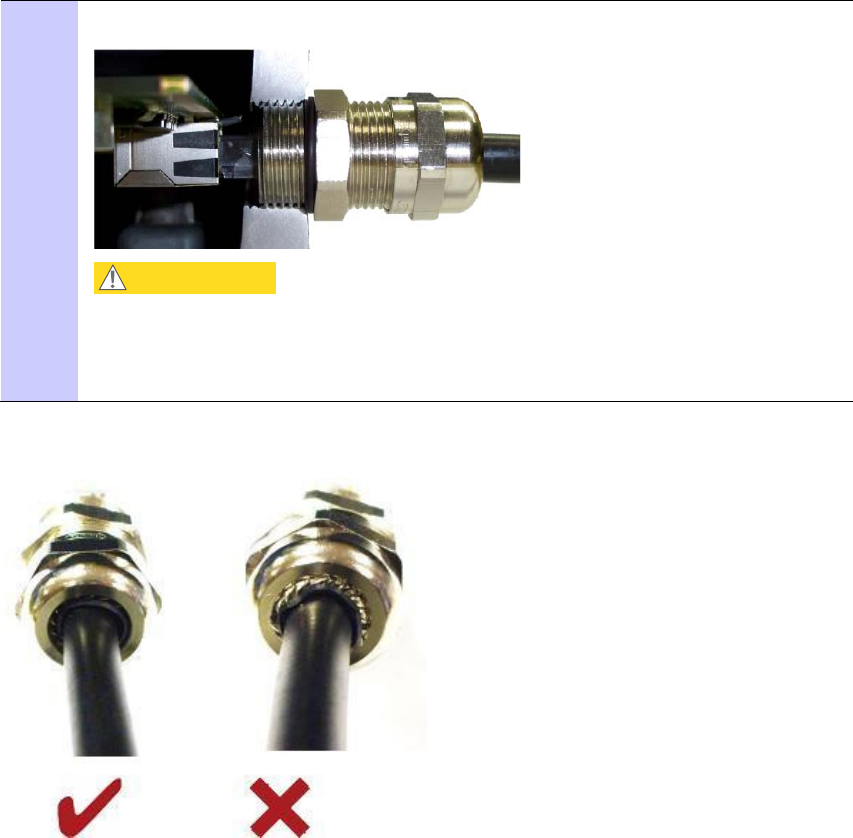
I nst alling t he drop cable and LPU Chapt er 5 I nst allation
phn- 2 182_002v 000
5-20 May 2011
4 When the gland body has been fitted, tighten the gland back shell.
CAUTION
Do not over-tighten the gland back shell, as the internal seal and
structure may be damaged. Figure 5-10 shows correctly tightened
and over-tightened gland back shells.
Figure 5 - 1 0 Correct and incorrect tight ening of cable gland back shell
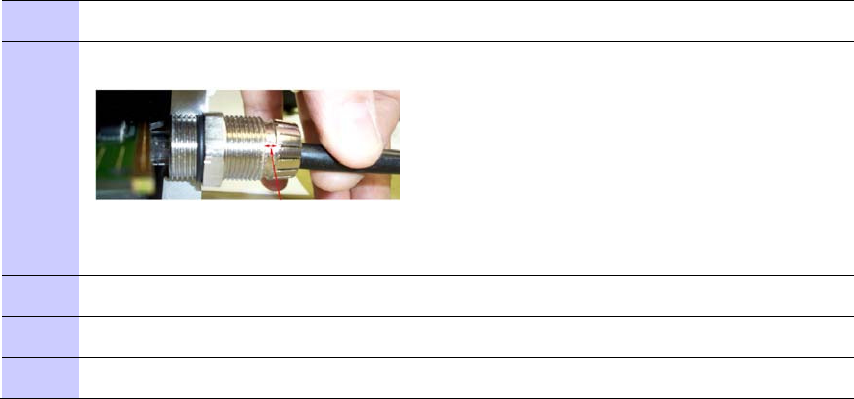
PTP 250 User Guide I nst alling the drop cable and LPU
phn- 2182_002v000
May 2011 5-21
Disconnect ing an RJ4 5 and gla nd from a unit
Perform this task to disconnect the drop cable from an ODU or LPU. This procedure
contains illustrations of an ODU, but it applies in principle to both the ODU and the
LPU.
To disconnect the drop cable with a gland from a unit (LPU or ODU), proceed as
follows:
1 Remove the gland back shell.
2 Wiggle the drop cable to release the tension of the gland body.
When the tension in the glad body is released, a gap opens at the point
shown in red in the above photograph.
3 Unscrew the gland body.
4 Use a small screwdriver to depress the RJ45 locking tab.
5 Unplug the RJ45.
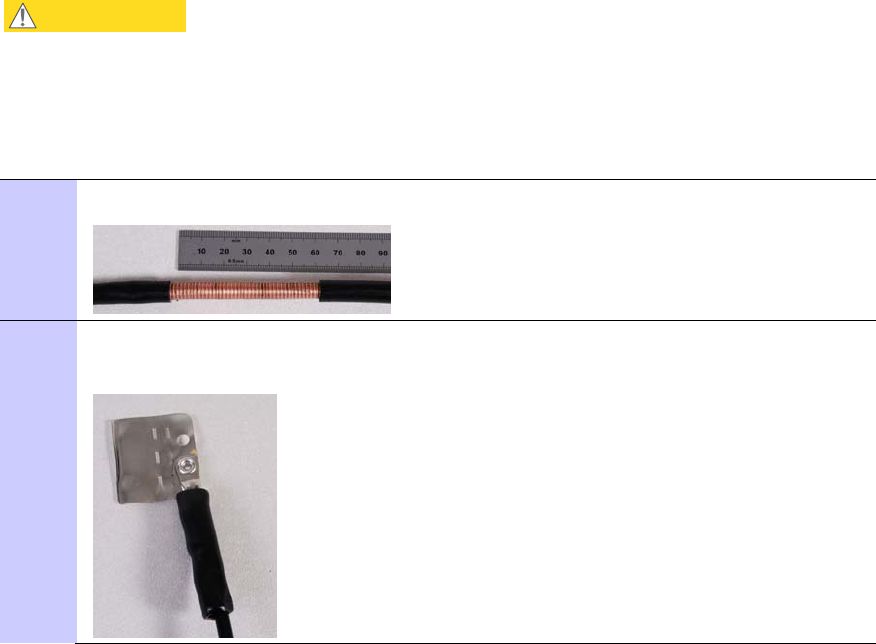
I nst alling t he drop cable and LPU Chapt er 5 I nst allation
phn- 2 182_002v 000
5-22 May 2011
Mak ing a drop cable ground point
Perform this task to connect the screen of the drop cable to the metal of the
supporting structure using a cable grounding kit.
The cable grounding kit for 1/4” and 3/8” cable (Figure 1-8) contains the following
components:
• 1 x grounding cable with grounding 2 hole lug fitted (M10)
• 1 x self Amalgamating tape
• 1 x PVC tape
• 3 x tie wraps
• 2 x bolt, washer and nut
CAUTION
Ground cables must be installed without drip loops and pointing down
towards the ground; otherwise they may not be effective.
To ground the drop cable to a metal structure using the Motorola grounding kit (part
number 01010419001), proceed as follows:
1 Remove 60mm (2.5inches) of the drop cable outer jacket.
2 Cut 38mm (1.5 inches) of rubber tape (self amalgamating) and fit to the
ground cable lug. Wrap the tape completely around the lug and cable.
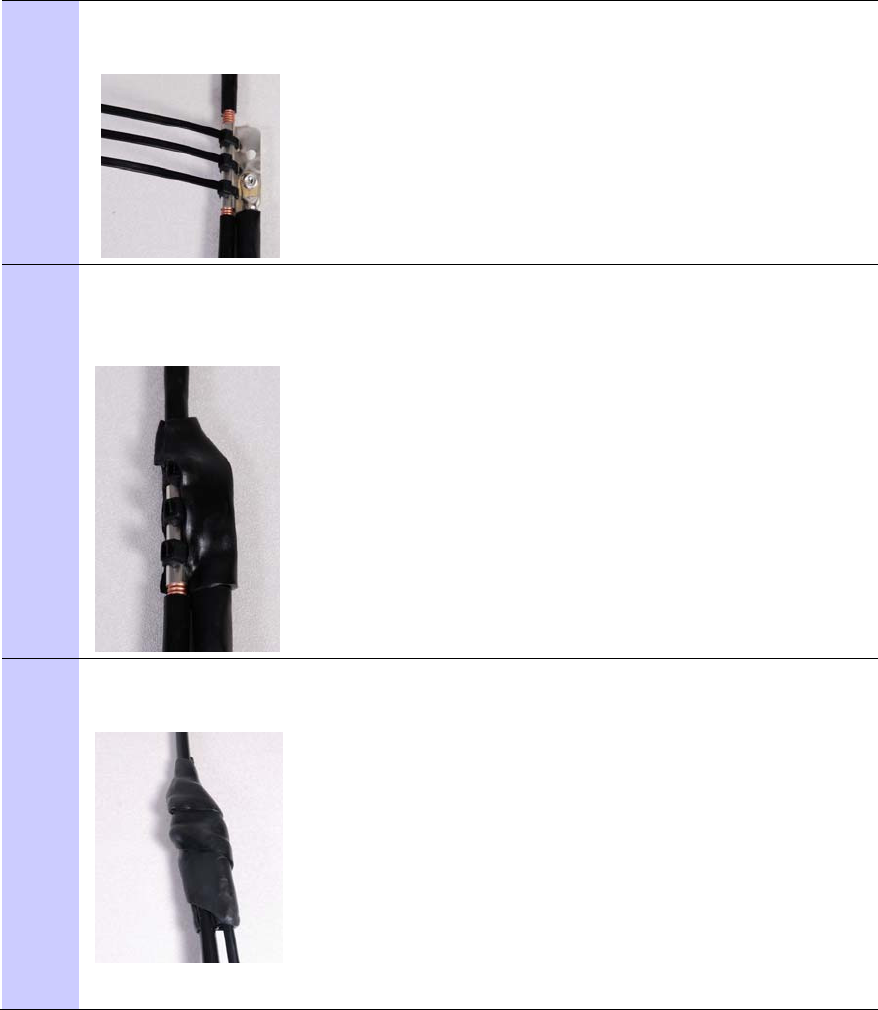
PTP 250 User Guide I nst alling the drop cable and LPU
phn- 2182_002v000
May 2011 5-23
3 Fold the ground wire strap around the drop cable screen. Fit cable ties and
tighten with pliers.
4 Cut the surplus from the cable ties. Cut a 38mm (1.5 inches) section of self-
amalgamating tape and fit to the ground cable lug. Wrap the self-
amalgamating tape completely around the lug and cable.
5 Use the remainder of the self-amalgamating tape to wrap the complete
assembly. Press the tape edges together so that there are no gaps.

I nst alling t he drop cable and LPU Chapt er 5 I nst allation
phn- 2 182_002v 000
5-24 May 2011
6 Wrap a layer of PVC tape, starting from 25mm (1 inch) above the outer
jacket and finishing 25mm (1 inch) below the self-amalgamating tape, over
lapping at half width.
7 Repeat with a further four layers of PVC tape.
Start the second layer 25mm (1 inch) above the first layer tape, start the
third layer below the finish of the second layer. Continue until five layers
have been applied, always over lapping at half width.
8 If a single-hole tag is required at the mast end, modify the two-hole tag as
shown.
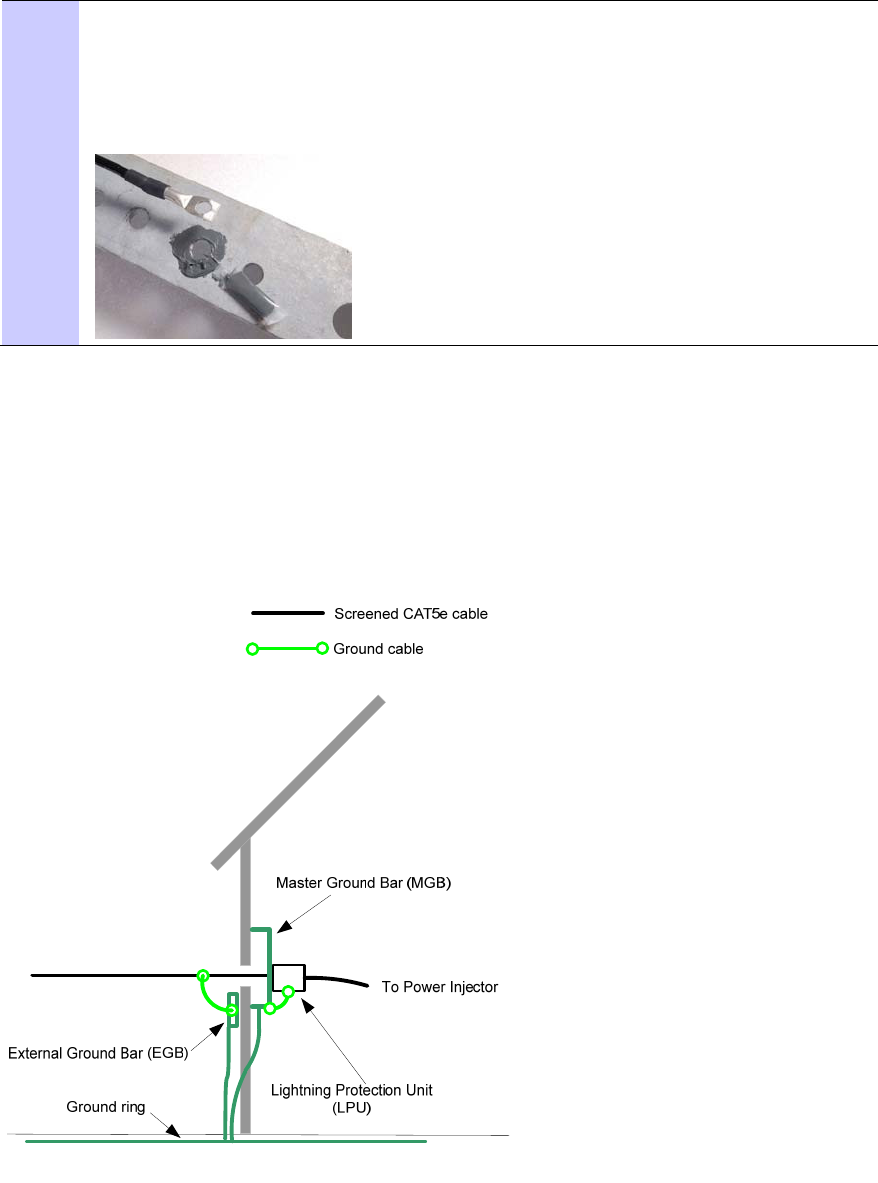
PTP 250 User Guide I nst alling the drop cable and LPU
phn- 2182_002v000
May 2011 5-25
9 Prepare the metal grounding point of the supporting structure to provide a
good electrical contact with the grounding cable:
Remove paint, grease or dirt, if present.
Apply the anti-oxidant compound liberally between the two metals.
I nstalling a nd grounding t he drop cable a t building ent r y
Perform this procedure to install and ground the drop cable and LPU at the building
(or cabinet) entry point (Figure 5-11).
Figure 5 - 1 1 Grounding at building ent ry

I nst alling t he drop cable and LPU Chapt er 5 I nst allation
phn- 2 182_002v 000
5-26 May 2011
To run the drop cable into the building, proceed as follows:
1 Make an entry point into the building and run the main drop cable into
the building.
2 Ground the drop cable to the external ground bar outside the building
entry point, as described in Making a drop cable ground point on page
5-22.
3 Install the LPU inside the building, not more than 600 mm (24 in) from
the building entry point. Mount the LPU with cable glands facing
downwards.
4 Ground the LPU to the master ground bar.
5 Cut any surplus length from the bottom end of the main drop cable
and fit an RJ45 connector and gland, as described in Assembling an
RJ45 connector and gland on page 5-16.
6 Connect the main drop cable to the LPU, as described in Connecting
an RJ45 and gland to a unit on page 5-19.
7 Connect the LPU-PoE cable to the other port of the LPU, as described
in Connecting an RJ45 and gland to a unit on page 5-19.
8 Run the LPU-PoE cable to the location of the PoE power supply.
NOTE
If it is necessary to disconnect the drop cable, refer to Disconnecting an
RJ45 and gland from a unit on page 5-21.

PTP 250 User Guide I nst alling the PoE power supply
phn- 2182_002v000
May 2011 5-27
I nst alling t he PoE pow er supply
Perform this task to install the PoE power supply, connect it to the ODU, and prepare
the network cables.
NOTE
If the PIDU is to be installed rather than the PoE power supply, refer to the
PTP 300 and PTP 500 Series User Guide
(available for download at
www.motorola.com/ptp/software) for PIDU installation instructions.
This task consists of the following procedures:
• Preparing for PoE power supply installation on page 5-27
• Mounting the PoE power supply on page 5-28
• Connecting the PoE power supply to the drop cable on page 5-29
• Preparing the PoE power supply to network equipment cable on page 5-30
Preparing for PoE pow er supply insta lla t ion
The PoE power supply can be installed free standing, on an even horizontal surface or
wall mounted using wall mounting key holes on the underside of the unit. The
following guidelines should be adhered to before cabling the PoE power supply to the
Ethernet source and ODU:
• Verify the device receiving power and Ethernet from the PoE power supply is a
PTP 250 ODU.
• Do not block or cover airflow to the PoE power supply.
• Keep the PoE power supply away from excessive heat, humidity, vibration and
dust.
• The PoE power supply is not a repeater, and does not amplify the Ethernet data
signal. Do not configure the cable length between the Ethernet network source,
the PoE power supply and the PTP 250 ODU beyond 100 meters (333ft).
CAUTION
The PoE power supply is not waterproof and should be mounted away from
sources of moisture. If mounted outdoors, the unit should be mounted in a
moisture proof enclosure, preferably ventilated.
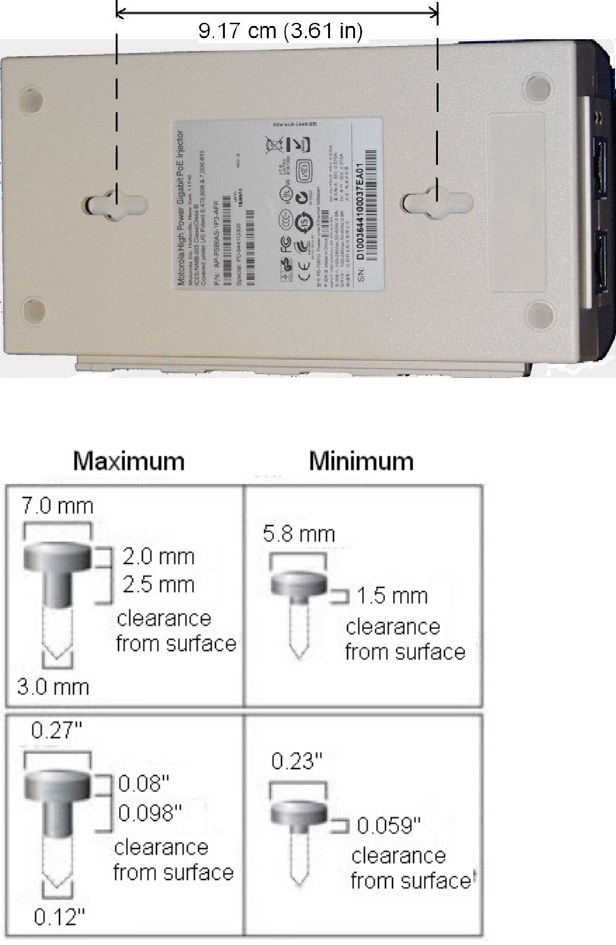
I nst alling t he PoE power supply Chapt er 5 I nst allation
phn- 2 182_002v 000
5-28 May 2011
Mount ing t he PoE pow er supply
To mount the PTP 250 PoE power supply: install two screws (Table 5-1) in the wall or
shelf, then align the mounting slots (Figure 5-12) to capture the surface screws.
Figure 5 - 1 2 Mount ing slot s on underside of PoE power supply
Table 5 - 1 Screw dim ensions for t he PoE pow er supply
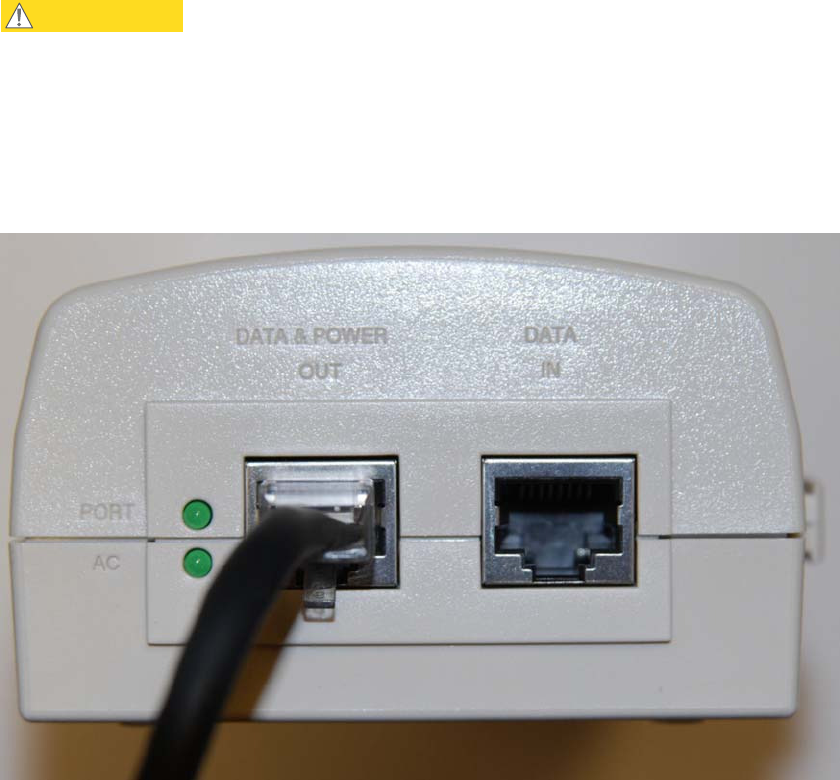
PTP 250 User Guide I nst alling the PoE power supply
phn- 2182_002v000
May 2011 5-29
Conne ct ing t he PoE pow er supply t o t he drop cable
The drop cable from the ODU is connected to the DATA & POWER OUT interface of
the PoE power supply.
CAUTION
Do not dress the PoE power supply cables too tightly, as this may make the
connections unreliable.
Fit an RJ45 connector (but no gland) to the PoE end of the LPU-PoE cable. Connect the
cable to the DATA & POWER OUT interface of the PoE power supply.
Figure 5 - 1 3 PoE power supply connect ed t o LPU- PoE cable

I nst alling t he PoE power supply Chapt er 5 I nst allation
phn- 2 182_002v 000
5-30 May 2011
Preparing t he PoE pow er supply t o ne t w ork equipm ent cable
Prepare the CAT5e cable that will connect the PoE power supply to the network
equipment. This cable must meet the following requirements:
• Use either foil screen (FTP) or braided screen (STP) cable.
• Use screened RJ45 connectors with metal shells at both ends.
• Ensure there is a continuous electrical connection between both screened
connectors.
CAUTION
The connected network equipment must feature screened RJ45
connectors and must be connected to ground, otherwise the PoE power
supply will not be grounded.
The PoE power supply is not normally connected to the network equipment until
antenna alignment is complete. See Connecting to the network on page 6-35.

Cha pt e r 6
phn- 2182_002v000
May 2011 6-1
Chapt er 6 Configurat ion and alignm ent
. . . . . . . . . . . . . . . . . . . . . . . . . . . . . . . . . . . . . . . . . . . . . . . . . . . . . . . . . . . .
.
.
.
This chapter describes all configuration and alignment tasks that are performed when
a PTP 250 link is deployed.
Before proceeding with unit configuration and antenna alignment, observe the
precautions described in Preparing for configuration and alignment on page 6-2.
Configure the two units, one as ‘Master’ and the other as ‘Slave’ by performing the
following tasks:
• Connecting to the unit on page 6-3 describes how to connect a PC to the unit,
power it up and open the web interface.
• Upgrading firmware version on page 6-10 describes how to ensure that the latest
firmware version is installed on the unit.
• Using the installation wizard on page 6-14 describes how to configure the LAN,
wireless, date and email attributes of the unit.
When all equipment has been installed at both link ends, perform the following tasks:
• Aligning antennas on page 6-24 describes how to align integrated and
connectorized antennas.
• Connecting link to the network on page 6-31 describes how to review link
performance and connect to the network.

Pr eparing for configuration and alignm ent Chapt er 6 Configurat ion and alignm ent
phn- 2 182_002v 000
6-2 May 2011
Prepa r ing for configurat ion a nd alignm ent
This section describes the checks to be performed before proceeding with unit
configuration and antenna alignment.
Safe t y pr e caut ions during configurat ion and a lignm ent
All national and local safety standards must be followed while configuring the units
and aligning the antennas.
WARNING
Ensure that personnel are not exposed to unsafe levels of RF energy.
The units start to radiate as soon as they are powered up. Respect the
safety standards defined in Compliance with safety standards on
page 4-22, in particular the minimum separation distances. Observe
the following guidelines:
o Never work in front of the antenna when the ODU is powered.
o Always power down the PoE power supply (or PIDU) before connecting or
disconnecting the drop cable from either the power supply, ODU or LPU.
Regulat ory com plia nce during configurat ion and alignm ent
All applicable radio regulations must be followed while configuring the units and
aligning the antennas. For more information, refer to Compliance with radio
regulations on page 4-27.
Selecting configura t ion opt ions
Use the installation report to determine which configuration options are required.
Refer to PTP LINKPlanner on page 2-8.

PTP 250 User Guide Connect ing to t he unit
phn- 2182_002v000
May 2011 6-3
Conne ct ing t o the unit
Perform this task to connect a management PC to the unit, power it up and open the
web interface.
This task consists of the following procedures:
• Configuring the management PC on page 6-3
• Connecting to the PC and powering up on page 6-5
• Logging into the web interface on page 6-6
Configur ing t he m anagem e nt PC
NOTE
Install Java on the management PC (if not already installed), as this is used
by the PTP 250 web interface.
To configure the local management PC to communicate with the PTP 250, proceed as
follows:
1 Select Properties for the Ethernet port.
2 Select the Internet Protocol (TCP/IP) item as shown in Figure 6-1.
3 Click on Properties.
4 Enter an IP address that is valid for the 169.254.X.X network, avoiding:
169.254.0.0 and 169.254.1.1 and 169.254.1.2
A good example is 169.254.1.3 (Figure 6-2).
5 Enter a subnet mask of 255.255.0.0.
Leave the default gateway blank.
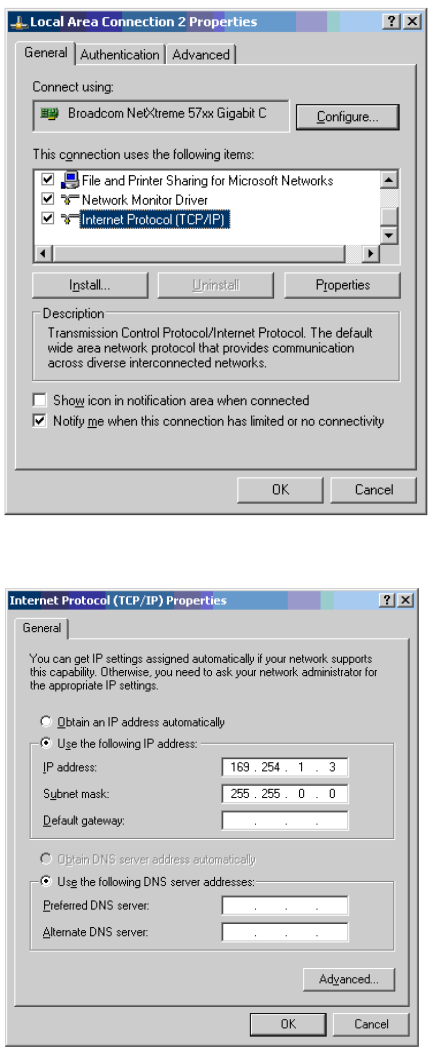
Connect ing t o t he unit Chapt er 6 Configurat ion and alignm ent
phn- 2 182_002v 000
6-4 May 2011
Figure 6 - 1 I P configuration on the PC
Figure 6 - 2 I nt ernet Protocol (TCP/ I P) Properties page
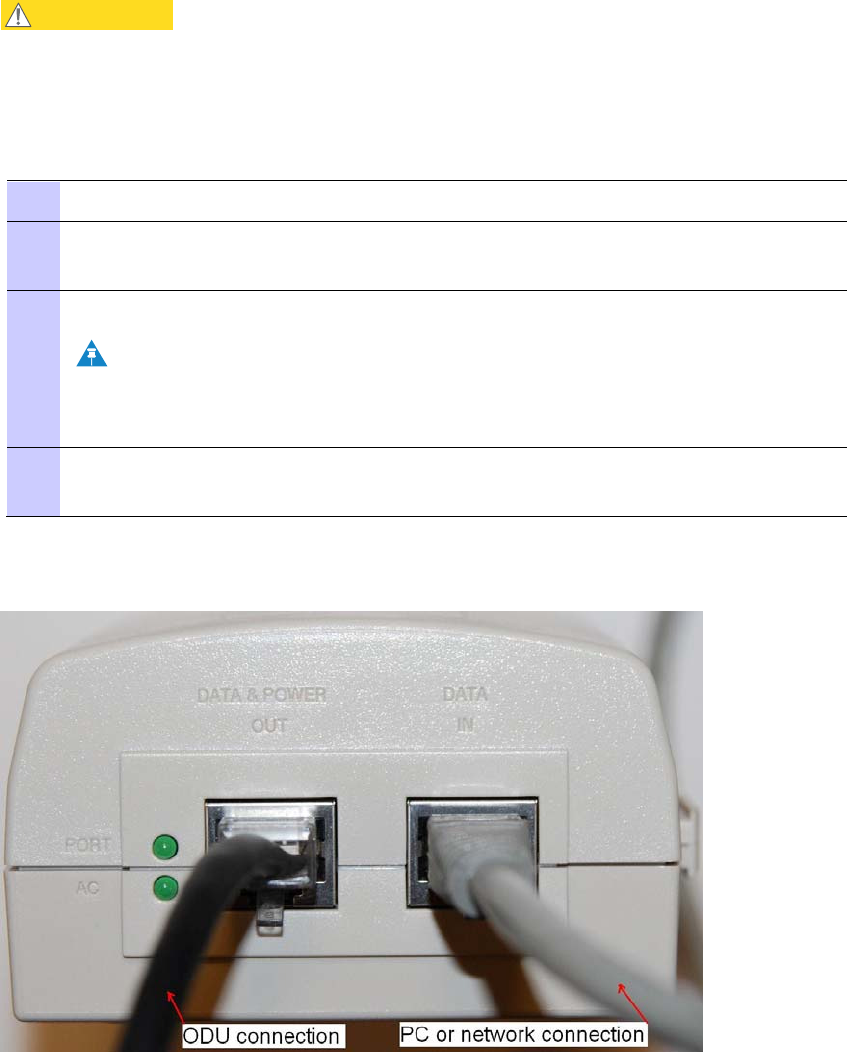
PTP 250 User Guide Connect ing to t he unit
phn- 2182_002v000
May 2011 6-5
Conne ct ing t o t he PC a nd pow ering up
CAUTION
Ensure AC power is supplied to the PoE power supply using an AC cable
with an appropriate ground connection approved for the country of
operation.
To connect the ODU to the PC and power up the unit, proceed as follows:
1 Check that the ODU and PoE power supply are correctly connected.
2 Connect the PC Ethernet port to the DATA IN port of the PoE power
supply using a standard (not crossed) Cat5e cable (Figure 6-3).
3 Connect the PoE power supply to an AC outlet (100 V AC to 240 V AC).
NOTE
The PoE power supply has no power switch. It supplies power to the
ODU as soon as AC power is applied.
4 Check that the AC and PORT LEDs illuminate (green steady). If they blink
or do not illuminate, refer to Testing link end hardware on page 8-2.
Figure 6 - 3 PoE power supply connect ed t o ODU and PC (or network)

Connect ing t o t he unit Chapt er 6 Configurat ion and alignm ent
phn- 2 182_002v 000
6-6 May 2011
NOTE
If the power supply is a PIDU, the Ethernet LED does not illuminate.
Logging int o t he w eb int erface
To log into the web interface as a system administrator, proceed as follows:
1 Start the web browser from the management PC.
2 Type the IP address of the unit (factory default is 169.254.1.1) into the
address bar. Press ENTER.
For user security, Motorola digitally signs its applications. On the first
login, the digital signature confirmation is displayed (Figure 6-4). Tick the
‘Always trust content from this publisher’ box and select Run.
The digitally signed Java app splash screen is displayed (Figure 6-5),
followed by the Login page.
3 When the Login page is displayed (Figure 6-6), enter the Username ‘admin’
and Password (default ‘motorola’) and select Login.
4 On the first login to a new unit, or on the first login to a unit that has been
reset to full or partial default configuration, the Change Password page is
displayed (Figure 6-7). Enter and confirm the new Password.
5 On the first login to a new unit, or on the first login to a unit that has been
reset to full default configuration, the Set Country Code page is displayed
(Figure 6-8). Select the Country Code and select OK to confirm it is correct.
CAUTION
Ensure the correct Country Code is selected. An incorrect selection
may result in illegal radio operation. Once set, the Country Code can
only be changed by using the reset switch, as described in Resetting to
default configuration (with country reset) on page 7-26.
6 The web interface menu and System Summary page are displayed (Figure
6-9). Continue with configuration.
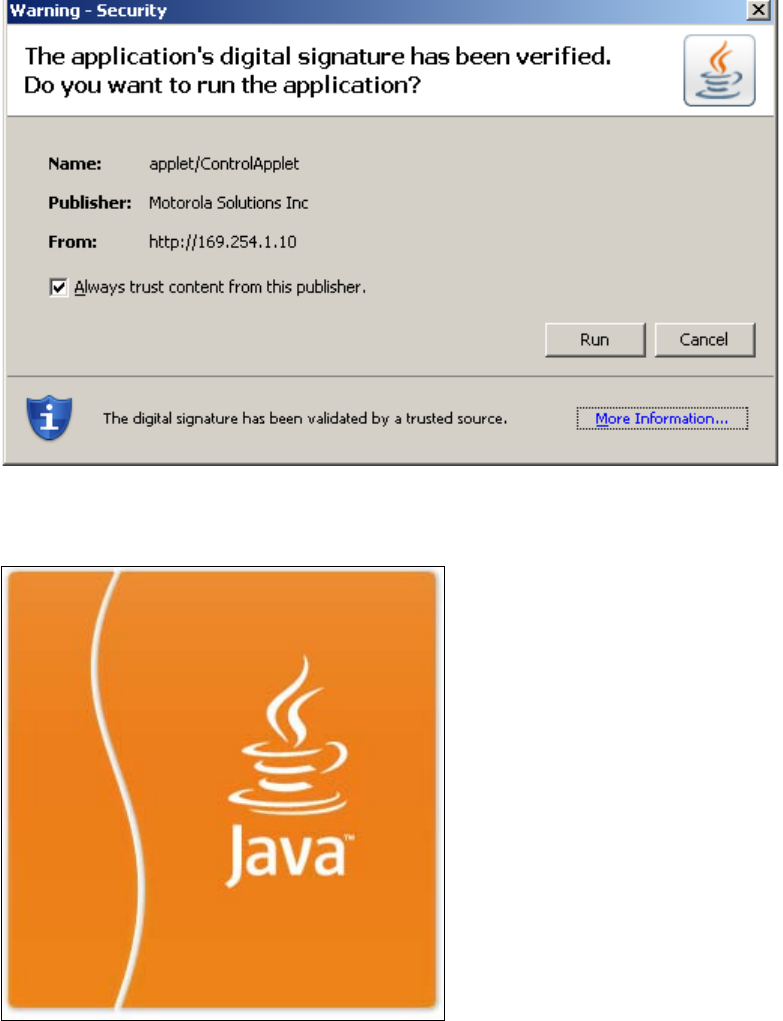
PTP 250 User Guide Connect ing to t he unit
phn- 2182_002v000
May 2011 6-7
Figure 6 - 4 Digital signature confirm ation ( on first login)
Figure 6 - 5 Digit ally signed Java app splash screen
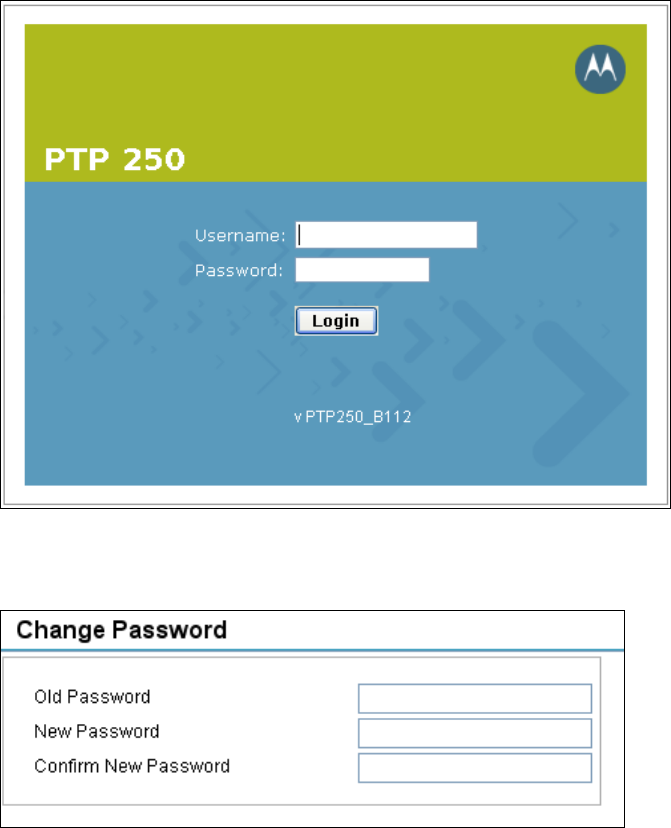
Connect ing t o t he unit Chapt er 6 Configurat ion and alignm ent
phn- 2 182_002v 000
6-8 May 2011
Figure 6 - 6 Login page
Figure 6 - 7 Change Password page ( on first login)
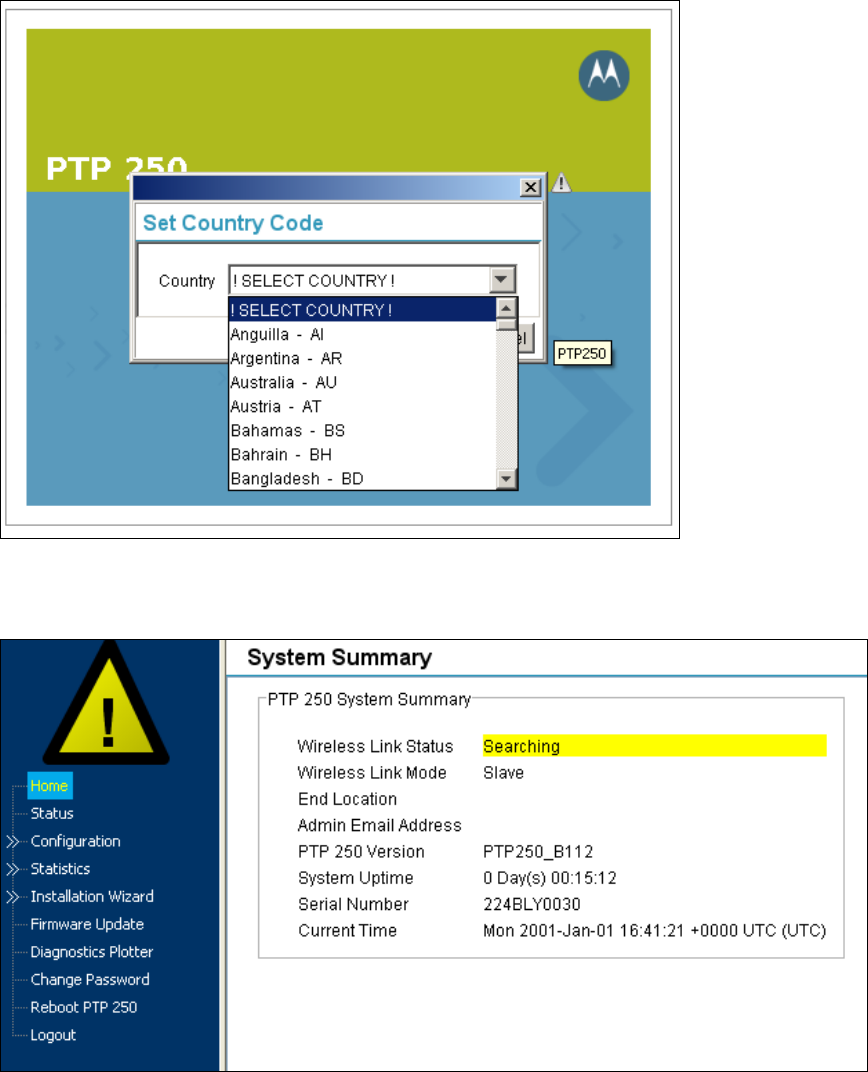
PTP 250 User Guide Connect ing to t he unit
phn- 2182_002v000
May 2011 6-9
Figure 6 - 8 Set Count ry Code page ( on first login)
Figure 6 - 9 Menu and Syst em Sum m ary page ( on first login)
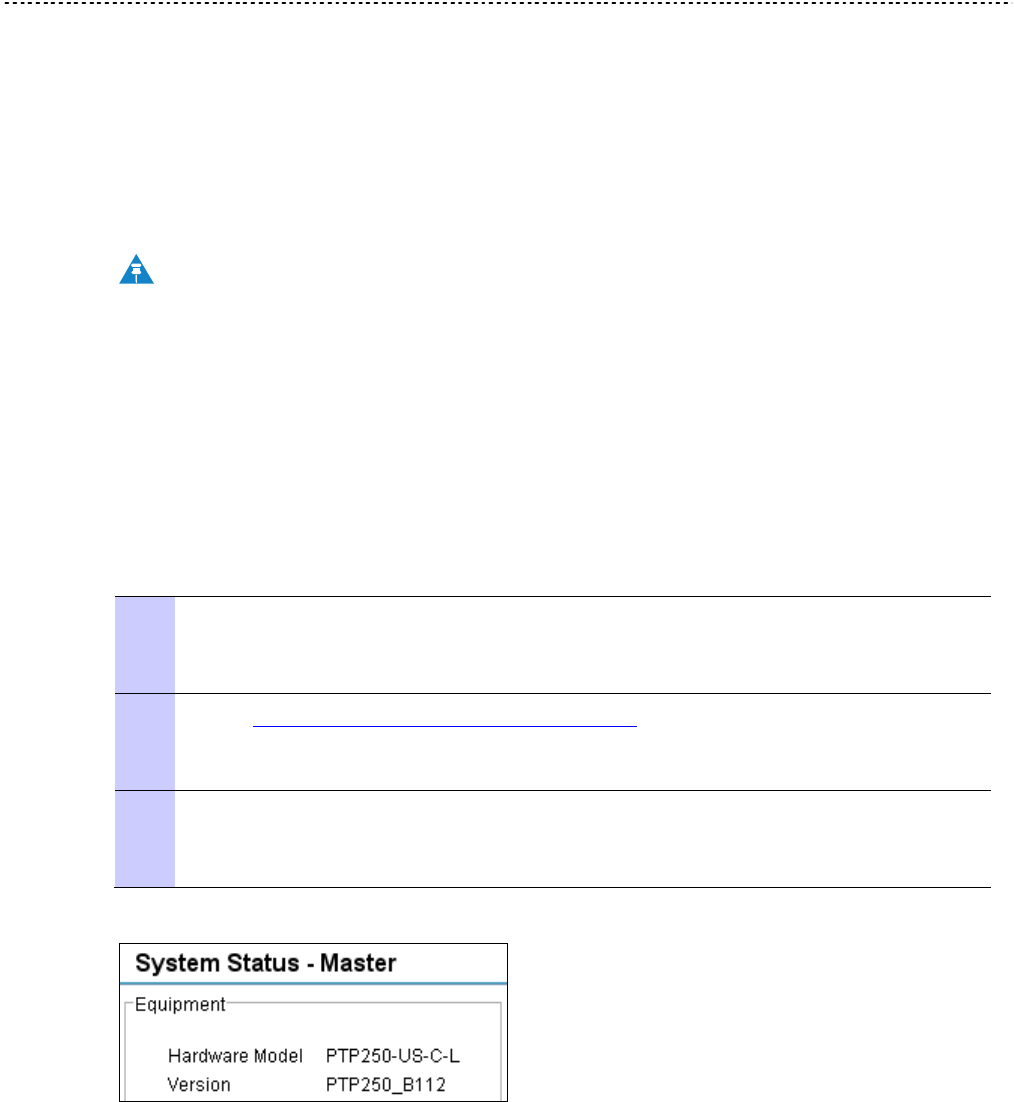
Upgr ading firm ware version Chapt er 6 Configurat ion and alignm ent
phn- 2 182_002v 000
6-10 May 2011
Upgr ading firm w a r e ve rsion
Perform this task to ensure that the latest firmware version is installed on the unit.
This task consists of the following procedures:
• Checking the installed firmware version on page 6-10
• Saving the system configuration on page 6-11
• Uploading a new firmware version on page 6-12
NOTE
Ensure that the correct units are upgraded, as units cannot easily be
downgraded afterwards.
If the link is operational, ensure that the remote end of the link is upgraded
first using the wireless connection, and then the local end can be upgraded.
Otherwise, the remote end may not be accessible.
Che cking t he insta lled firm w are ve r sion
To check that the latest firmware version is installed, proceed as follows:
1 Select menu option Status. The System Status page is displayed. The
Version attribute near the top left is the installed firmware version (Figure
6-10).
2 Go to http://www.motorola.com/ptp/support and find Point-to-Point software
updates. Check that the latest available firmware version (for example 250-
04-01) is the same as the one already installed.
3 If the unit needs to be upgraded to the latest firmware version, perform
Saving the system configuration on page 6-11 and Uploading a new firmware
version on page 6-12.
Figure 6 - 1 0 Firm ware Version in Syst em St atus page
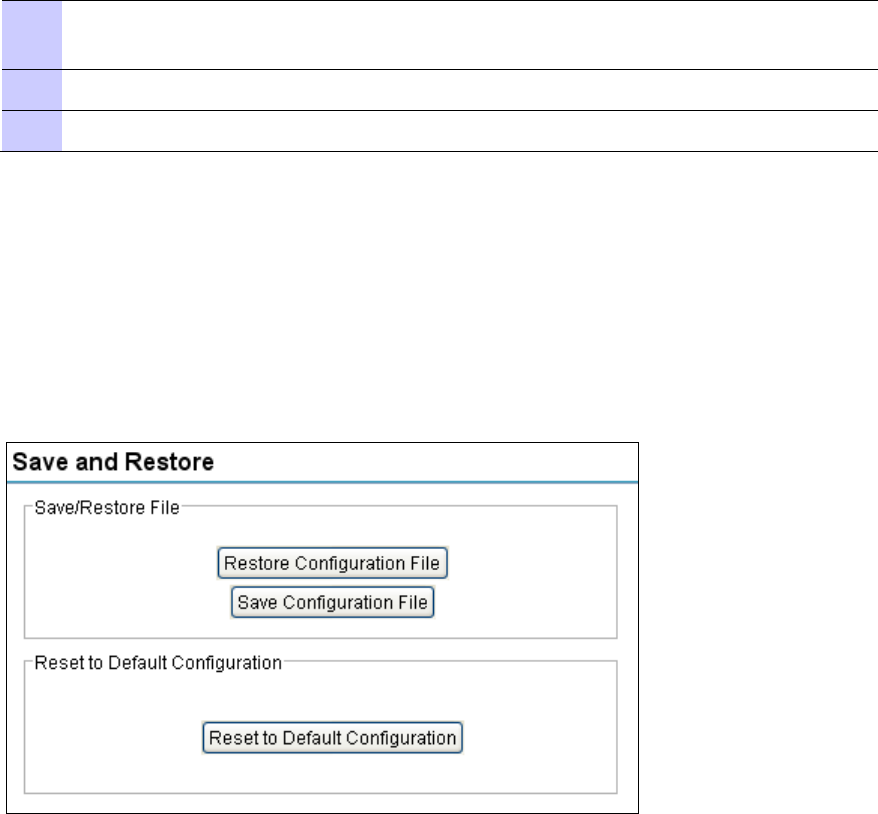
PTP 250 User Guide Upgr ading fir m ware version
phn- 2182_002v000
May 2011 6-11
Saving t he syst e m configurat ion
To save the current configuration before upgrading to a new firmware version,
proceed as follows:
1 Select menu option System, Configuration, Save And Restore. The Save
and Restore page is displayed (Figure 6-11).
2 Select Save Configuration File.
3 Save the configuration file to a PC hard drive.
The configuration file format is:
mm-mm-mm-mm-mm-mm_iii-iii-iii-iii.cfg
W he re : I s:
mm-mm-mm-mm-mm-mm MAC address of unit
iii-iii-iii-iii IP address of unit.
Figure 6 - 1 1 Save & Rest ore page

Upgr ading firm ware version Chapt er 6 Configurat ion and alignm ent
phn- 2 182_002v 000
6-12 May 2011
Uploading a new firm w are ve r sion
Before performing a firmware upload, save the configuration as described in Saving
the system configuration on page 6-11.
To upload a new firmware version, proceed as follows:
1 Go to http://www.motorola.com/ptp/support and find Point-to-Point software
updates. Download and save the required firmware image (for example
PTP250- 04- 01. bi n).
2 Select menu option Firmware Update. The Firmware Update page is
displayed (Figure 6-12).
3 Select the Method. The default is HTTP.
If FTP or TFTP is selected, additional attributes are displayed and must be
completed.
4 Select Browse. Navigate to the folder containing the downloaded firmware
image and select Open.
5 Select Start Firmware Upload and Yes to confirm. The upload progress is
displayed. On completion, the Upload Successful page is displayed (Figure
6-13).
To ensure that only authorized Motorola firmware is installed, the unit
checks the image for a DSA signature. If the DSA signature is missing or
incorrect, an error message is displayed and the upload fails.
6 Select Apply and Reboot.
7 The reboot process will take up to 120 seconds. During this time it will not
be possible to communicate with the unit. After the reboot, check that the
required firmware image is loaded and running.
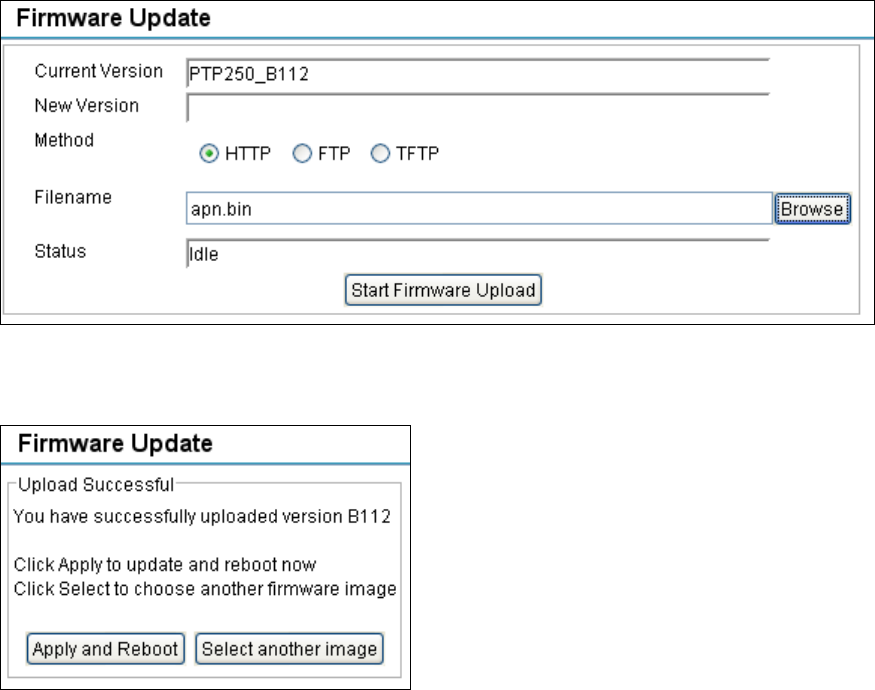
PTP 250 User Guide Upgr ading fir m ware version
phn- 2182_002v000
May 2011 6-13
Figure 6 - 1 2 Firm ware Updat e page
Figure 6 - 1 3 Upload Successful page
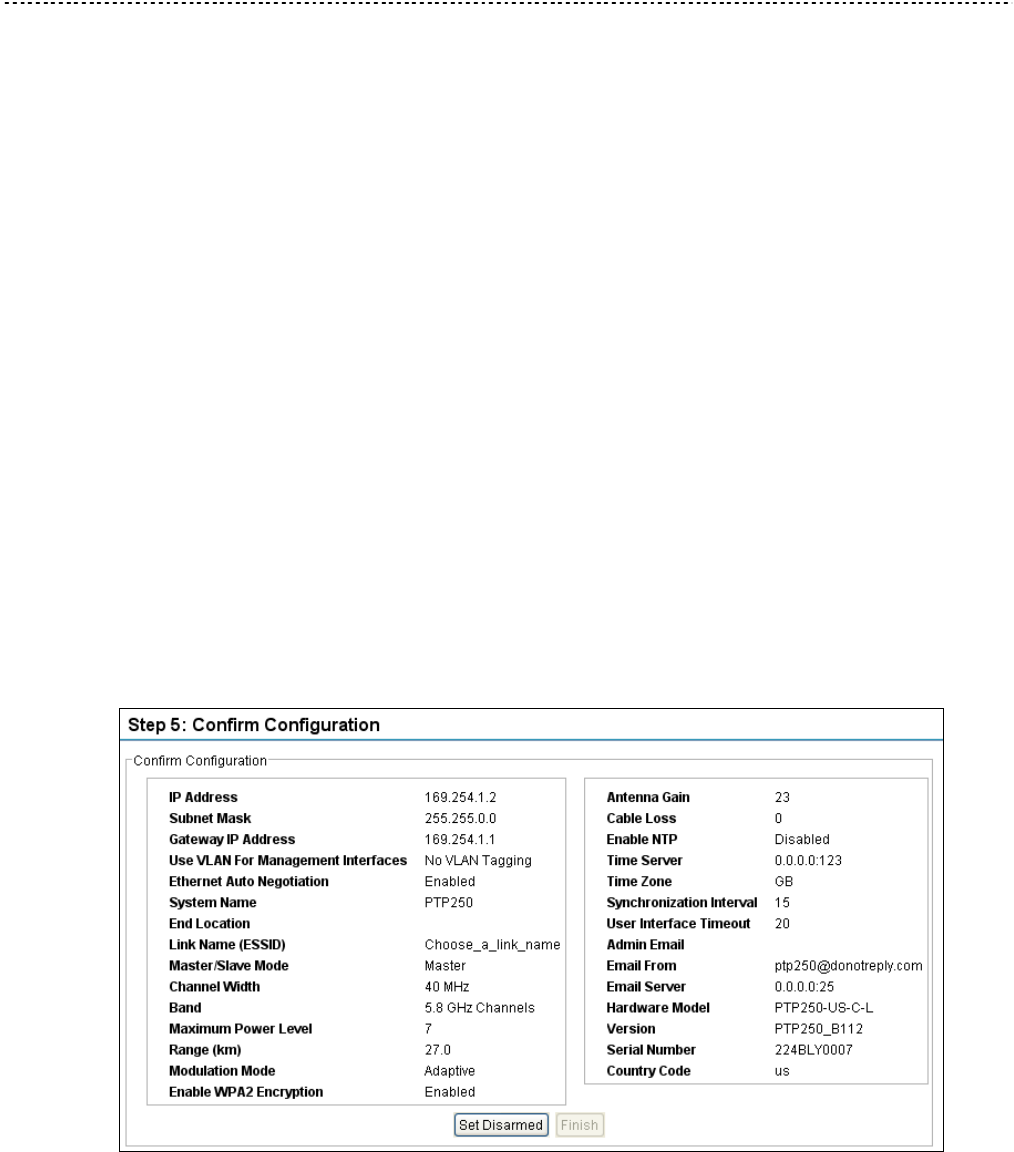
Using the inst allation wizar d Chapt er 6 Configuration and alignm ent
phn- 2 182_002v 000
6-14 May 2011
Using t he inst allat ion w iza r d
Perform this task to configure the LAN, wireless, date and email attributes of the unit.
This task consists of the following procedures:
• Starting installation wizard on page 6-14
• Step 1: LAN configuration on page 6-15
• Step 2: Wireless configuration on page 6-17
• Step 3: Date and time settings on page 6-20
• Step 4: Email configuration on page 6-22
• Step 5: Confirm installation configuration on page 6-23
Sta r t ing insta lla t ion w iza rd
To start the installation wizard, select menu option Installation Wizard. The
response depends upon the state of the unit:
• If the unit is armed for alignment, the Step 5: Confirm Configuration page is
displayed (Figure 6-14). Select Set Disarmed, Yes to confirm and then Back
until the Step 1: LAN Configuration page is displayed.
• If the unit is not armed, the Step 1: LAN Configuration page is displayed.
Figure 6 - 1 4 St ep 5: Confirm Configuration page ( when unit is arm ed)
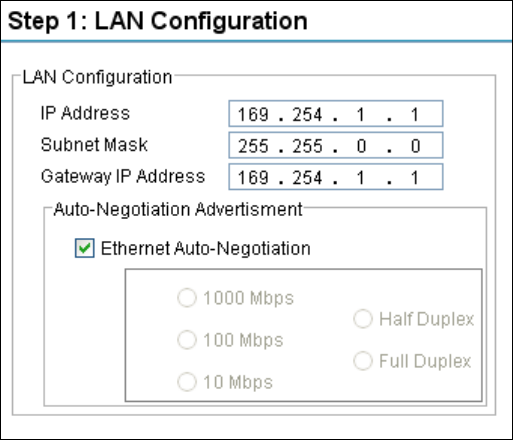
PTP 250 User Guide Using the inst allation wizar d
phn- 2182_002v000
May 2011 6-15
Step 1 : LAN configurat ion
Step 1 of the Installation wizard is for updating the LAN configuration (Figure 6-15).
The attributes are described in Table 6-1.
Update IP Address, Subnet Mask and Gateway IP Address to meet network
requirements (as specified by the network administrator). Update the other attributes
as required and select Next.
Figure 6 - 1 5 St ep 1: LAN Configuration page

Using the inst allation wizar d Chapt er 6 Configuration and alignm ent
phn- 2 182_002v 000
6-16 May 2011
Table 6 - 1 St ep 1: LAN Configuration att ribut es
Att r ibute Me aning
IP Address Internet protocol (IP) address. This address is used by the
family of Internet protocols to uniquely identify this unit on a
network. All units are shipped with a default IP address of
169.254.1.1.
NOTE
Change this default IP address to ensure that: (a) it is
unique on the network, and (b) the Master and Slave
units have different IP addresses.
Subnet Mask Defines the address range of the connected IP network.
Gateway IP
Address
The IP address of a computer on the current network that acts
as a gateway. A gateway acts as an entrance and exit to
packets from and to other networks.
Ethernet Auto-
Negotiation
When the box is ticked, it means that configuration is
automatically negotiated. This is the default setting.
When the box is not ticked, it means that configuration is
forced. Select the data rate that the auto-negotiation
mechanism will advertise as available.
CAUTION
Only select a data rate that is within the capability of
connected network equipment, otherwise loss of service
may occur.
NOTE
Use the same setting for both ends of the link.
The configuration should only be forced if problems are
experienced with auto-negotiation.
Instead of forcing configuration, the IEEE802.3
specification recommends enabling Auto-Negotiation
with only the specific ability or abilities advertised.
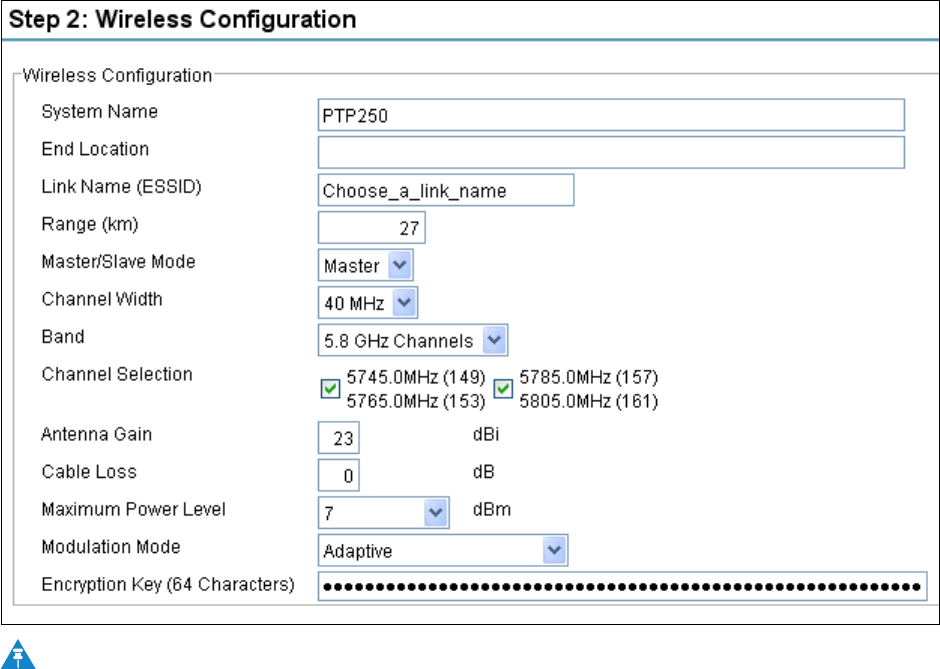
PTP 250 User Guide Using the inst allation wizar d
phn- 2182_002v000
May 2011 6-17
Step 2 : W ire less configur a t ion
Step 2 of the Installation wizard is for updating the wireless configuration (Figure
6-16). The attributes are described in Table 6-2. Update the attributes as required and
select Next.
Figure 6 - 1 6 St ep 2: Wireless Configurat ion page
NOTE
When installing connectorized units, ensure that Antenna Gain, Cable Loss
and Maximum Power Level are within regulatory limits. For more
information, refer to Calculating EIRP for connectorized units on page 4-30.

Using the inst allation wizar d Chapt er 6 Configuration and alignm ent
phn- 2 182_002v 000
6-18 May 2011
Table 6 - 2 St ep 2: Wireless Configurat ion att ribut es
Att r ibute Me aning
System Name A name for the link. Spaces are not allowed, so use
underscores instead.
End Location The location of the link end. Spaces are not allowed, so use
underscores instead.
Link Name
(ESSID)
A link can only be established between units that have
identical Link Names.
Link Name may consist of letters (A-Z and a-z), numbers (0-9)
and the following special characters (no spaces):
(),-.,:<=>[]_{}
Range (km) The link range. The value must not be less than the actual
distance between the link ends.
Master/Slave
Mode
Each link consists of one ‘Master’ and one ‘Slave’ unit. The
Master is used to control and maintain the point-to-point link.
The Master transmits until the link is made, while the Slave
listens for its Master and only transmits when the Master has
been identified.
As all units are shipped with a default setting of ‘Slave’, one
unit in the link must be reset to ‘Master’.
Channel Width Width (MHz) of the radio channel used by this link. The
selection depends upon the frequency variant and country of
operation. This can only be updated at the Master unit.
Band The frequency band (GHz) in which this link operates.
This can only be updated at the Master unit.
Channel Selection The channel (MHz) in which this link operates. This can only
be updated at the Master unit.
If Channel Width is set to 40 MHz, then each tick box selects
two 20 MHz channels: the first is Current Channel and the
second is Extended Channel.
Antenna Gain Gain (dBi) of the antenna that is connected to this unit. See
Antenna specifications on page 4-14.

PTP 250 User Guide Using the inst allation wizar d
phn- 2182_002v000
May 2011 6-19
Att r ibute Me aning
Cable Loss Loss (dB) in the RF cable between the ODU and the antenna.
NOTE
If there is a significant difference in length of the antenna
cables for the two antenna ports, then enter the average
value.
Maximum Power
Level
The maximum power (dBm) at which the unit will transmit.
Modulation Mode The modulation mode used on the transmit channel. The
recommended setting is ‘Adaptive’.
Encryption Key
(64 characters)
Key to be used for link encryption. The same key must be
used at both ends of the link.
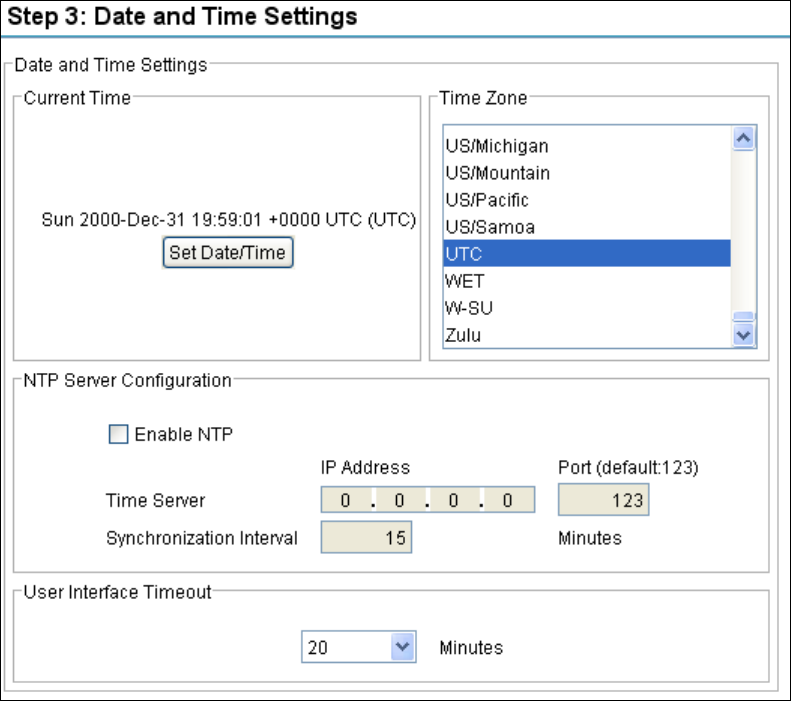
Using the inst allation wizar d Chapt er 6 Configuration and alignm ent
phn- 2 182_002v 000
6-20 May 2011
Step 3 : Da t e and t im e set t ings
Step 3 of the Installation wizard is for setting the date and time (Figure 6-17). The
attributes are described in Table 6-3. Update the attributes as required and select
Next.
The clock supplies accurate date and time information to the system. It can be set to
run with or without a connection to a Network Time Protocol (NTP) server:
• In the absence of an NTP server connection, the clock can be set to run manually.
The clock is battery backed and will continue to operate for several days after the
ODU is switched off.
• If an NTP server connection is available, the clock can be set to synchronize with
the server time at regular intervals.
Figure 6 - 1 7 St ep 3: Dat e and Tim e Sett ings page

PTP 250 User Guide Using the inst allation wizar d
phn- 2182_002v000
May 2011 6-21
Table 6 - 3 St ep 3: Dat e and Tim e Sett ings attribut es
Att r ibute Me aning
Current Time The current date and time setting for this unit.
To update this, select Set Date/Time.
Time Zone The time zone in which this unit operates.
Enable NTP If this is ticked, the PTP 250 will obtain accurate date and
time updates from a networked time server.
Time Server IP
Address
The IP address of the networked NTP server.
Time Server Port The port number of the networked NTP server. By
convention the default value is 123.
Synchronization
Interval
The interval at which the PTP 250 requests time correction
updates from the NTP server. If a request fails, the PTP 250
automatically performs three retries before waiting for the
next Synchronization Interval.
User Interface
Timeout
The time that is allowed to pass without user activity before
the user is logged out.
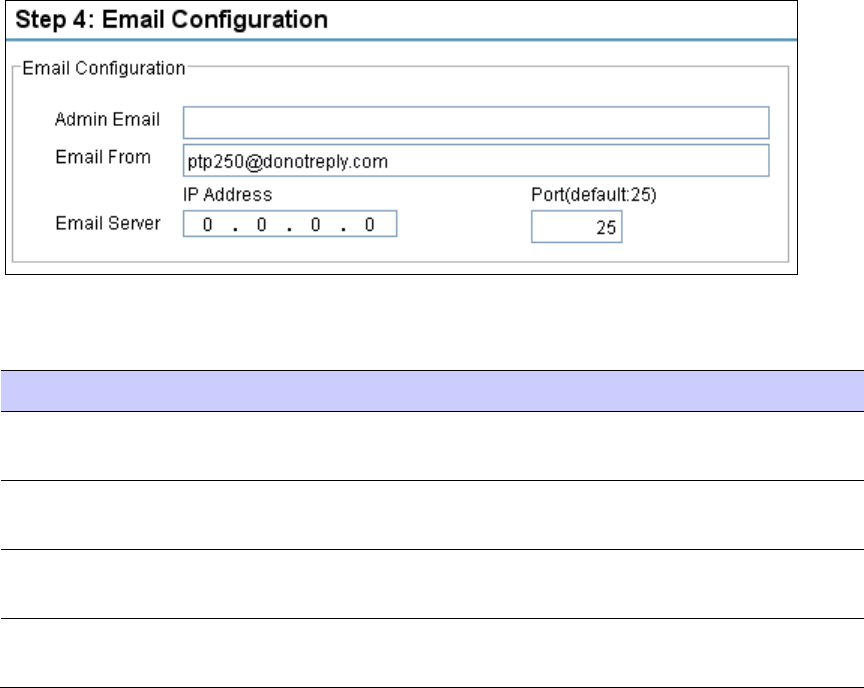
Using the inst allation wizar d Chapt er 6 Configuration and alignm ent
phn- 2 182_002v 000
6-22 May 2011
Step 4 : Em ail configurat ion
Step 4 of the Installation wizard is for configuring email notifications (Figure 6-18).
The attributes are described in Table 6-4. Update the attributes as required and select
Next.
Figure 6 - 1 8 St ep 4: Em ail Configurat ion page
Table 6 - 4 St ep 4: Email Configurat ion at t ribut es
Att r ibute Me aning
Admin Email The email address to which the PTP 250 will send the alert
messages.
Email From The email address used by the PTP 250 to log into the email
server. This must be recognized by the server.
Email Server IP
Address
The IP address of the networked email server.
Email Server Port The port number used by the networked email server. By
convention the default value is 25.
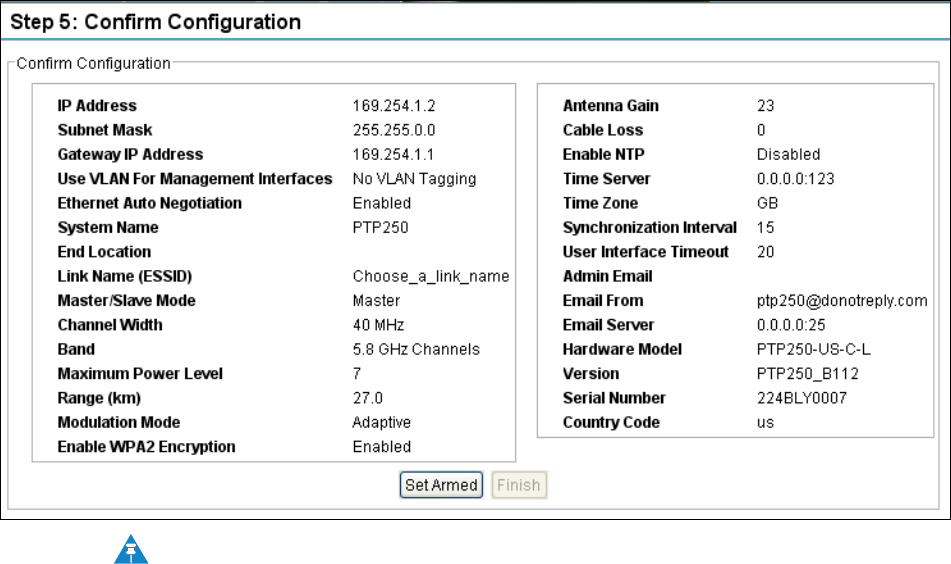
PTP 250 User Guide Using the inst allation wizar d
phn- 2182_002v000
May 2011 6-23
Step 5 : Confirm inst a lla t ion configurat ion
Step 5 of the Installation wizard is for reviewing and confirming the updated attributes
(Figure 6-19).
If any of the attributes are incorrect, select Back to return to previous steps and
update them.
If all attributes are correct, choose one of the following options:
• If antenna alignment tones are not wanted, select Finish. This is the preferred
option before bench testing the units.
• If antenna alignment tones are wanted, select Set Armed and Yes to confirm.
This is the preferred option before site installation and antenna alignment.
Figure 6 - 1 9 St ep 5: Confirm Configurat ion page
NOTE
If the IP Address, Subnet Mask or Gateway IP Address of the unit have been
updated to meet network requirements, then reconfigure the local
management PC to use an IP address that is valid for the network. Refer to
Configuring the management PC on page 6-3.

Aligning antennas Chapter 6 Configurat ion and alignm ent
phn- 2 182_002v 000
6-24 May 2011
Aligning ant ennas
Before performing this task, check that hardware installation is complete (apart from
the network connections) at both the Master and Slave sites.
This task consists of the following procedures:
• Starting up the units on page 6-24
• Checking that the units are armed on page 6-25
• Aligning antennas on page 6-25
• Aligning separate antennas for spatial diversity on page 6-27
• Monitoring received signal level on page 6-27.
• Disarming the units on page 6-30
Sta r t ing up t he unit s
To connect one of the units to a management PC and start up both units, proceed as
follows:
1 Select the unit from which this process is to be controlled; either Master
or Slave. This is the ‘local’ unit.
2 Check that the management PC is connected to the local unit, powered up
and logged on.
3 Start the local unit.
4 Start the remote unit.
5 Log into the local unit as described in Logging into the web interface on
page 6-6.
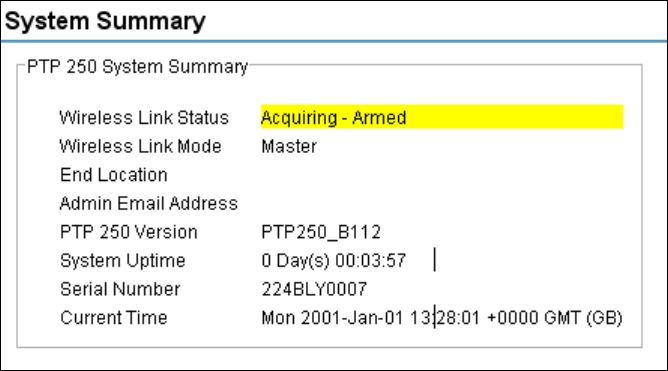
PTP 250 User Guide Aligning antennas
phn- 2182_002v000
May 2011 6-25
Che cking t hat t he unit s are a r m ed
Select menu option Home. The System Summary page is displayed. Check that the
Wireless Link Status contains the word ‘Armed’ (Figure 6-20); this confirms that the
units are ready for alignment.
Figure 6 - 2 0 Syst em Sum m ary page ( when unit is arm ed)
If the units are not armed, use the installation wizard (Step 5) to arm them, as
described in Using the installation wizard on page 6-14.
Aligning a nt enna s
Use this procedure to align linked antennas (master and slave), whether integrated or
connectorized.
Prior to alignment, ensure that the following parameters are available:
• Location of both sites (latitude and longitude).
• Bearing to the other end of the link for both sites.
• Prediction of receive signal level for both ends of the link.
• Prediction of link loss.
PTP LINKPlanner provides all of these parameters in the form of an installation report.
If a connectorized ODU is installed at either site with two separate antennas for spatial
diversity, refer to Aligning separate antennas for spatial diversity on page 6-27 before
starting alignment.

Aligning antennas Chapter 6 Configurat ion and alignm ent
phn- 2 182_002v 000
6-26 May 2011
NOTE
To achieve best results, make small incremental changes to elevation and
azimuth.
CAUTION
The action of tightening the mounting bolts can alter antenna alignment.
This can be helpful when fine-tuning alignment, but it can also lead to
misalignment. To prevent misalignment, continue to monitor receive signal
level during final tightening of the bolts.
To align the antennas, proceed as follows:
1 At each end of the link, adjust the antenna to point at the other end of the
link. This should be done with the aid of a compass.
2 Without moving the master antenna, adjust the elevation and azimuth of the
slave antenna to achieve the highest receive signal level (using one of the
recommended methods in Monitoring received signal level on page 6-27).
3 Without moving the Slave antenna, adjust the elevation and azimuth of the
Master antenna to achieve the highest receive signal level (using one of the
recommended methods).
4 Repeat steps 2 and 3 as necessary to fine-tune the alignment to find the
center of the beam.
5 When the antennas have been aligned on the center of the beam, verify that
the receive level is within the predicted range (from the installation report).
If this is not the case, go back to step 2.
The current value of receive level can be verified by using Graphical
alignment on page 6-29 or by selecting menu option Status and monitoring
the Receive Power attribute on the System Status page.
6 If after repeated attempts to align, the receive level still does not lie within
the predicted range, this may be because the data provided to the
prediction tool (such as PTP LINKPlanner) is inaccurate. For example
estimates of path obstructions, antenna heights or site locations may be
inaccurate. Check this data and update the prediction as necessary.
7 Once the antennas have been aligned correctly, tighten the integrated ODU
(or connectorized antenna) mountings. To ensure that the action of
tightening does not alter antenna alignment, continue to monitor received
signal level.

PTP 250 User Guide Aligning antennas
phn- 2182_002v000
May 2011 6-27
Aligning separa t e ant ennas for spat ial diversit y
If a connectorized ODU is installed at either site with two separate antennas for spatial
diversity, proceed as follows:
1 Connect the horizontal polarization antenna to the ODU, disconnect the
vertical polarization antenna, and then perform Aligning antennas on page
6-25.
2 Connect the vertical polarization antenna to the ODU, disconnect the
horizontal polarization antenna, and then perform Aligning antennas on
page 6-25.
3 Re-connect the horizontal polarization antennas. The received signal level
should increase.
4 Weatherproof the antenna connections at the ‘H’ and ‘V’ interfaces of the
ODUs, as described in Mounting and connecting antennas on page 5-9.
Monit or ing rece ived signa l leve l
The goal of antenna alignment is to find the center of the main beam. This is done by
adjusting the antennas while monitoring the receive signal level. Choose one of two
methods for monitoring receive signal level:
• Antenna alignment tones on page 6-28
• Graphical alignment on page 6-29

Aligning antennas Chapter 6 Configurat ion and alignm ent
phn- 2 182_002v 000
6-28 May 2011
Ante nna alignm ent t ones
This is the first method that may be used to monitor receive signal level during
antenna alignment.
The ODU emits audible tones during installation to assist with alignment. The pitch of
the alignment tone is proportional to the received power of the wireless signals. Adjust
the alignment of the unit, in both azimuth and elevation, until the highest pitch tone is
achieved.
The tones and their meanings are described in Table 6-5. In each of the states detailed
in the table, align the unit to give the highest pitch tone.
Table 6 - 5 Ant enna alignm ent t ones
St a te N am e Tone
De scr ipt ion
St a te De scr ipt ion Pit ch I ndication
Free Channel
Search
Regular beep Executing band scan N/A
Scanning Slow broken
tone
Not demodulating the
wanted signal
Rx Power
Synchronized Fast broken tone Demodulating the
wanted signal
Rx Power
Registered Solid tone Both Master and Slave
units exchanging Radio
layer MAC
management messages
Rx Power
Alarm Fast broken dual
tone
A fatal error has
occurred.
The term ‘wanted signal’ refers to that of the peer unit being installed.
CAUTION
If, when in the Synchronized or Registered state, the tone varies wildly,
there may be interference or a fast fading link. Installing in this situation
may not give a reliable link. Investigate the cause of the problem.
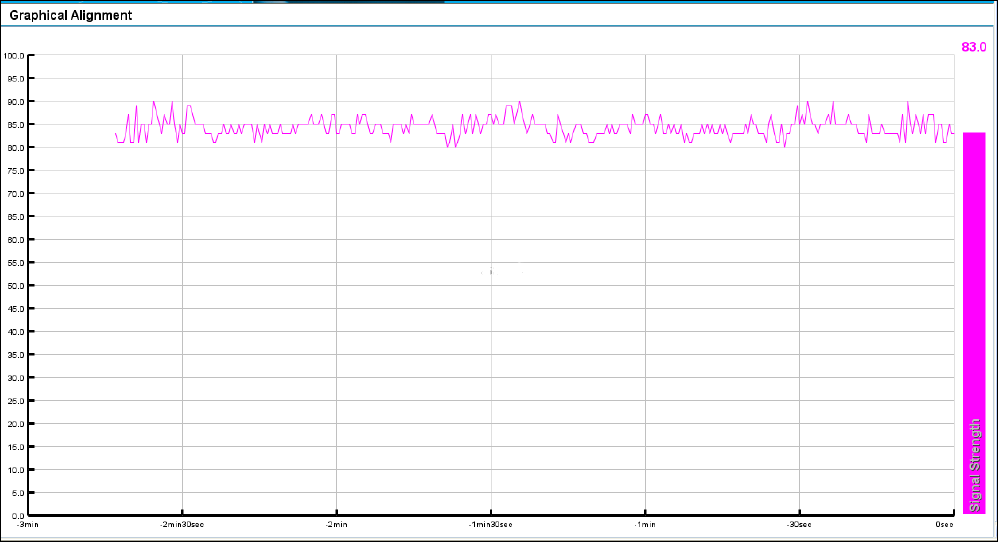
PTP 250 User Guide Aligning antennas
phn- 2182_002v000
May 2011 6-29
Gra phical a lignm ent
This is the second method that may be used to monitor receive signal level during
antenna alignment.
Select menu option Installation Wizard, Graphical Alignment. The Graphical
Alignment page is displayed (Figure 6-21).
Figure 6 - 2 1 Graphical Alignm ent page
The Graphical Alignment page displays the receive power over the last three minutes.
This allows the installer to slowly sweep the antenna during installation and monitor
the variation in signal strength with angular position. The page automatically
refreshes every three seconds.
The page displays the instantaneous signal strength at the top right.
Aligning antennas Chapter 6 Configurat ion and alignm ent
phn- 2 182_002v 000
6-30 May 2011
Disarm ing t he unit s
When antenna alignment is complete, both units in the link must be disarmed before
network connection.
To disarm the units, select menu option Installation Wizard. The Step 5: Confirm
Configuration page is displayed (Figure 6-14). Select Set Disarmed, Yes to confirm
and then Back until the Step 1: LAN Configuration page is displayed.

PTP 250 User Guide Connect ing link t o t he network
phn- 2182_002v000
May 2011 6-31
Conne ct ing link t o t he ne t w ork
When antenna alignment is complete, the link performance must be checked and then
the link connected to the network for operational running.
This task consists of the following procedures:
• Reviewing system configuration attributes on page 6-31
• Comparing actual to predicted performance on page 6-34
• Connecting to the network on page 6-35
Revie w ing syst e m configurat ion at t r ibut es
Review the system configuration to check that it is correct for operational running. To
do this, select the following menu options:
• Configuration (Figure 6-22).
• Configuration, LAN Configuration (Figure 6-23).
• Configuration, Date/Time (Figure 6-24).
If any settings are incorrect, return to the installation wizard and update the
configuration as described in Using the installation wizard on page 6-14.
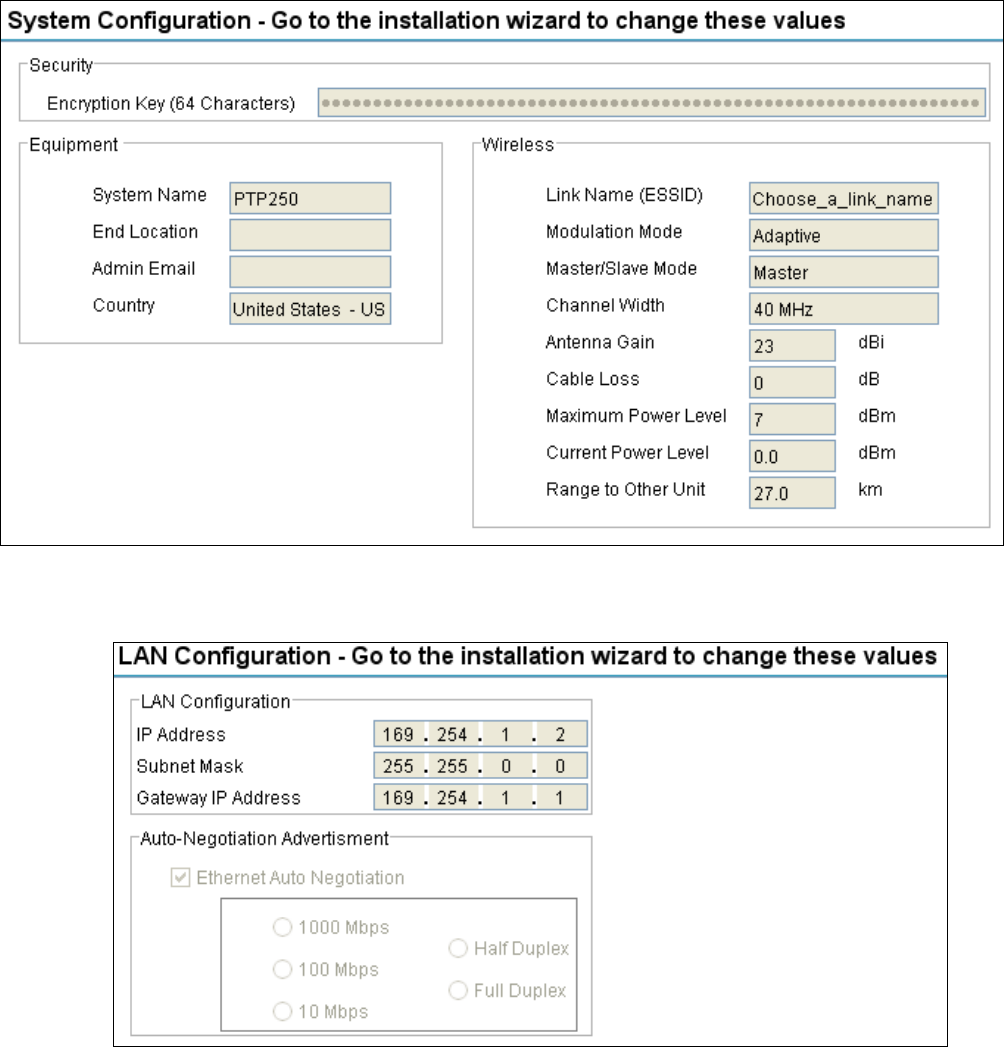
Connect ing link t o t he network Chapt er 6 Configurat ion and alignm ent
phn- 2 182_002v 000
6-32 May 2011
Figure 6 - 2 2 Syst em Configuration page
Figure 6 - 2 3 LAN Configuration page
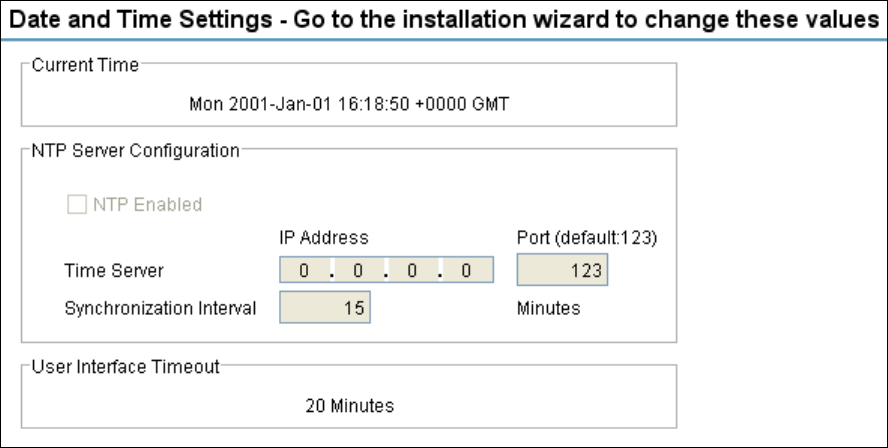
PTP 250 User Guide Connect ing link t o t he network
phn- 2182_002v000
May 2011 6-33
Figure 6 - 2 4 Date and Tim e Sett ings page
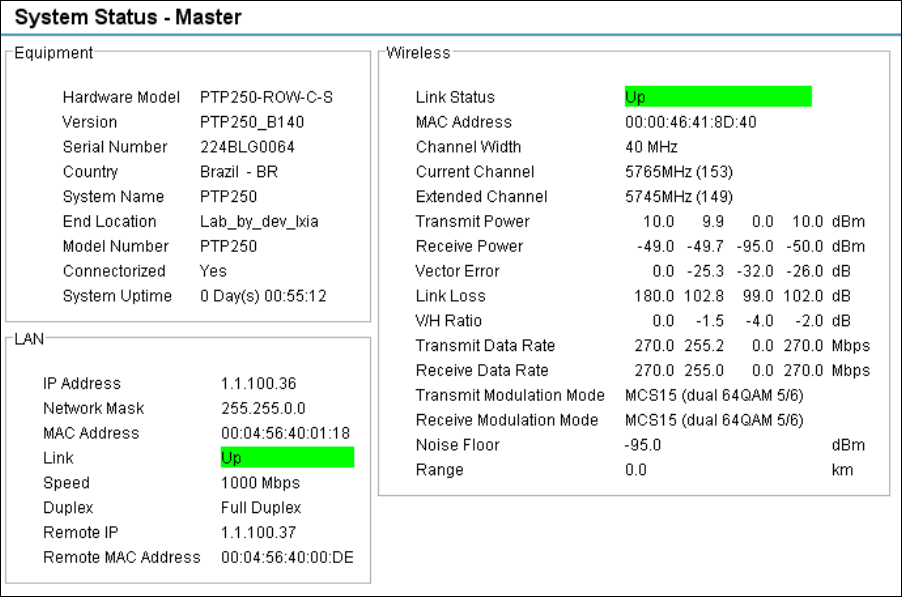
Connect ing link t o t he network Chapt er 6 Configurat ion and alignm ent
phn- 2 182_002v 000
6-34 May 2011
Com paring a ct ual t o predict e d perform a nce
For at least one hour of operation after disarming, monitor the link to check that it is
achieving predicted levels of performance.
To check performance, select menu option Status. The System Status page is
displayed (Figure 6-25). Monitor the following attributes:
• Link Loss
• Transmit Data Rate
• Receive Data Rate
For more information on these attributes, refer to Viewing the system status on page
7-8.
PTP LINKPlanner provides the prediction in the form of an installation report.
Figure 6 - 2 5 Syst em St at us page

PTP 250 User Guide Connect ing link t o t he network
phn- 2182_002v000
May 2011 6-35
Conne ct ing t o t he net w or k
To connect to the network, proceed as follows:
1 Disconnect the local PC from the PoE power supply at the Master and Slave
sites.
2 At each site, connect the PoE power supply DATA IN ports to a router port,
switch port or other network equipment in the data network (Figure 6-3)
using the CAT5e cable that was prepared for this purpose in Preparing the
PoE power supply to network equipment cable on page 5-30.
3 Check that the Master and Slave units are reachable from the network
management system by opening the web interface to the management
agents, or by requesting ICMP echo response packets using the Ping
application. The network management system will normally be
geographically remote from the sites, so it may be necessary to request that
this action is completed by co-workers at the management center.
4 Check the data network for correct operation across the wireless link. This
may be by requesting ICMP echo response packets between hosts in the
connected network segments, or by some more structured use of network
testing tools.
5 Select menu option Home or Status and check that the Wireless Link Status
is ‘Up’ on both units. If it is not ‘Up’, refer to Managing link status and alerts
on page 7-15.
Connect ing link t o t he network Chapt er 6 Configurat ion and alignm ent
phn- 2 182_002v 000
6-36 May 2011

Cha pt e r 7
phn- 2182_002v000
May 2011 7-1
Chapt er 7 Operat ion
. . . . . . . . . . . . . . . . . . . . . . . . . . . . . . . . . . . . . . . . . . . . . . . . . . . . . . . . . . . .
.
.
.
.
This chapter provides instructions for operators of the PTP 250 web user interface.
The following topics are described in this chapter:
• Web-based management on page 7-2 describes the layout and the main menu
options of the PTP 250 web-based management interface.
• Managing link status and alerts on page 7-15 describes how to manage PTP 250
link status and alerts.
• Managing performance on page 7-17 describes how to manage the performance
of the PTP 250 link.
• Restoring, resetting and rebooting on page 7-24 describes how to restore the
system configuration, reset to defaults, recover the IP address and reboot the
unit.

Web- based m anagem ent Chapt er 7 Operat ion
phn- 2 182_002v 000
7-2 May 2011
W e b- ba sed m a na gem ent
This section describes the layout and the main menu options of the PTP 250 web-based
management interface. The following topics are covered:
• Accessing the web interface on page 7-2
• Using the menu options on page 7-4
• Viewing the system summary on page 7-6
• Viewing the system status on page 7-8
• Changing password on page 7-14
• Logging out on page 7-14
Accessing t he w e b int er fa ce
The web interface is best viewed using a screen resolution of at least 1024 x 768
pixels. The web pages have been tested with: Internet Explorer 7, Internet Explorer 8,
Firefox 3 and Firefox 3.5 on PCs; and Safari on Mac OS X. Other browsers have not
been tested.
To access the web interface, type the IP address of the unit into the browser address
bar and press ENTER. When the login page is displayed (Figure 7-1), enter Username
‘admin’ and Password (factory default is ‘motorola’, but this must be changed at first
login) and select Login. The Menu and System Summary are displayed (Figure 7-2).
Figure 7 - 1 Login page
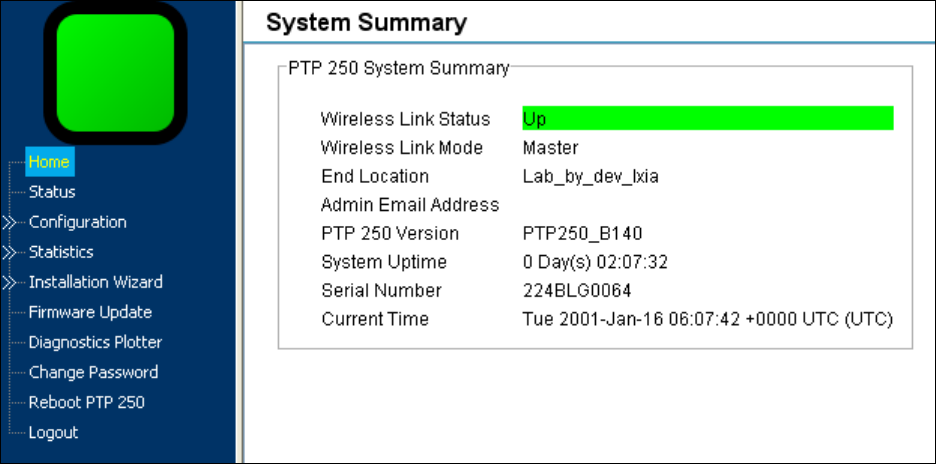
PTP 250 User Guide Web- based m anagem ent
phn- 2182_002v000
May 2011 7-3
Figure 7 - 2 Menu and Syst em Sum m ary page ( wireless link up)
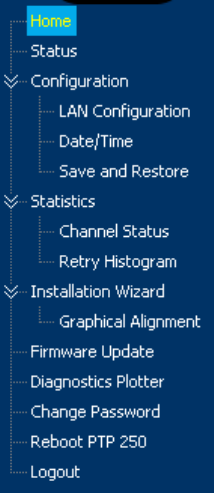
Web- based m anagem ent Chapt er 7 Operat ion
phn- 2 182_002v 000
7-4 May 2011
Using t he m e nu opt ions
All web pages contain the menu navigation bar on the left hand side (Figure 7-3). The
menu is used to navigate to other web pages. The currently selected option is always
highlighted with a light blue background.
Figure 7 - 3 Menu navigat ion bar
Table 7-1 lists the procedures that may be performed from each menu option. Many of
these procedures are part of the initial configuration and alignment process described
in Chapter 6 Configuration and alignment.

PTP 250 User Guide Web- based m anagem ent
phn- 2182_002v000
May 2011 7-5
Table 7 - 1 Procedures perform ed from each m enu option
Me nu opt ion Procedures
Home Viewing the system summary on page 7-6
Managing link status and alerts on page 7-15
Checking that the units are armed on page 6-25
Status Viewing the system status on page 7-8
Checking the installed firmware version on page 6-10
Configuration Reviewing system configuration attributes on page 6-31
LAN Configuration Reviewing system configuration attributes on page 6-31
Recovering a lost IP address on page 7-28
Date/Time Reviewing system configuration attributes on page 6-31
Save and Restore Saving the system configuration on page 6-11
Saving and restoring the configuration file on page 7-24
Resetting to default configuration (without country reset)
on page 7-25
Statistics Checking system statistics on page 7-17
Comparing actual to predicted performance on page 6-34
Test Ethernet packet errors reported by ODU on page 8-8
Channel Status Checking channel status on page 7-19
Retry Histogram Checking the retry histogram on page 7-20
Installation Wizard Using the installation wizard on page 6-14
Graphical Alignment Graphical alignment on page 6-29
Firmware Update Uploading a new firmware version on page 6-12
Diagnostics Plotter Using the diagnostics plotter on page 7-21
Change Password Changing password on page 7-14
Reboot PTP 250 Rebooting the unit on page 7-28
Logout Logging out on page 7-14
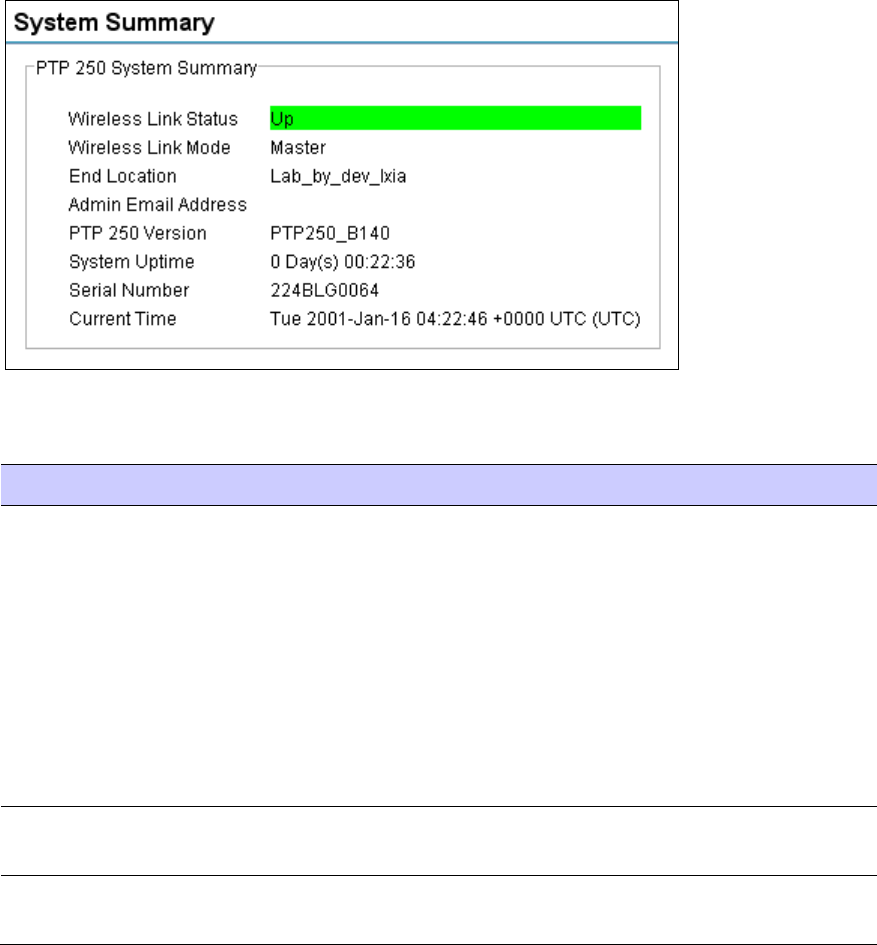
Web- based m anagem ent Chapt er 7 Operat ion
phn- 2 182_002v 000
7-6 May 2011
View ing t he syst e m sum m a ry
To display the System Summary page, select menu option Home.
The System Summary page (Figure 7-4) contains a high level summary of the status of
the wireless link and associated equipment.
Figure 7 - 4 Syst em Sum m ary page
The attributes of the System Summary page are described in Table 7-2.
Table 7 - 2 Syst em Sum m ary at t ributes
Att r ibute Me aning
Wireless Link
Status
Current status of the wireless link.
A green background with status text ‘Up’ means that the
point-to-point link is established.
A yellow background with suitable status text (for example
‘Acquiring’) indicates that the link is not established.
Whenever the Wireless Link Status is not ‘Up’, a yellow
warning triangle is displayed on the navigation bar. For more
information, refer to Managing link status and alerts on page
7-15.
Wireless Link
Mode
Master or Slave. This is set in the Installation Wizard; see
Step 2: Wireless configuration on page 6-17.
End Location Location of this link end. This is set in the Installation Wizard;
see Step 2: Wireless configuration on page 6-17.

PTP 250 User Guide Web- based m anagem ent
phn- 2182_002v000
May 2011 7-7
Att r ibute Me aning
Admin Email
Address
The email address configured for email alerts. This is set in
the Installation Wizard; see Step 4: Email configuration on
page 6-22.
PTP 250 Version The currently running firmware version.
System Uptime The time (days and hh:mm:ss) that has elapsed since the last
system reboot.
The system can reboot for several reasons, for example,
commanded reboot from the Reboot PTP 250 webpage, or a
power cycle of the equipment.
Serial Number Serial number of this unit.
Current Time The system clock presented as local time, allowing for zone
and daylight saving. This is set in the Installation Wizard; see
Step 3: Date and time settings on page 6-20.
Status attributes Status attributes may be displayed in the System Summary
page to indicate abnormal states.
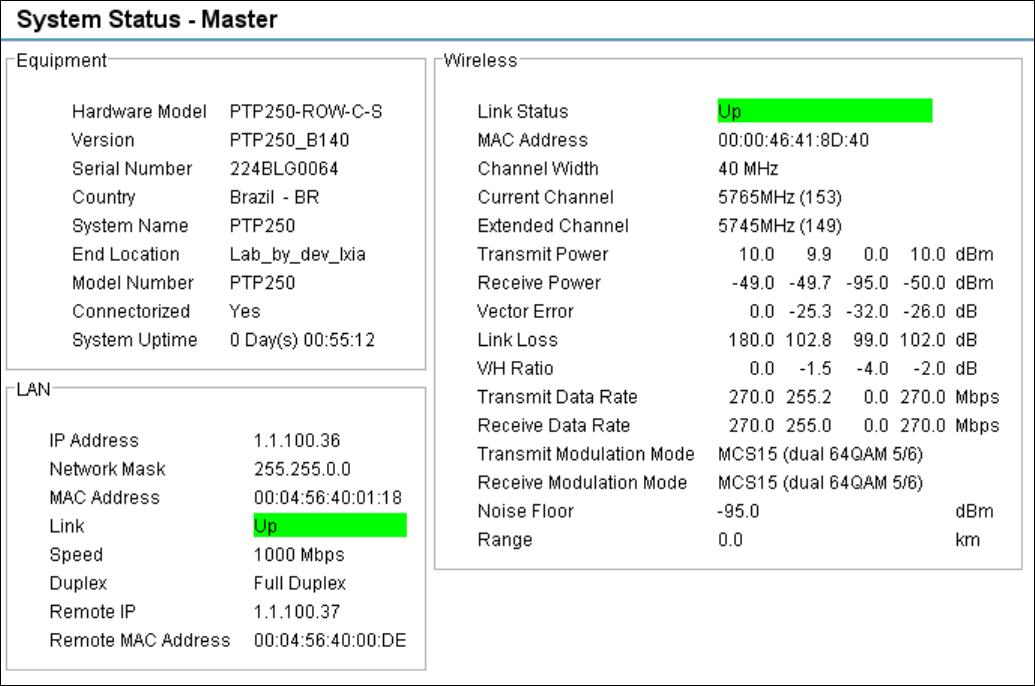
Web- based m anagem ent Chapt er 7 Operat ion
phn- 2 182_002v 000
7-8 May 2011
View ing t he syst e m sta t us
To display the System Status page, select menu option Status.
The System Status page (Figure 7-5) gives the user a detailed view of the operation of
the system from both the wireless and network perspectives.
Figure 7 - 5 Syst em St atus page
The page is subdivided into three sections:
• Equipment: This contains the unit’s inventory and identification information.
• LAN: This describes the unit’s network identity and connectivity.
• Wireless: This presents the key wireless metrics, which are displayed as a series
of measurements.

PTP 250 User Guide Web- based m anagem ent
phn- 2182_002v000
May 2011 7-9
The two ODUs are arranged in a master and slave relationship. The roles of the units
in this relationship are displayed in the page title. The master unit will always have the
title ‘- Master’, and the slave will always have ‘- Slave’ appended to the ‘Systems
Status’ page title.
The status page attributes are defined in Table 7-3, Table 7-4 and Table 7-5.
Table 7 - 3 Syst em St atus Equipm ent at t ribut es
Att r ibute Me aning
Hardware Model Hardware model of this unit.
Version The version of firmware installed. The format of the
attributes is
250-xx-yy
where:
xx
is system release,
yy
minor system release.
Serial Number Serial number of this unit.
Country The country in which this unit is configured to operate. This
is set at first login, as described in Logging into the web
interface on page 6-6. This can only be reset by restoring the
unit to factory default configuration, as described in
Resetting to default configuration (with country reset) on
page 7-26.
System Name Name of this PTP 250 system. This is set in the Installation
Wizard; see Step 2: Wireless configuration on page 6-17.
End Location Location of this link end. This is set in the Installation Wizard;
see Step 2: Wireless configuration on page 6-17.
Model Number Model number of this unit.
Connectorized ‘Yes’ means that the unit is connectorized.
‘No’ means that the unit is integrated.
System Uptime The time (days and hh:mm:ss) that has elapsed since the last
system reboot.
The system can reboot for several reasons, for example,
commanded reboot from the Reboot PTP 250 webpage, or a
power cycle of the equipment.

Web- based m anagem ent Chapt er 7 Operat ion
phn- 2 182_002v 000
7-10 May 2011
Table 7 - 4 Syst em St at us LAN att ribut es
Att r ibute Me aning
IP Address Internet protocol (IP) address. The factory default is
169.254.1.1, but it may be reset in the Installation Wizard; see
Step 1: LAN configuration on page 6-15.
Network Mask Defines the address range of the connected IP network. The
factory default is 255.255.0.0, but it may be reset in the
Installation Wizard; see Step 1: LAN configuration on page 6-
15.
MAC Address MAC address of the Ethernet LAN port of this unit. This is not
user-configurable.
Link The current status of the Ethernet link. A state of ‘Up’ with a
green background indicates that an Ethernet link is
established. Any status on a yellow background indicates that
the Ethernet link is not established.
Speed The negotiated speed (Mbps) of the Ethernet interface.
Duplex Indicates whether the unit is transmitting data in full duplex
or half duplex mode. Full duplex is expected in normal
operation.

PTP 250 User Guide Web- based m anagem ent
phn- 2182_002v000
May 2011 7-11
Table 7 - 5 Syst em St at us Wireless at t ributes
Att r ibute Me aning
Link Status Current status of the wireless link. A state of ‘Up’ on a green
background indicates that a point-to-point link is established.
Any status on a yellow background indicates that the wireless
link is not established.
Whenever the Link Status is not ‘Up’, a yellow warning
triangle is displayed on the navigation bar. For more
information, refer to Managing link status and alerts on page
7-15.
MAC Address MAC address of the radio interface of this unit.
Channel Width Width of the wireless channel, either 20 MHz or 40 MHz. This
is set in the Installation Wizard; see Step 2: Wireless
configuration on page 6-17.
Current Channel The channel (MHz) in which this link operates. This is set in
the Installation Wizard; see Step 2: Wireless configuration on
page 6-17.
Extended Channel The extended channel (MHz). This only applies when Channel
Width is 40 MHz.
Transmit Power The maximum, mean, minimum and latest measurements of
Transmit Power (dBm). See Diagnostics calculated over time
on page 7-23.
Receive Power The maximum, mean, minimum and latest measurements of
Receive Power (dBm). See Diagnostics calculated over time
on page 7-23.
Vector Error The maximum, mean, minimum and latest measurements of
Vector Error (dB). See Diagnostics calculated over time on
page 7-23.
The vector error measurement compares the In-phase /
Quadrature (IQ) modulation characteristics to an ideal signal
to determine the composite error vector magnitude.
Vector Error is expected to range from -2 dB (NLOS link
operating at sensitivity limit on BPSK 0.50) to –27 dB (short
LOS link running 64QAM 0.83). These are approximate
values.

Web- based m anagem ent Chapt er 7 Operat ion
phn- 2 182_002v 000
7-12 May 2011
Att r ibute Me aning
Link Loss The maximum, mean, minimum and latest measurements of
Link Loss (dB). See Diagnostics calculated over time on page
7-23.
The link loss is the total attenuation of the wireless signal
between the two point-to-point units. The link loss calculation
presented below:
xxxx RTRTll ggPPP
+
+
−
=
Where:
ll
P = Link Loss (dB)
x
T
P = Transmit power of the remote wireless unit (dBm)
x
R
P = Received signal power at the local unit (dBm)
xx RT gg , = Antenna gain at the remote and local units
respectively (dBi). The antenna gain of the ODU (23.5
dBi) is used unless one or both of the units is a
Connectorized version.
For connectorized ODUs, the link loss calculation is modified
to allow for the increased antenna gains at each end of the
link.

PTP 250 User Guide Web- based m anagem ent
phn- 2182_002v000
May 2011 7-13
Att r ibute Me aning
V/H Ratio The maximum, mean, minimum and latest measurements of
V/H Ratio. See Diagnostics calculated over time on page 7-23.
This is calculated from:
Power received by the vertical antenna input (dB) ÷
Power received by the horizontal antenna input (dB)
V/H Ratio is an aid to debugging a link. If it has a large
positive or negative value, then investigate the following
potential problems:
An antenna coaxial lead may be disconnected.
When spatial diversity is employed, the antenna with the
lower value may be pointing in the wrong direction.
When a dual polar antenna is deployed, the antenna may
be directed using a side lobe rather than the main lobe.
When there is a reflection from water on the link and spatial
diversity is employed, then one expects large, slow swings in
V/H Ratio. This indicates the antenna system is doing exactly
as intended.
Transmit Data
Rate
The maximum, mean, minimum and latest measurements of
Transmit Data Rate (Mbps). See Diagnostics calculated over
time on page 7-23.
Receive Data Rate The maximum, mean, minimum and latest measurements of
Receive Data Rate (Mbps). See Diagnostics calculated over
time on page 7-23.
Transmit
Modulation Mode
The modulation mode currently being used on the transmit
channel.
Receive
Modulation Mode
The modulation mode currently being used on the receive
channel.
Noise Floor The noise floor reported by the radio in this unit (dBm).
Range The distance (km) between the two ODUs.

Web- based m anagem ent Chapt er 7 Operat ion
phn- 2 182_002v 000
7-14 May 2011
Cha nging pa ssw ord
To change the admin password, select menu option Change Password. The Change
Password page is displayed (Figure 7-6). Enter and confirm the new password.
Figure 7 - 6 Change Password page
Logging out
To maintain security, always log out at the end of a session by selecting menu option
Logout.
Alternatively, the unit will log out automatically, but this depends upon the setting of
User Interface Timeout; see Step 3: Date and time settings on page 6-20.
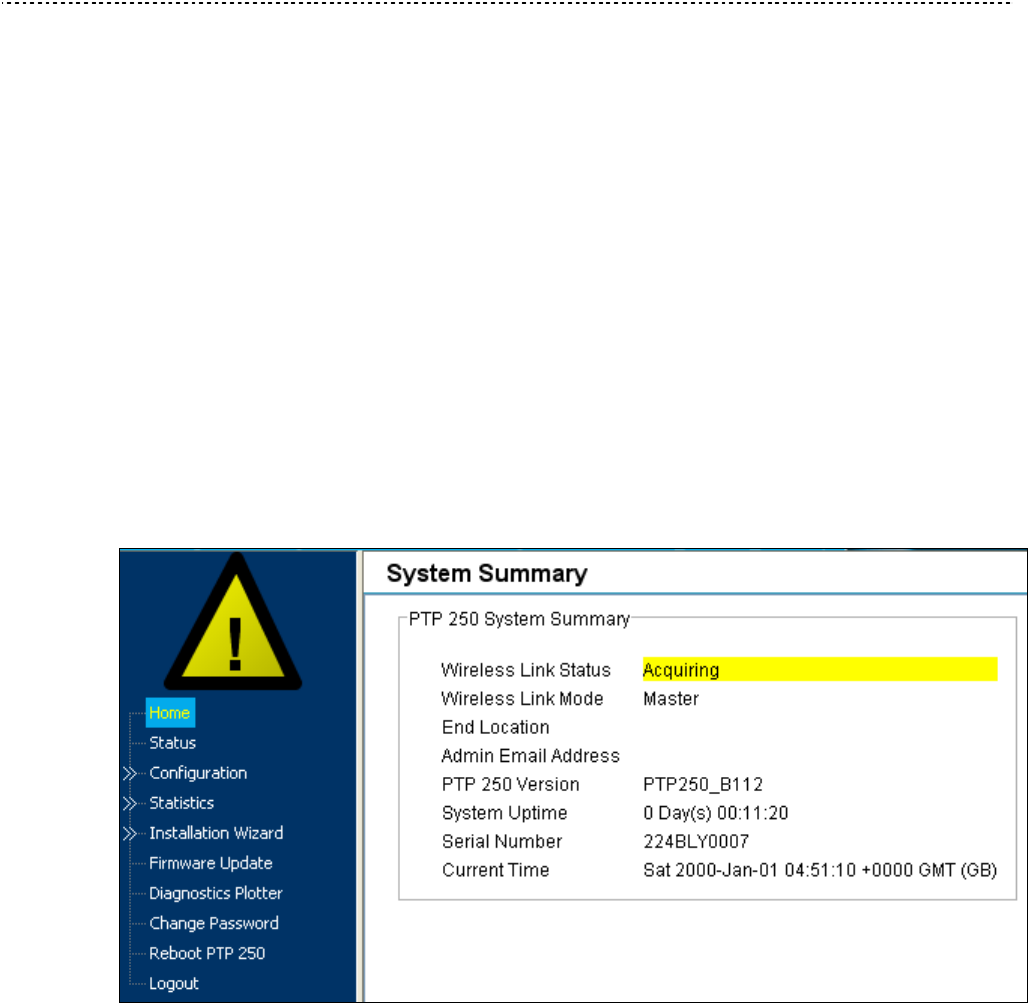
PTP 250 User Guide Managing link st atus and aler t s
phn- 2182_002v000
May 2011 7-15
Mana ging link st at us a nd aler t s
This section describes how to manage PTP 250 link status and alerts.
This section contains the following procedures:
• Managing link status on page 7-15.
• Managing email alerts on page 7-16.
Managing link sta t us
Whenever the Wireless Link Status is not ‘Up’, a yellow warning triangle is displayed
on the navigation bar (Figure 7-7). The warning triangle is visible from all web pages.
Click the warning triangle (or menu option Home) to return to the System Summary
page and view the Wireless Link Status. If the warning triangle is replaced by a green
square, it indicates that the Wireless Link Status is ‘Up’ (Figure 7-2).
The Wireless Link Status values are defined in Table 7-6.
Figure 7 - 7 St atus warning t riangle

Managing link st atus and aler t s Chapt er 7 Operat ion
phn- 2 182_002v 000
7-16 May 2011
Table 7 - 6 Wireless Link Stat us att ribut e values
Value M ea ning
Up The wireless link is up and running.
Registering The wireless link is up, but not yet running (still handshaking,
setting security and so on).
Acquiring The Master unit is waiting for a slave. Only displayed at a
Master unit.
Searching At a Master unit: searching for a quality channel.
At a Slave unit: searching for a Master.
Radar CAC Radar Channel Availability Check (CAC) in progress.
Initializing The unit is starting up or resetting (for example, for a
configuration change or because radar has been detected).
No Channels Radar CAC has determined that there are no useable
channels.
Managing e m a il alert s
The management agent can be configured to generate alerts by electronic mail when
certain events occur. The email message configuration procedure is described in Step
4: Email configuration on page 6-22. The alerts are defined in Table 7-7.
Table 7 - 7 Email alert s
Alert Me aning
Cold Start The unit has rebooted.
Link Down The link is down.
Link Up The link is up.
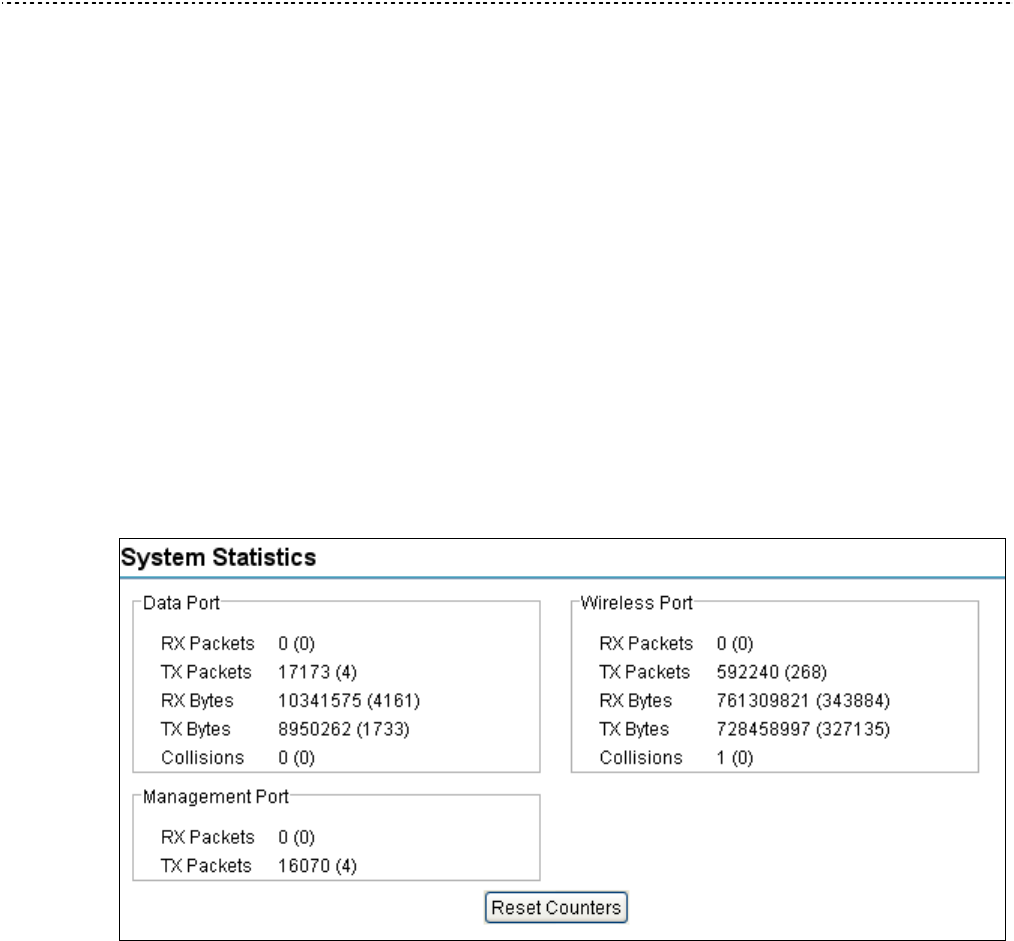
PTP 250 User Guide Managing perform ance
phn- 2182_002v000
May 2011 7-17
Mana ging perform ance
This section describes how to manage the performance of the PTP 250 link.
This section contains the following procedures:
• Checking system statistics on page 7-17
• Checking channel status on page 7-19
• Checking the retry histogram on page 7-20
• Using the diagnostics plotter on page 7-21
• Diagnostics calculated over time on page 7-23
Che cking syst e m sta t ist ics
To check system statistics, select menu option Statistics. The System Statistic page is
displayed (Figure 7-8).
Figure 7 - 8 Syst em Statist ics page

Managing per form ance Chapt er 7 Operat ion
phn- 2 182_002v 000
7-18 May 2011
The System Statistics page contains the following system counters:
• Data port counters (Table 7-8)
• Management port counters (Table 7-9)
• Wireless port counters (Table 7-10)
The packet counter attributes each contain a number in parentheses; this shows the
number of packets received since the last page refresh. The page automatically
refreshes every two seconds.
To reset all system counters to zero, select Reset Counters.
Table 7 - 8 Dat a Port Count er att ributes in t he Syst em Stat ist ics page
Att r ibute Me aning
Rx Packets The number of good and bad packets received from the local
Ethernet interface.
Tx Packets The number of good packets the bridge has sent for
transmission by the local Ethernet interface.
Rx Bytes The number of bytes received by the Ethernet interface.
Tx Bytes The number of bytes transmitted by the Ethernet interface.
Collisions The number of frames experiencing collisions in the local
Ethernet interface.
Table 7 - 9 Managem ent Port Count er att ribut es in t he System St atist ics page
Att r ibute Me aning
Rx Packets The total number of good packets the bridge has received
from the internal stack (for example ARP responses, PING
replies, HTTP responses).
Tx Packets The total number of good packets the bridge has transmitted
to the internal stack (for example, ARP requests, PING
requests, HTTP requests).
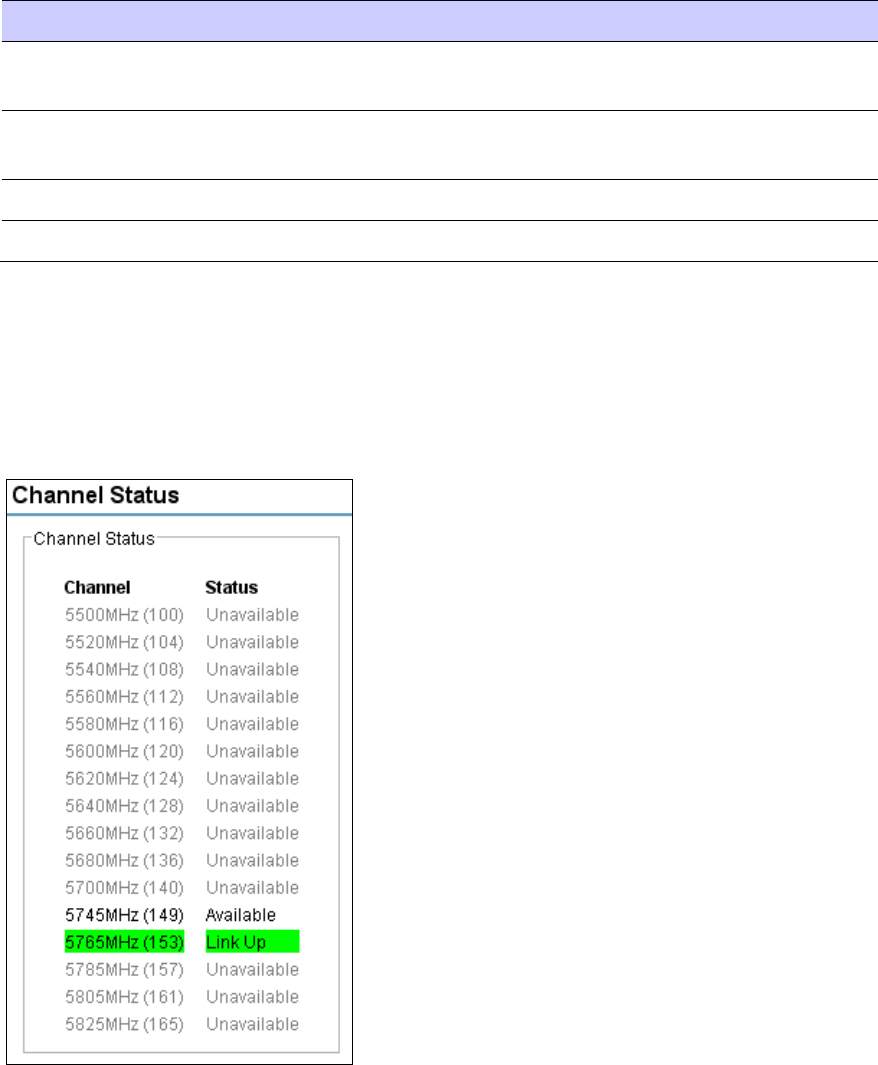
PTP 250 User Guide Managing perform ance
phn- 2182_002v000
May 2011 7-19
Table 7 - 1 0 Wireless Port Counter att ributes in t he System St atist ics page
Att r ibute Me aning
Rx Packets The number of good packets the bridge has received from the
wireless interface.
Tx Packets The number of good packets the bridge has sent for
transmission by the wireless interface.
Rx Bytes The number of bytes received from the wireless interface.
Tx Bytes The number of bytes transmitted by the wireless interface.
Che cking cha nnel st at us
To check channel status, select menu option Statistics, Channel Status. The Channel
Status page is displayed (Figure 7-9).
Figure 7 - 9 Channel St atus page
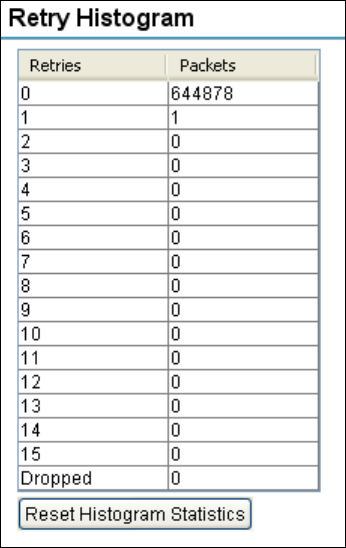
Managing per form ance Chapt er 7 Operat ion
phn- 2 182_002v 000
7-20 May 2011
Che cking t he ret ry hist ogram
The retry histogram gives an indication of wireless quality. It records how many
frames have been re-transmitted how many times. Valid values can vary; a short range
LOS link should run with very few retries. A longer range nLOS link may run with up
to 10% retries.
To check the retry histogram, select menu option Statistics, Retry Histogram. The
Retry Histogram page is displayed (Figure 7-10).
Figure 7 - 1 0 Ret ry Hist ogram page
To reset all retry statistics, select Reset Histogram Statistics.
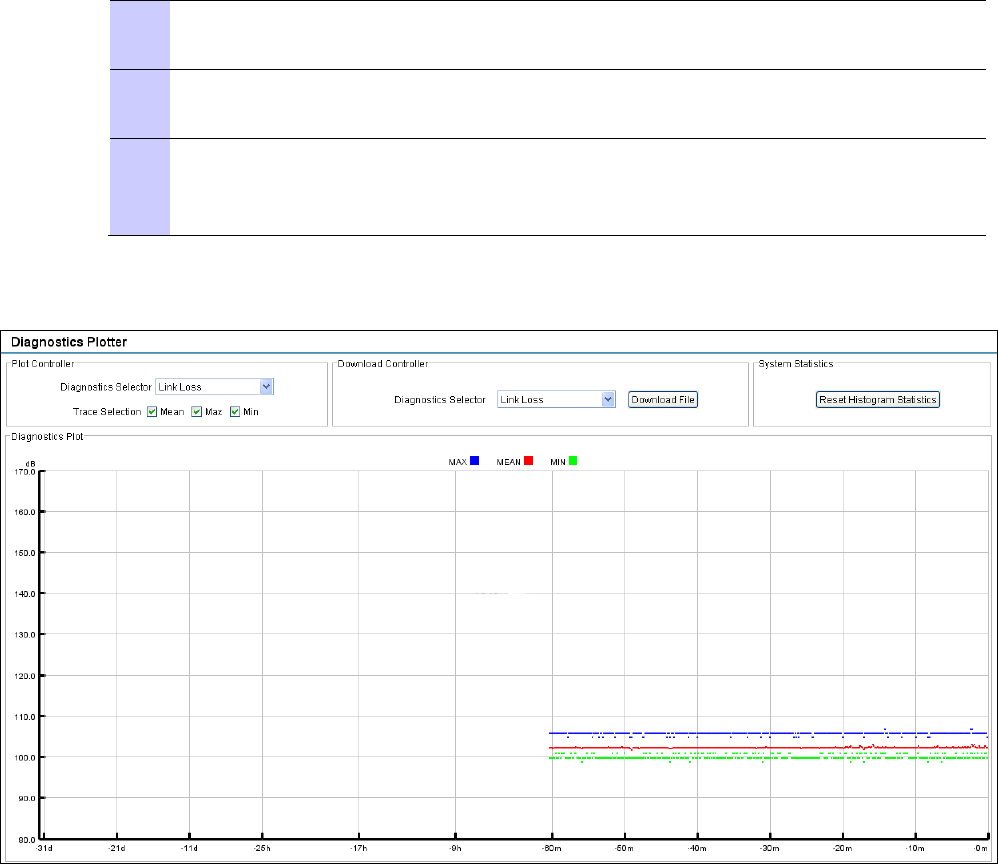
PTP 250 User Guide Managing perform ance
phn- 2182_002v000
May 2011 7-21
Using t he dia gnost ics plot t er
The Diagnostics Plotter page is used to plot key performance statistics against time.
To plot diagnostics, proceed as follows:
1 Select menu option D iagnostics Plotter. The Diagnostics Plotter page is
displayed (Figure 7-11).
2 Use the Diagnostics Selector drop-down list to select a diagnostic type to
plot.
3 Use the Trace Selection to select traces of the maximum, mean or minimum
values of the diagnostic type. Maximum values are displayed in blue, mean
values are displayed in red and minimum values are displayed in green.
Figure 7 - 1 1 Diagnost ic Plott er page

Managing per form ance Chapt er 7 Operat ion
phn- 2 182_002v 000
7-22 May 2011
Table 7 - 1 1 Diagnost ics Plott er at t ribut es
Att r ibute Mea ning
Link Loss Defined in Table 7-5.
Transmit Power Defined in Table 7-5.
Receive Power Defined in Table 7-5.
Receive Vector Error Defined in Table 7-5.
Transmit Data Rate Defined in Table 7-5.
Receive Data Rate Defined in Table 7-5.
Aggregated Data Rate The sum of the transmit and receive data rates (Mbps).
V/H Ratio Defined in Table 7-5.
The maximum, mean, minimum and latest values of some of these statistics are also
displayed on the System Status page. See Diagnostics calculated over time on page 7-
23.
Dow nloa ding dia gnostic da t a
To download a statistic to a CSV file, use the Download Controller. Select the statistic
from the list and select Download File.
The CSV file contains at most 5784 entries, recorded over a 32 day period:
• 3600 entries recorded in the last hour.
• 1440 entries recorded in the previous 24 hours.
• 744 entries recorded in the previous 31 days.
Reset t ing st a t istics
To reset all the statistics that are available in the Diagnostics Plotter page, select
Reset Histogram Statistics.
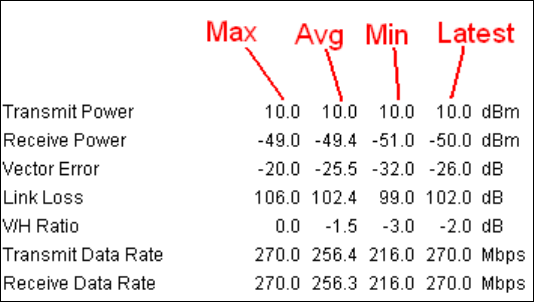
PTP 250 User Guide Managing perform ance
phn- 2182_002v000
May 2011 7-23
Dia gnost ics calcula t ed over t im e
The System Status page (Figure 7-5) contains seven diagnostic attributes that are
calculated over time and presented as arrays of four elements (Figure 7-12).
Figure 7 - 1 2 Diagnost ic att ribut es calculat ed over tim e
These attributes are defined in Table 7-5.
The element arrays represent the following:
• Max: The maximum value measured over the last hour.
• Avg: The mean of a set of values recorded at one second intervals over the last
hour.
• Min: The minimum value measured the last hour.
• Latest: The latest value measured.
If the link has been running for less than one hour, then the values are calculated over
the time that has elapsed since the link was established.
These attributes can be plotted against time, downloaded and reset by using the
Diagnostics Plotter page, as described in Using the diagnostics plotter on page 7-21.

Restor ing, reset t ing and rebooting Chapt er 7 Oper at ion
phn- 2 182_002v 000
7-24 May 2011
Restoring, re set t ing a nd re boot ing
This section describes how to restore the system configuration, reset to defaults,
recover the IP address and reboot the unit.
This section contains the following procedures:
• Saving and restoring the configuration file on page 7-24
• Resetting to default configuration (without country reset) on page 7-25
• Resetting to default configuration (with country reset) on page 7-26
• Recovering a lost IP address on page 7-28
• Rebooting the unit on page 7-28
Saving a nd restoring t he configurat ion file
Save the configuration (by following the procedure in Saving the system configuration
on page 6-11) in the following situations:
• Before and after upgrading the firmware version.
• Before replacing a faulty unit in the field.
• After the unit has been configured or reconfigured.
The restore is only guaranteed to work if the installed firmware version has not been
changed since the configuration file was saved.
To restore the configuration file, proceed as follows:
1 Select menu option Configuration, Save And Restore. The Save & Restore
Configuration page is displayed (Figure 6-11).
2 Select Browse and navigate to the PC folder containing the saved
configuration file (.cfg). Select Open.
4 Select OK to confirm the restore. The configuration file is uploaded and used
to reconfigure the unit to its previous state.
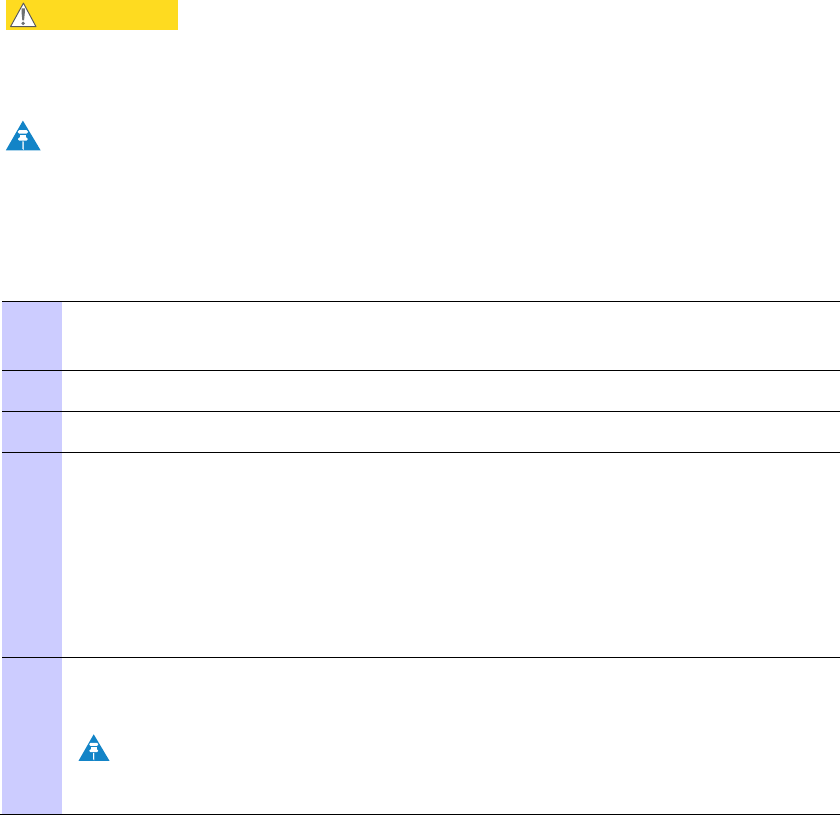
PTP 250 User Guide Restor ing, reset t ing and rebooting
phn- 2182_002v000
May 2011 7-25
Reset t ing t o default configur a t ion ( w it hout count ry r e set )
Use the Save & Restore page to reset the unit to factory default configuration, without
resetting the country of operation (selected at first login).
CAUTION
When the unit is reset to default configuration, the current configuration is
lost and the unit reboots, causing loss of service.
NOTE
To reset the unit to factory default configuration, including reset of the
country that was selected at first login, follow the procedure in Resetting to
default configuration (with country reset) on page 7-26.
To reset to default configuration without country reset, proceed as follows:
1 Select menu option Configuration, Save And Restore. The Save &
Restore page is displayed (Figure 6-11).
2 Select Reset to Default Configuration and Yes to confirm.
3 Wait for at least 45 seconds.
4 The unit should now be reset to partial factory default settings, including
the following:
Password ‘motorola’,
IP address ‘169.254.1.1’,
Master Slave Status ‘Slave’.
The Country Code (selected at first login) remains unchanged.
5 To reconfigure the unit, follow the instructions in Connecting to the unit
on page 6-3 and Using the installation wizard on page 6-14.
NOTE
When logging into the unit, change Password (this will be prompted).

Restor ing, reset t ing and rebooting Chapt er 7 Oper at ion
phn- 2 182_002v 000
7-26 May 2011
Reset t ing t o default configur a t ion ( w it h count ry reset )
Use the reset plug (supplied in each PTP 250 ‘Link Complete’ or ‘End Complete’ kit) to
reset the unit to factory default configuration, including reset of the country of
operation (this will have to be reselected at first login after the reset).
CAUTION
When the unit is reset to default configuration, the current configuration is
lost and the unit reboots, causing loss of service.
NOTE
To reset the unit to factory defaults without resetting the country of
operation, follow the procedure in Resetting to default configuration
(without country reset) on page 7-25.
To reset to default configuration including country reset, proceed as follows:
1 Remove the ODU drop cable from the PoE power supply DATA & POWER
OUT port.
2 Plug the ODU drop cable into the reset plug and then plug the reset plug
into the PoE power supply DATA & POWER OUT port (Figure 7-13).
3 Wait for at least 45 seconds.
4 Disconnect the reset plug and re-insert the ODU drop cable into the PoE
power supply DATA & POWER OUT port.
5 The unit should now be reset to factory default settings, including the
following:
Password ‘motorola’,
IP address ‘169.254.1.1’,
Master Slave Status ‘Slave’,
Country Code is blank.
6 To reconfigure the unit, follow the instructions in Connecting to the unit
on page 6-3 and Using the installation wizard on page 6-14.
NOTE
When logging into the unit, change Password and select Country
Code (these will be prompted).
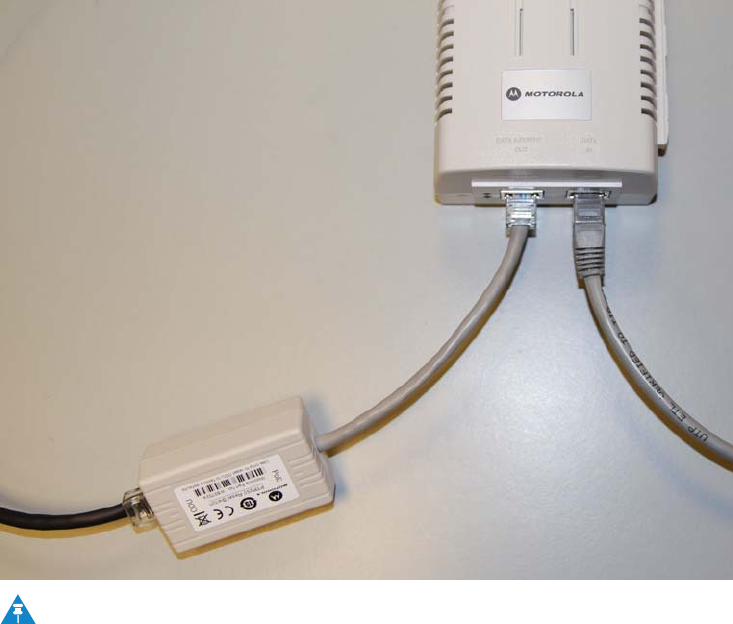
PTP 250 User Guide Restor ing, reset t ing and rebooting
phn- 2182_002v000
May 2011 7-27
Figure 7 - 1 3 Using t he reset plug
NOTE
If the power supply is a PIDU, the PIDU reset switch WILL NOT work. The
PTP 250 reset plug must be used.
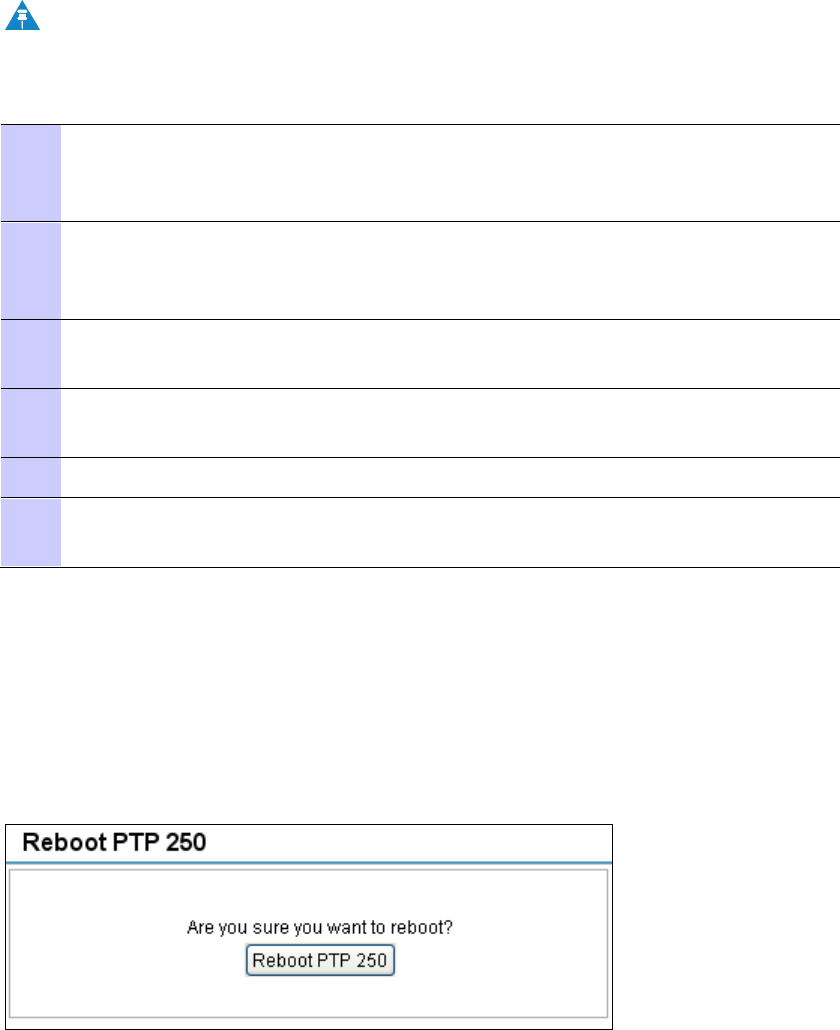
Restor ing, reset t ing and rebooting Chapt er 7 Oper at ion
phn- 2 182_002v 000
7-28 May 2011
Recovering a lost I P a ddress
To recover a lost IP address, physical access to the PoE power supply is recommended.
NOTE
The unit does still respond to its normal IP address through a power cycle.
If the IP address of the unit has been lost or forgotten, proceed as follows:
1 Set the management PC Ethernet port to an IP address that is valid for
the 169.254.X.X network, avoiding 169.254.0.0, 169.254.1.1 and
169.254.1.2. Refer to Configuring the management PC on page 6-3.
2 Connect the management PC Ethernet port to the DATA IN port of the
PoE power supply using a standard (not crossed) Cat5e cable (Figure
6-3).
3 Perform a power cycle, that is, disconnect and then reconnect the PoE
power supply to its AC supply.
4 Access the web interface within 30 seconds of powering on, using default
IP address 169.254.1.1.
5 Select menu option Configuration, LAN Configuration.
6 Obtain the correct IP address of the unit from the LAN Configuration
page.
Reboot ing t he unit
To reboot the ODU select menu option Reboot PTP 2 5 0 . The Reboot Wireless Unit
page is displayed (Figure 7-14). Select Re boot PTP 2 5 0 t o confirm .
Figure 7 - 1 4 Reboot Wireless Unit page

Cha pt e r 8
phn- 2182_002v000
May 2011 8-1
Chapt er 8 Troubleshoot ing
. . . . . . . . . . . . . . . . . . . . . . . . . . . . . . . . . . . . . . . . . . . . . . . . . . . . . . . . . . . .
.
.
.
.
This chapter contains procedures for identifying and correcting faults in a PTP 250
link. These procedures can be performed either on a newly installed link, or on an
operational link if communication is lost, or after a lightning strike.
The following topics are described in this chapter:
• Testing link end hardware on page 8-2 describes how to test the link end
hardware, either when it fails on startup, or after a lightning strike.
• Testing the radio link on page 8-12 describes how to test the link when there is
no radio communication, or when it is unreliable, or when the data throughput
rate is too low

Testing link end har dware Chapt er 8 Troubleshooting
phn- 2 182_002v 000
8-2 May 2011
Te st ing link end hardw are
This section describes how to test the link end hardware, either when it fails on
startup, or after a lightning strike.
Before testing link end hardware, confirm that all outdoor drop cables, that is those
that connect the ODU to equipment inside the building, are of the supported type, as
defined in Installation inventories on page 4-2.
NOTE
These tests apply to installations that use the PoE power supply. If the PIDU
is installed instead of the PoE power supply, the test procedures will be
different.
Testing w hen PoE LED s do not illum ina t e correctly
If the DATA & POWER OUT and DATA IN LEDs do not illuminate correctly during the
start-up sequence, test the link end as described in Test flowcharts on page 8-3 and
the detailed test procedures that follow.
Testing a ft e r a light ning st rik e
If the installation has been struck by lightning, proceed as follows:
1 Test the link end as described in Test flowcharts on page 8-3 and the
detailed test procedures that follow.
2 Ensure that the PoE power supply is working and that the resistances
are correct as specified in Test resistance at the PoE end of the drop
cable on page 8-10.
3 If the ODU is not working, power off the ODU and LPU and return them
to Motorola.
4 If the ODU is working but there is suspicion of damage to the LPU, then
refer to
LPU Operational Troubleshooting (phn-1362)
.
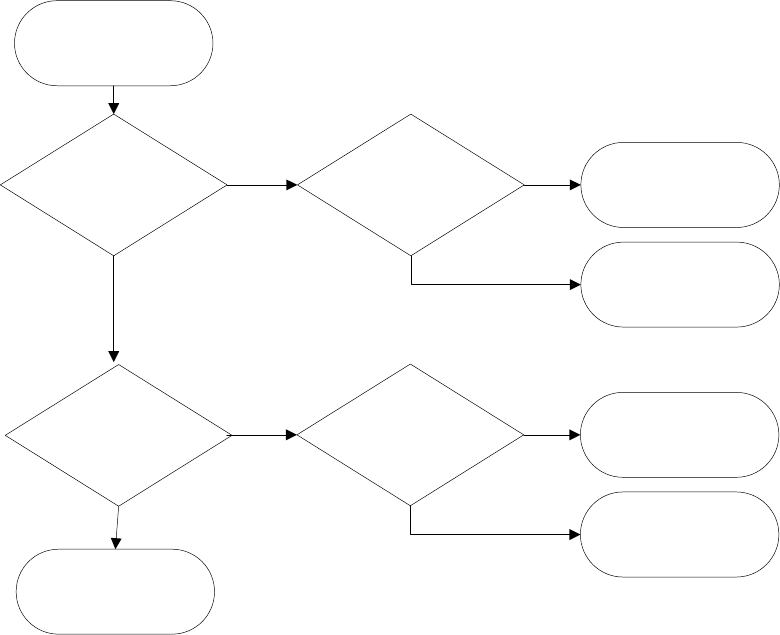
PTP 250 User Guide Testing link end har dware
phn- 2182_002v000
May 2011 8-3
Test flow chart s
Figure 8 - 1 Link end hardw are test flowchart # 1
No
Start
Is the PORT LED on
solidl?
Is the AC LED on solid?
Yes
Yes
Is the AC LED flashing?
Perform
“AC LED is off”
No
Perform
“AC LED is flashing”
Yes
Is the PORT LED
flashing?
Perform
“PORT LED is off”
No
Perform
“PORT LED is flashing”
Yes
No
Go to next flowchart
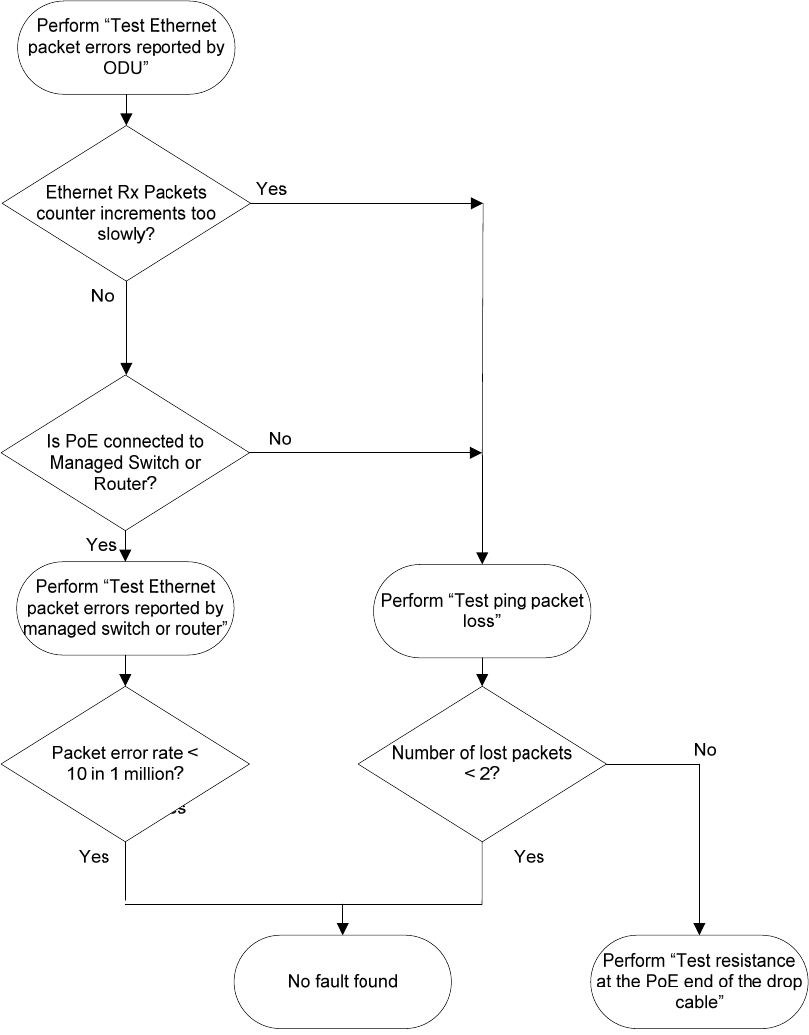
Testing link end har dware Chapt er 8 Troubleshooting
phn- 2 182_002v 000
8-4 May 2011
Figure 8 - 2 Link end hardw are test flowchart # 2

PTP 250 User Guide Testing link end har dware
phn- 2182_002v000
May 2011 8-5
AC LED is off
If the AC LED is not on solid or flashing, proceed as follows:
1 Remove the power lead from the PoE power supply.
2 Test that the mains power supply is working.
3 If the mains power supply is not working, investigate the cause.
4 If the mains power supply is working, report a suspected PoE power
supply fault to Motorola.
AC LED is fla shing
If the green AC LED is flashing, proceed as follows:
1 Test that the voltage from the AC outlet that is within the correct range
(100 – 240 V AC). If it is out of this range, investigate and correct the AC
supply. Otherwise, proceed to step 2.
2 Remove and examine the cable that connects the PoE power supply to
the LPU or ODU.
3 Check that the resistances are correct as specified in Test resistance at
the PoE end of the drop cable on page 8-10.
4 If either check fails, replace or repair the cable that connects the PoE
power supply to the LPU or ODU.

Testing link end har dware Chapt er 8 Troubleshooting
phn- 2 182_002v 000
8-6 May 2011
PORT LED is off
When the PoE power supply is connected to the power supply and the AC LED
illuminates, there should be a 45 second delay, following which the PORT LED should
illuminate (green steady).
If the PORT LED is off, proceed as follows:
1 Check that the RJ45 connection from the DATA IN port of the PoE
power supply to the PC is working.
2 If the PC connection is working, remove and examine the cable that
connects the PoE power supply to the LPU or ODU.
3 Check that the resistances are correct as specified in Test resistance at
the PoE end of the drop cable on page 8-10.
4 If this test fails, replace or repair the cable that connects the PoE power
supply to the LPU or ODU.
PORT LED is fla shing
If the PORT LED is flashing, proceed as follows:
1 Remove and examine the cable that connects the PoE power supply to
the LPU or ODU.
2 Check that the resistances are correct as specified in Test resistance at
the PoE end of the drop cable on page 8-10.
3 Use the LPU (if installed) to check that power is available on the cable
to the ODU. Access the connections by rotating the LPU lid as shown in
Figure 8-3. Slacken the lid nut but do not remove it.
4 Test that test point P1 on the LPU PCB corresponds to pin 1 on the
RJ45. Repeat for points P2 to P8.
NOTE
This test is only valid if both the PoE power supply and the ODU are
disconnected.
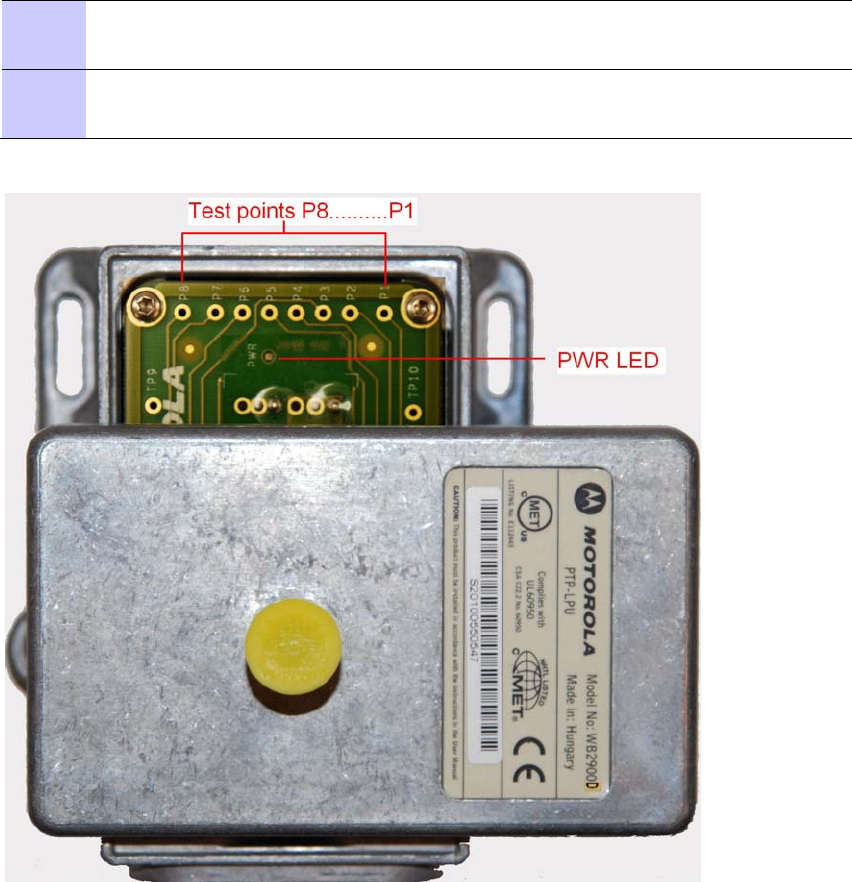
PTP 250 User Guide Testing link end har dware
phn- 2182_002v000
May 2011 8-7
5 Check that the PWR LED near the top right of the LPU PCB is
illuminated to indicate power in the Ethernet cable (Figure 8-3).
6 If any test fails, replace or repair the cable that connects the PoE power
supply to the LPU or ODU.
Figure 8 - 3 PTP LPU t est points and PWR LED

Testing link end har dware Chapt er 8 Troubleshooting
phn- 2 182_002v 000
8-8 May 2011
Test Et he r net pack et e r r ors report ed by OD U
To test for Ethernet packet errors, proceed as follows:
1 Log in to the unit and select menu option Statistics.
2 Select Reset Counters at the bottom of the page and wait until the Data
Port Rx Packets counter has reached 1 million.
3 If the counter does not increment or increments too slowly, because for
example the link is newly installed and there is no offered Ethernet
traffic, then abandon this procedure and consider using the procedure
Test ping packet loss on page 8-9.
Test Et he r net pack et e r r ors report ed by m ana ged sw it ch or
rout er
If the ODU is connected to a managed Ethernet switch or router, it may be possible to
monitor the error rate of Ethernet packets. Please refer to the user guide of the
managed network equipment.
The test has passed if the rate of packet errors reported by the managed Ethernet
switch or router is less than 10 in 1 million packets.

PTP 250 User Guide Testing link end har dware
phn- 2182_002v000
May 2011 8-9
Test ping pa cket loss
Using a computer, it is possible to generate and monitor packets lost between the PoE
power supply and the ODU. This can be achieved by executing the Command Prompt
application which is supplied as standard with Windows and Max OS X operating
systems.
To test ping packet loss, proceed as follows:
1 Ensure that the IP address of the computer is configured appropriately for
connection to the ODU under test, and does not clash with the IP addresses
of other devices connected to the network.
2 If the PoE power supply is connected to an Ethernet switch or router then
connect the computer to a spare port, if available.
3 If it is not possible to connect the computer to a spare port of an Ethernet
switch or router, then the PoE power supply will need to be disconnected
from the network in order to execute this test.
CAUTION
The following steps will disrupt network traffic carried by the ODU
under test:
Disconnect the PoE power supply from the network.
Connect the computer directly to the LAN port of the PoE power supply.
4 On the computer, open the Command Prompt application.
5 Send 1000 ping packets of length 1500 bytes. The process will take 1000
seconds, which is approximately 17 minutes.
If the computer is running a Windows operating system, this is achieved by
typing:
ping –n 1000 –l 1500 <ipaddress>
where <ipaddress> is the IP address of the ODU under test.
If the computer is running a MAC operating system, this is achieved by
typing:
ping –c 1000 –s 1492 <ipaddress>
where <ipaddress> is the IP address of the ODU under test.
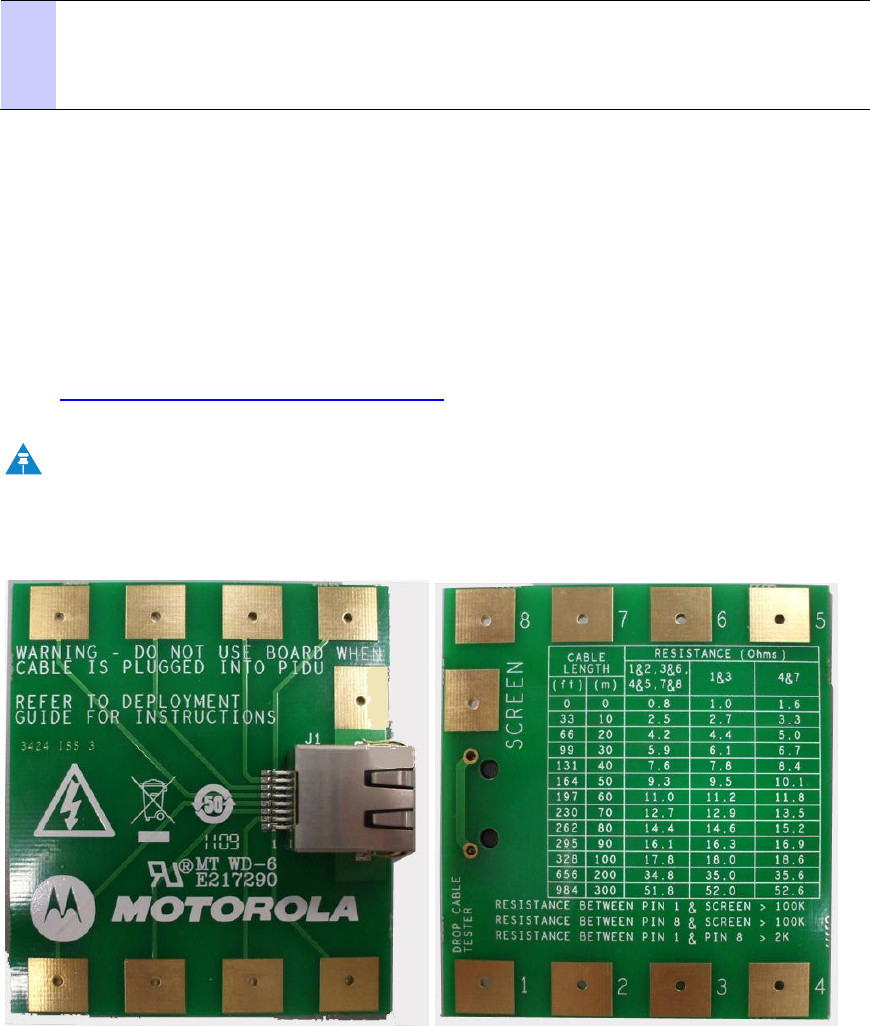
Testing link end har dware Chapt er 8 Troubleshooting
phn- 2 182_002v 000
8-10 May 2011
6 Record how many Ping packets have been lost. This is reported by Command
Prompt on completion of the test.
The test has passed if the number of lost packets is less than 2.
Test resist a nce a t t he PoE e nd of t he drop cable
If the above procedures fail to diagnose the issue, there may be a fault in the wiring of
the drop cable that connects the ODU (or LPU) to the PoE power supply. Perform this
task to test the resistances between the RJ45 pins.
Use the PTP drop cable tester (Figure 8-4) to make testing easier. This can be ordered
from http://www.motorola.com/ptp/support by selecting Order Cable Tester and
completing the order form.
NOTE
The values printed on the PTP drop cable tester do not apply to the PTP 250.
Figure 8 - 4 Drop cable test er ( front and back views)
Unplug the drop cable from the DATA & POWER OUT port of the PoE power supply.
Connect the drop cable tester to the end of the drop cable. Then, perform the tests
described in Table 8-1. Record the results in the Result column, if this is helpful.

PTP 250 User Guide Testing link end har dware
phn- 2182_002v000
May 2011 8-11
Table 8 - 1 RJ45 cable resist ance test s at the PoE power supply end
St ep Test Resu lt
1 Measure the resistance between pins 1 and 2. Ohms
2 Measure the resistance between pins 3 and 6. Ohms
3 Measure the resistance between pins 4 and 5. Ohms
4 Measure the resistance between pins 7 and 8. Ohms
5 Ensure that all the results of steps 1 to 4 are within 10%
of each other as follows:
Take the minimum result and multiply by 1.1.
If any of the remaining steps 1 to 4 results are
greater than this, the test has failed.
PASS or
FAIL
6 Measure the resistance between pins 1 and 3. Subtract
0.2 Ohms.
Ohms
7 Measure the resistance between pins 4 and 7. Subtract
0.8 Ohms.
Ohms
8 Compare the results of steps 1 to 4 and steps 6 to 7 to
the maximum allowed, that is 20 Ohms.
If any of the steps 1 to 6 results are greater than the
maximum allowed, the test has failed.
PASS or
FAIL
9 Measure the resistance between pin 1 and the screen
(ODU ground). If it is less than 100K ohms (regardless
of cable length), the test has failed.
K Ohms
PASS or
FAIL
10 Measure the resistance between pin 8 and the screen
(ODU ground). If it is less than 100K ohms (regardless
of cable length), the test has failed.
K Ohms
PASS or
FAIL
11 Measure the resistance between pin 1 and pin 8. If it is
less than 100K Ohms (regardless of cable length), the
test has failed.
K Ohms
PASS or
FAIL

Test ing t he radio link Chapt er 8 Troubleshooting
phn- 2 182_002v 000
8-12 May 2011
Te st ing t he radio link
This section describes how to test the link when there is no radio communication, or
when it is unreliable, or when the data throughput rate is too low. It may be necessary
to test the ODUs at both ends of the link.
N o activit y
If there is no wireless activity, proceed as follows:
1 Select menu option Home and check Wireless Link Status on the System
Summary page.
2 Check that the firmware at each end of the link is the same version.
3 Check Range and Transmit Power.
4 Check Master/Slave Mode for each unit and ensure that one unit is
Master and the other unit is Slave.
5 Check that the link is not obstructed or the ODU misaligned.
6 Use the Channel Status web page at each end of the link to confirm that
there is a quiet wireless channel to use. Refer to Checking channel status
on page 7-19.
7 If there are no faults found in the configuration and there is absolutely no
wireless signal, retry the installation procedure.
8 If this does not work then report a suspected ODU fault to Motorola.

PTP 250 User Guide Test ing t he radio link
phn- 2182_002v000
May 2011 8-13
Som e a ct ivit y
If there is some activity but the link is unreliable or does not achieve the data rates
required, proceed as follows:
1 Use the Channel Status web page to check if a quieter channel is available
and is enabled. Refer to Checking channel status on page 7-19.
2 Use the Diagnostics Plotter to check that reported Link Loss is low
enough to allow the communication rates required. Refer to Using the
diagnostics plotter on page 7-21.
3 Check that the ODU has not become misaligned.
4 Use the Retry Histogram to check the number of retries. An excessive
number of retries (>10%) could indicate a problem. Refer to Checking the
retry histogram on page 7-20.
5 Use the Diagnostics Plotter to check reported Receive Power at either end
of the link. Ensure that this matches the predicted value from
LINKPlanner. Refer to Using the diagnostics plotter on page 7-21.
Test ing t he radio link Chapt er 8 Troubleshooting
phn- 2 182_002v 000
8-14 May 2011

Glossa ry
phn- 2182_002v000
May 2011 I
Glossary
. . . . . . . . . . . . . . . . . . . . . . . . . . . . . . . . . . . . . . . . . . . . . . . . . . . . . . . . . . . .
.
.
.
.
Ter m De finition
ARP Address Resolution Protocol
ATPC Automatic Transmit Power Control
BPSK Binary Phase Shift Keying
CAC Channel Availability Check
CSP Critical Security Parameter
DC Direct Current
DER Distinguished Encoding Rules
DFS Dynamic Frequency Selection
EIRP Equivalent Isotropic Radiated Power
ETSI European Telecommunications Standards Institute
FAQ Frequently Asked Question
FIPS Federal Information Processing Standard
HTTP Hypertext Transfer Protocol
ID Identity
IEEE Institute of Electrical and Electronic Engineers
IP Internet Protocol
ISM Industrial Scientific and Medical
ITPE Initial Transmit Power Estimate
LAN Local Area Network
LOS Line-of-Sight (clear line-of-sight, and Fresnel zone is clear)
LPU Lightning Protection Unit
MAC Medium Access Control Layer

Test ing t he radio link Chapt er 8 Troubleshooting
phn- 2 182_002v 000
I I May 2011
Ter m De finition
MDI Medium Dependent Interface
MDIX Medium Dependent Interface Crossover
MIB Management Information Base
NLOS Non-Line-of-Sight
NMEA National Marine Electronics Association
NTP Network Time Protocol
ODU Outdoor Unit
OFDM Orthogonal Frequency Division Multiplex
PC IBM Compatible Personal Computer
PoE Power over Ethernet
PING ICMP Echo Request
PTP Point-to-Point
QAM Quadrature Amplitude Modulation
RAM Random Access Memory
RF Radio Frequency
RSSI Received Signal Strength Indication
SELV Safety Extra Low Voltage
SMTP Simple Mail Transport Protocol
SNMP Simple Network Management Protocol
STP Shielded Twisted Pair
STP Spanning Tree Protocol
TCP Transmission Control Protocol
TDD Time Division Duplexing
URL Universal Resource Location
UTP Unshielded Twisted Pair
UV Ultraviolet
VLAN Virtual Local Area Network
